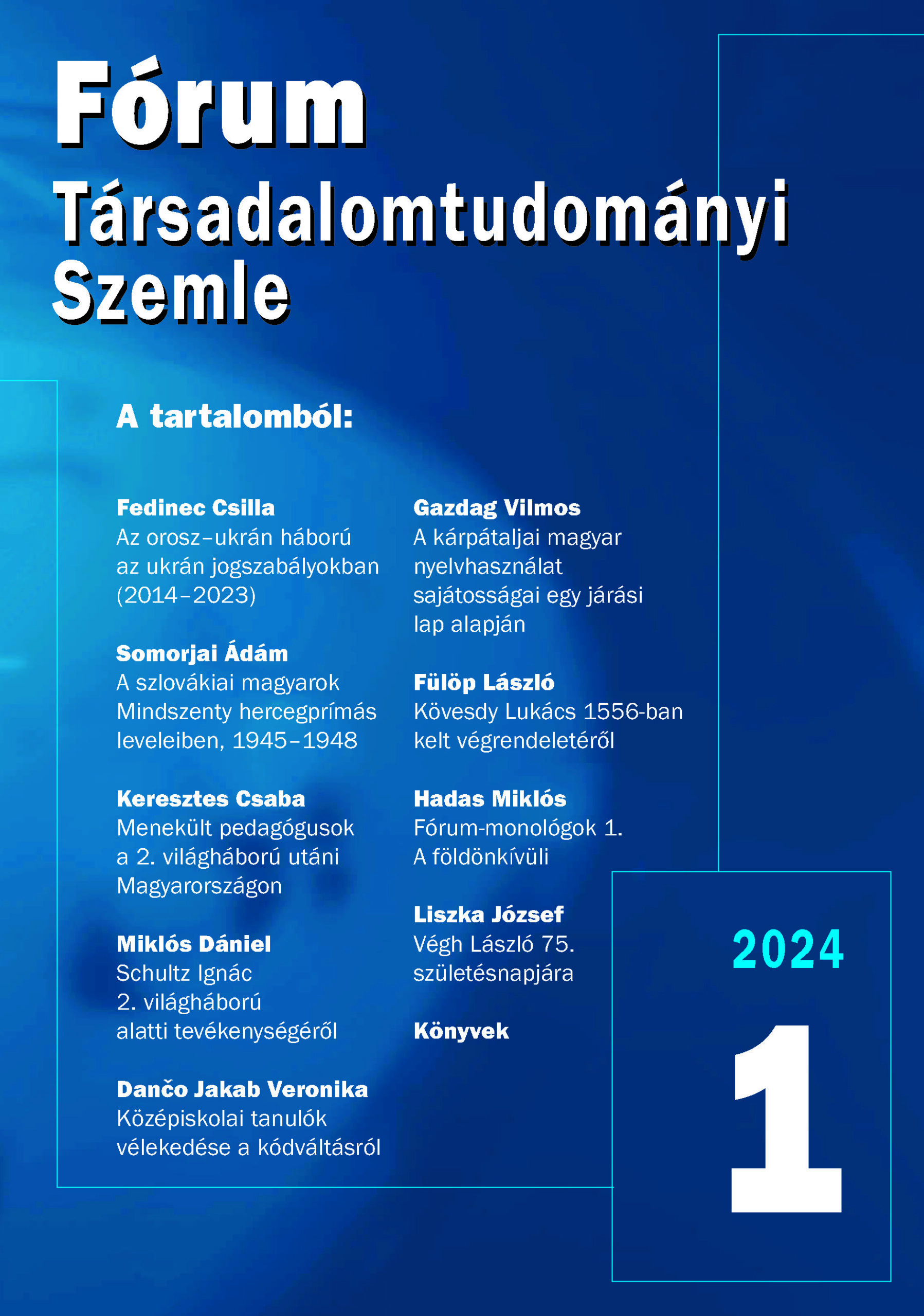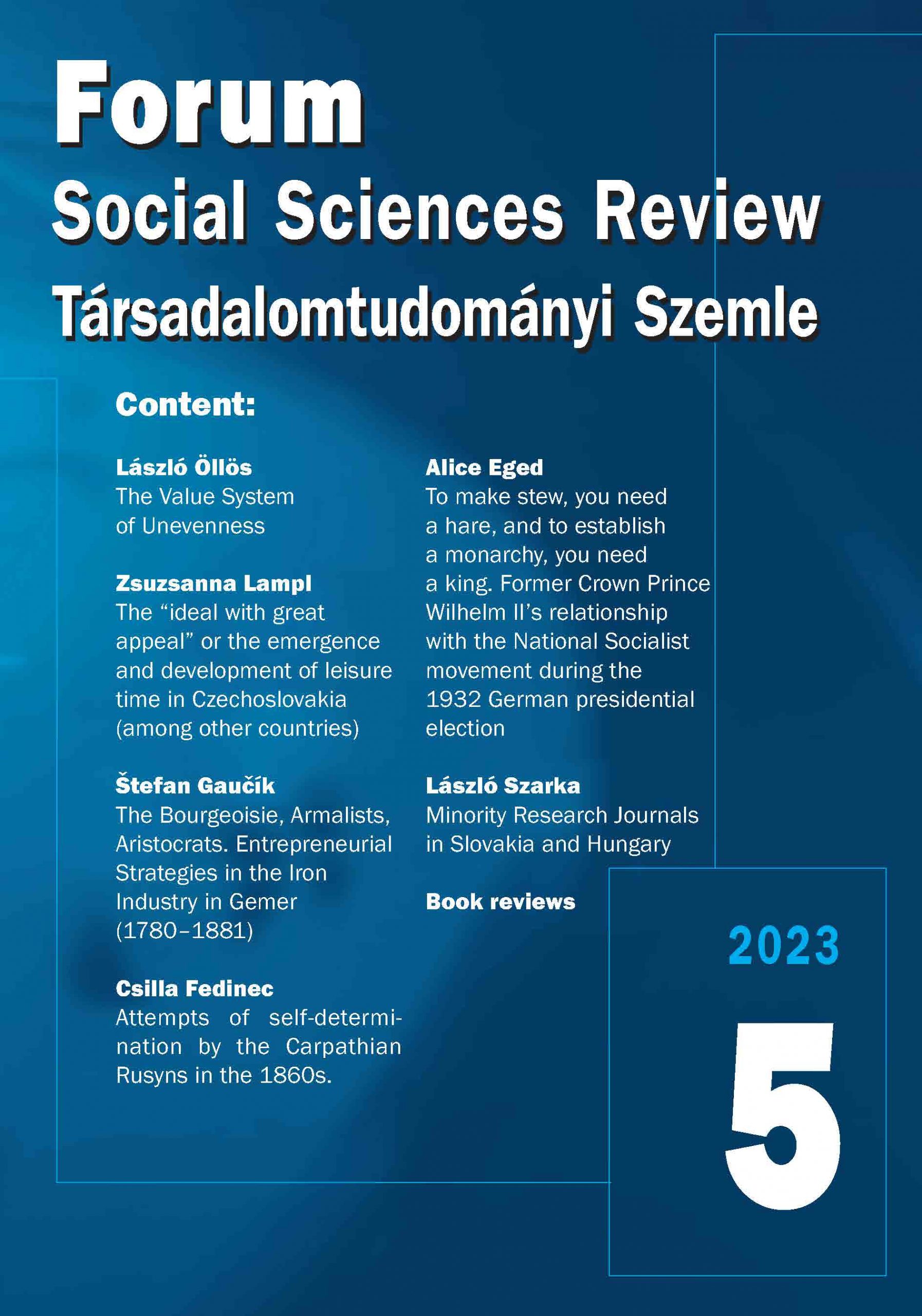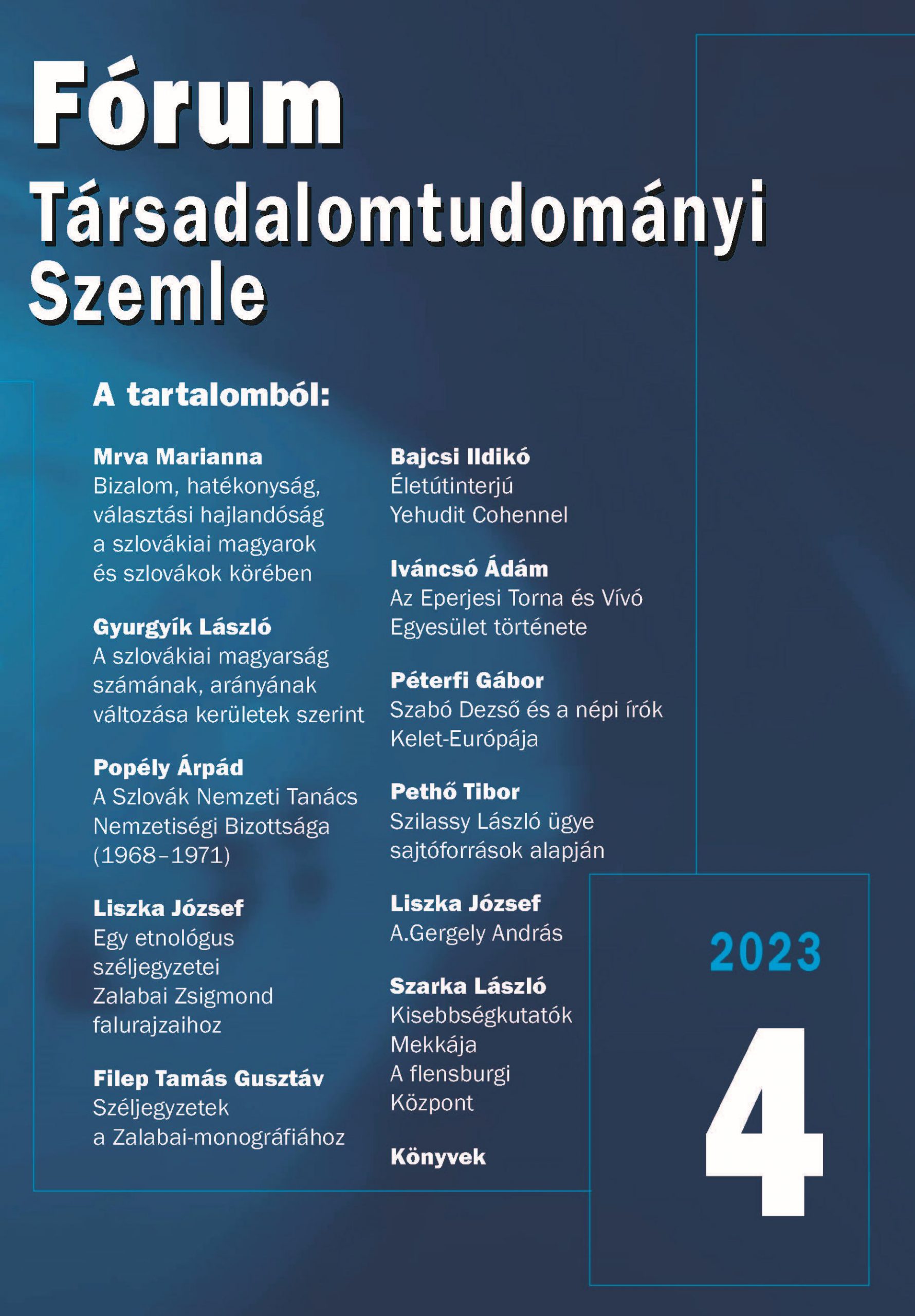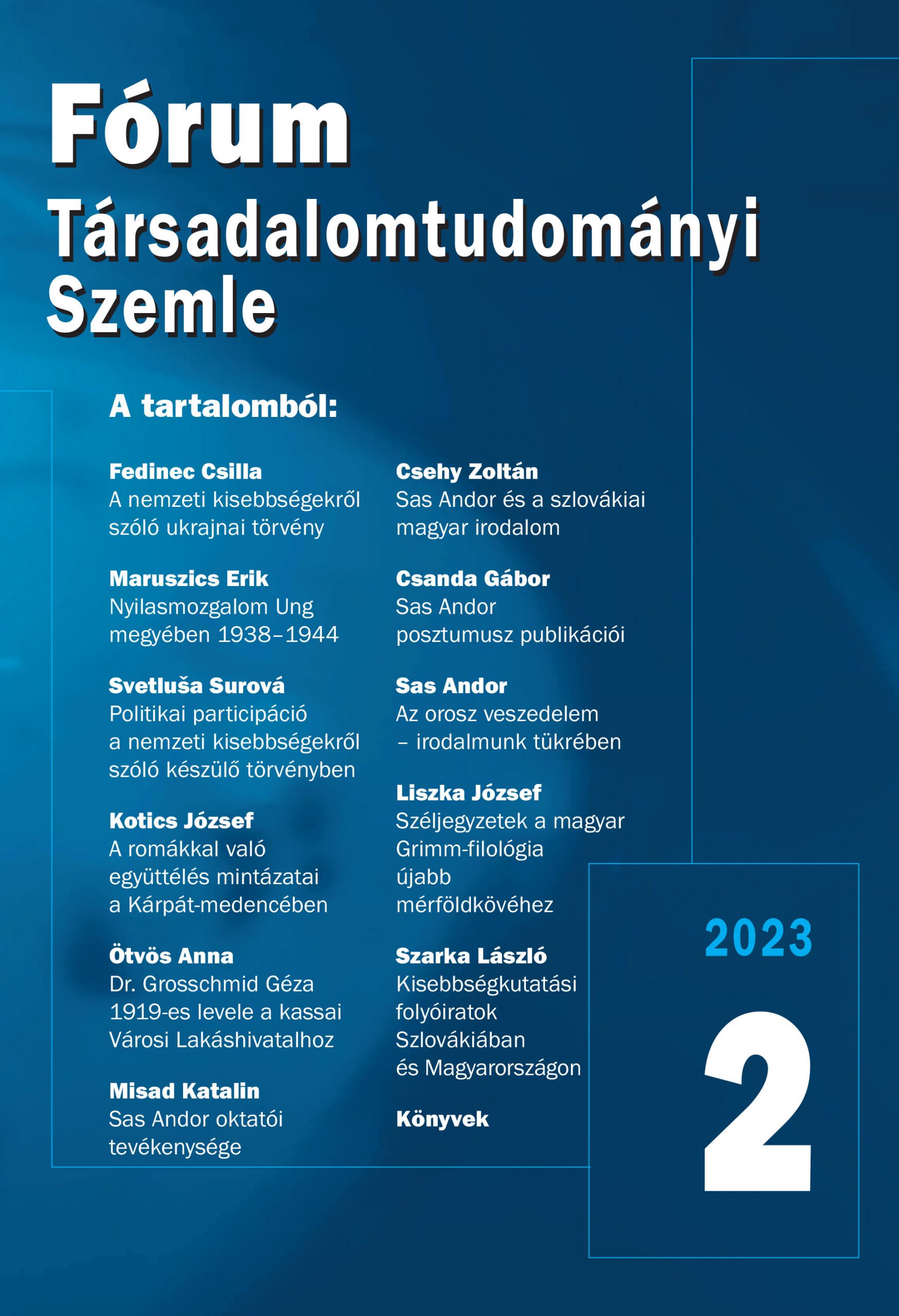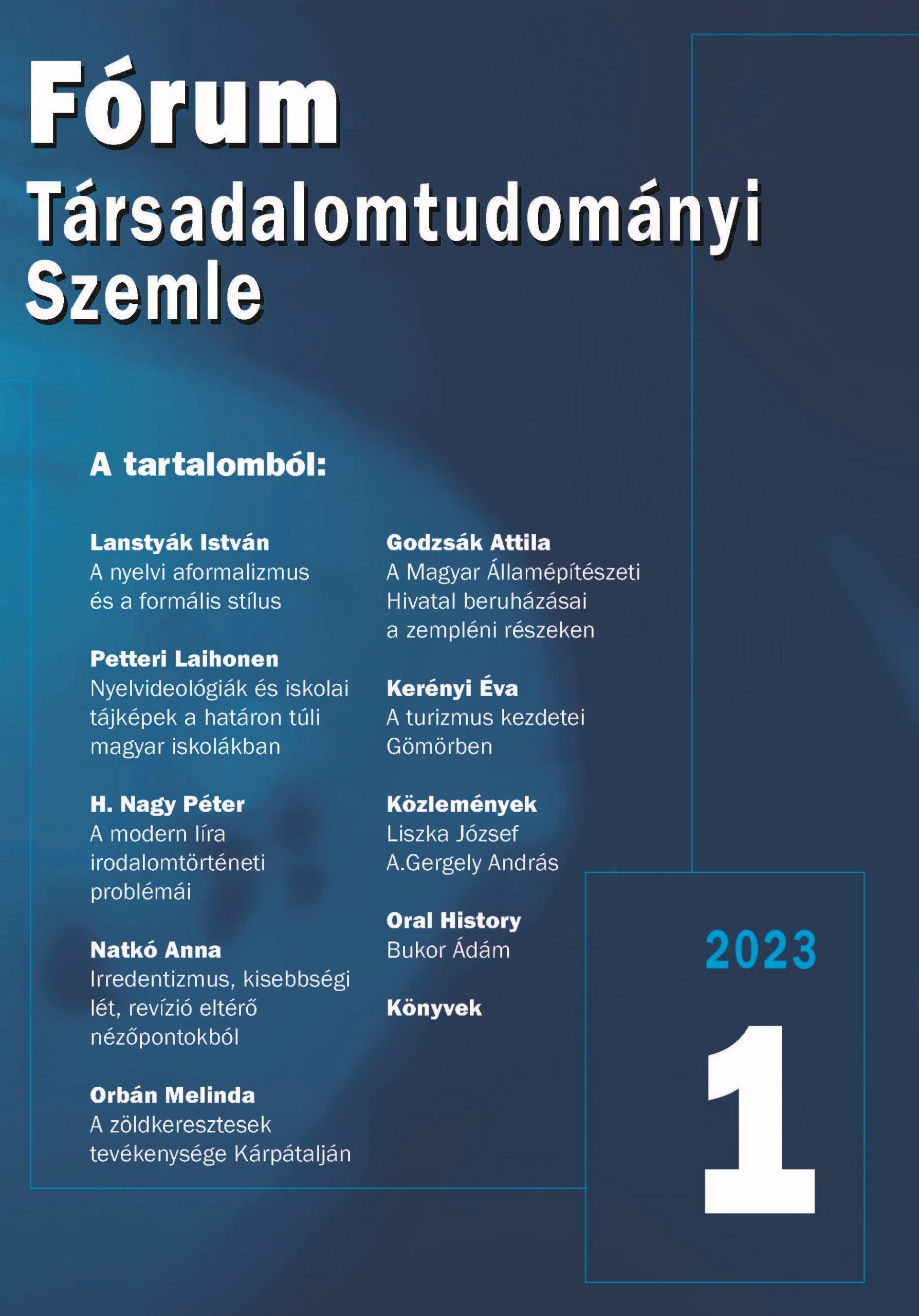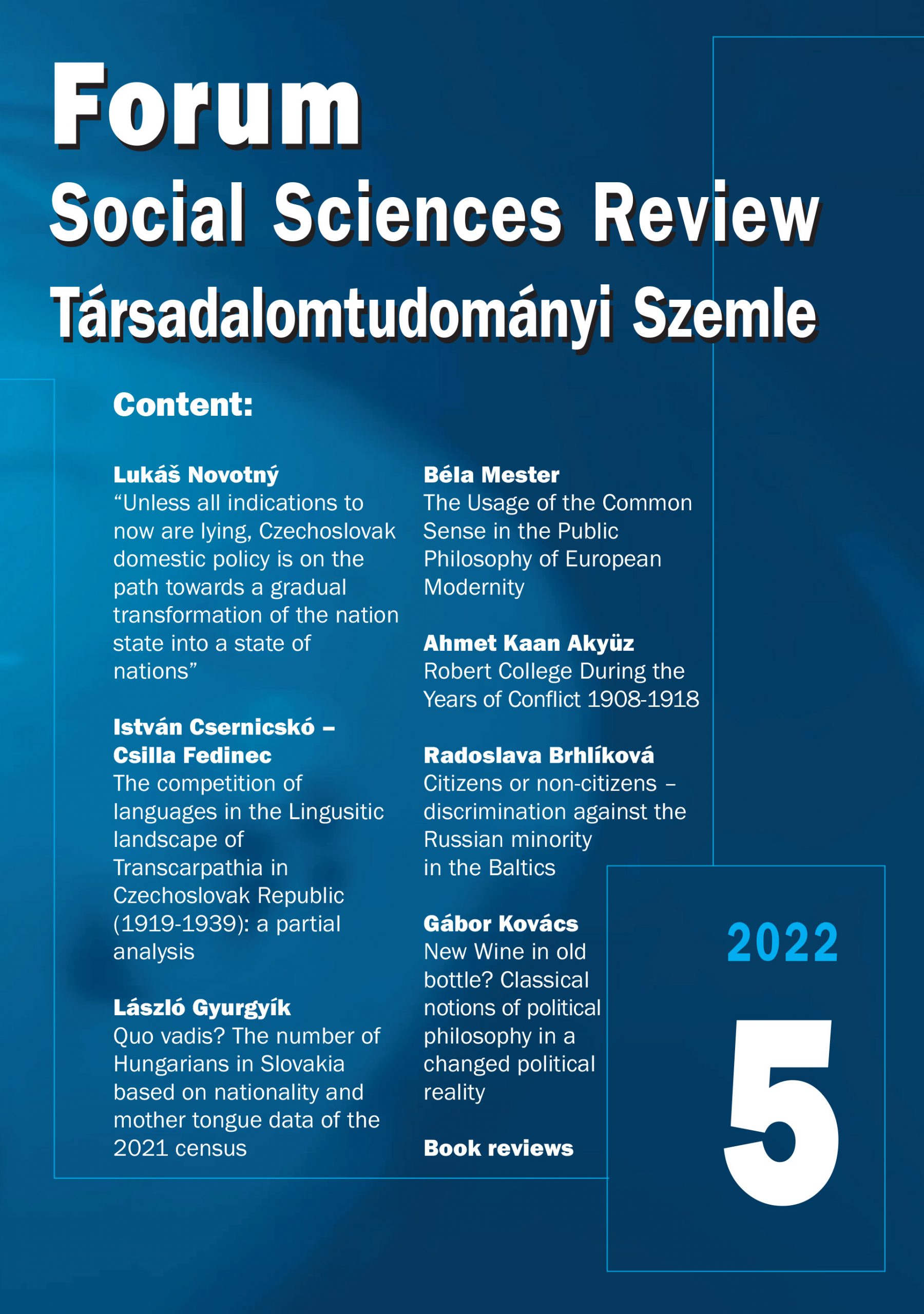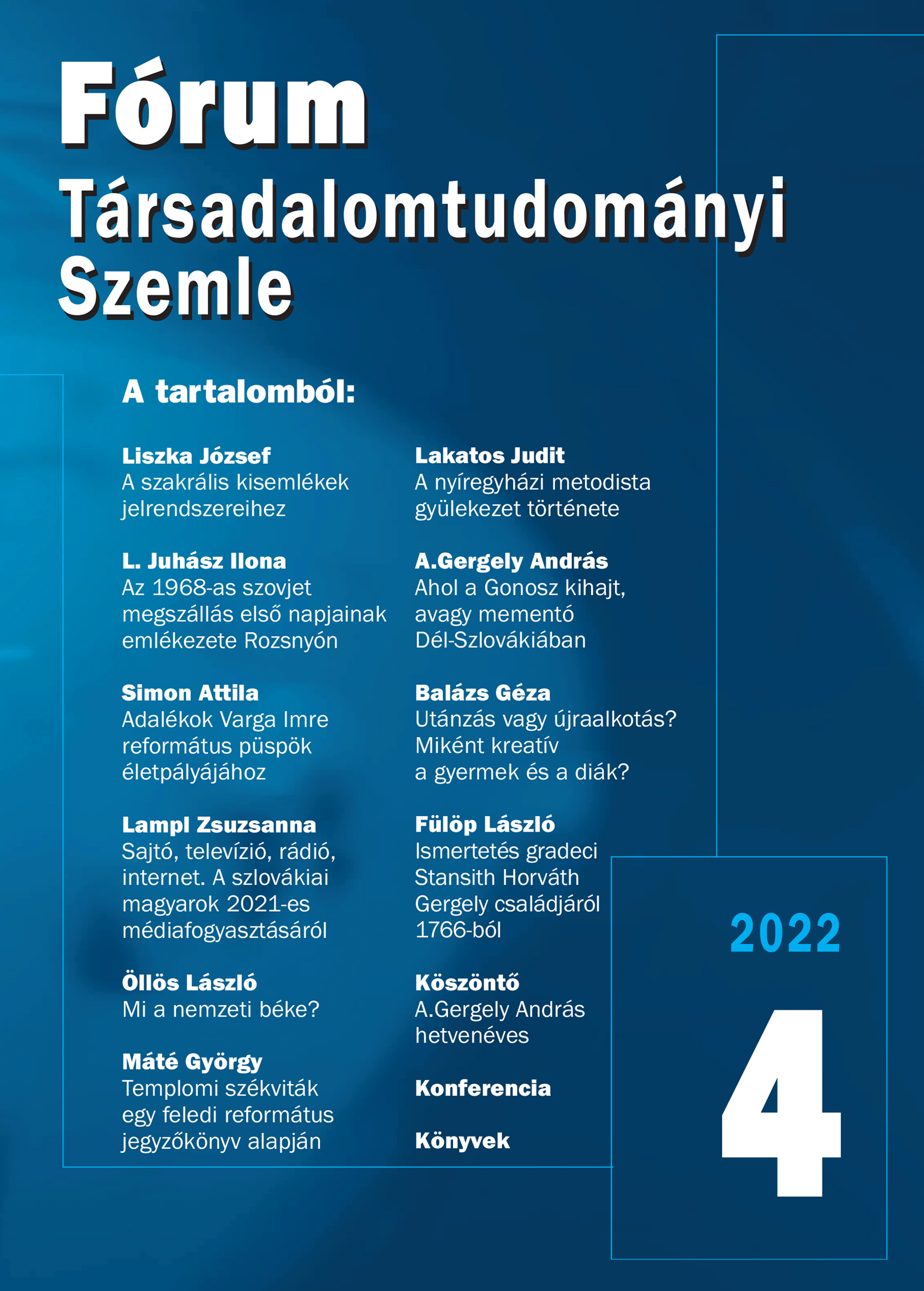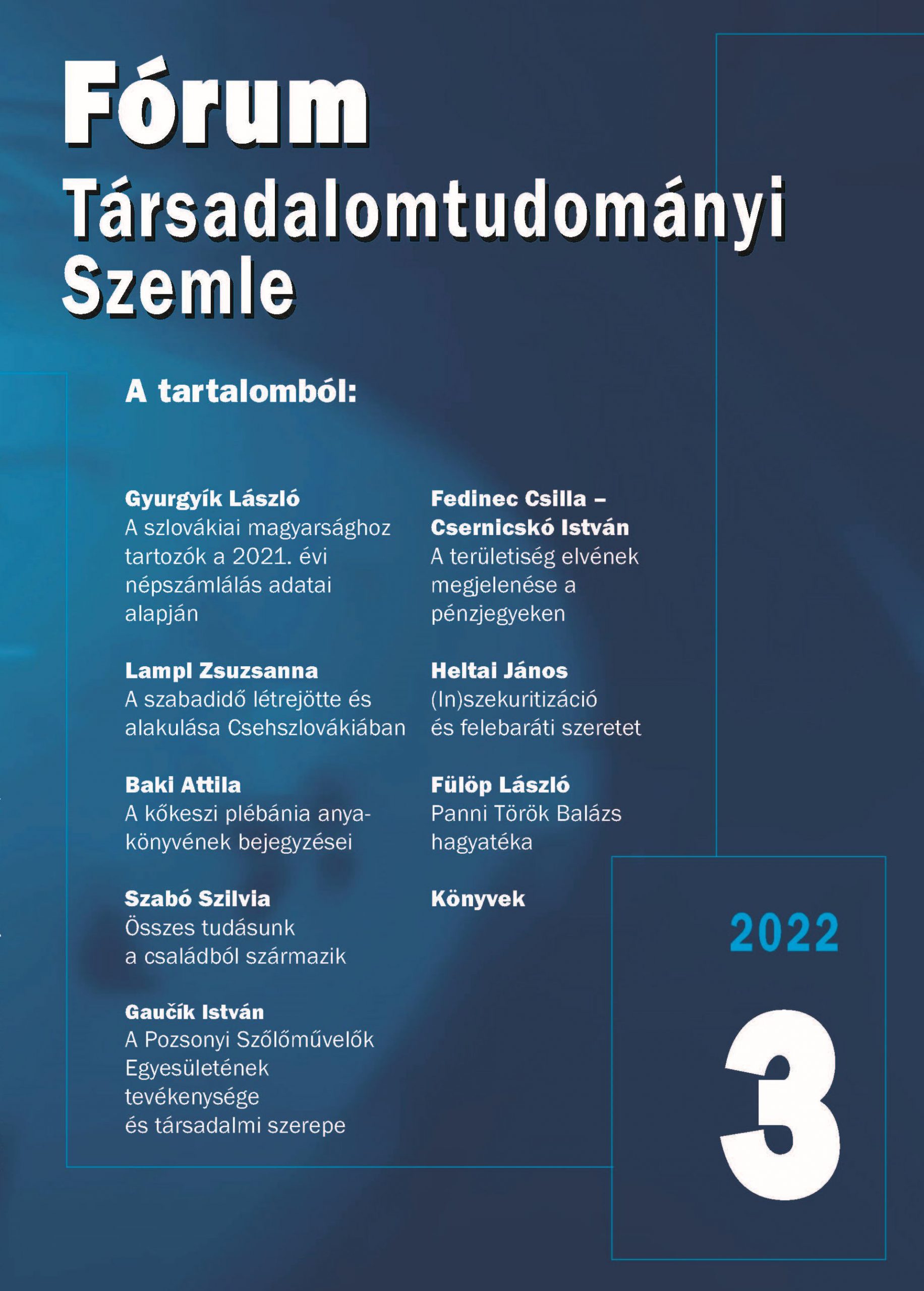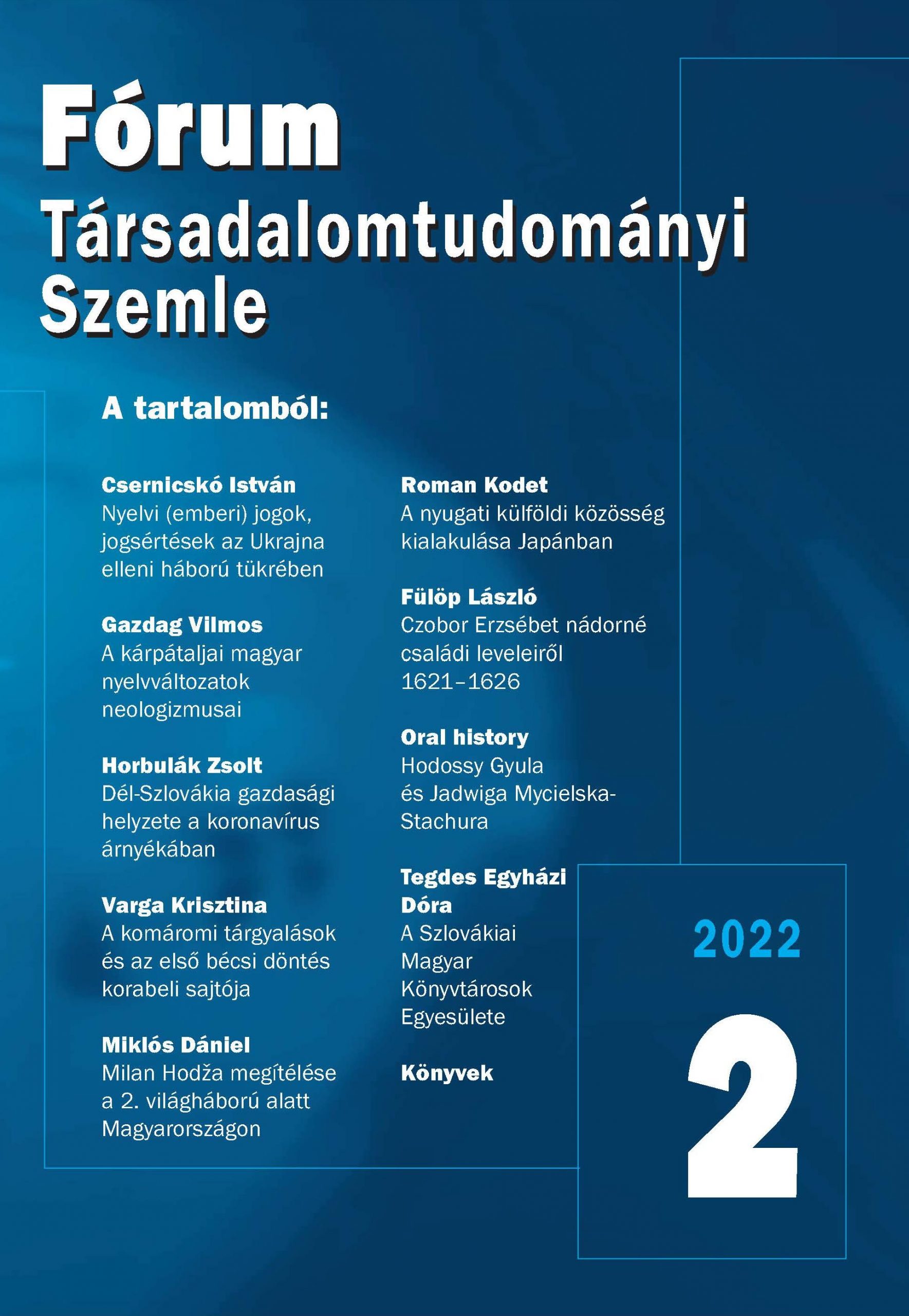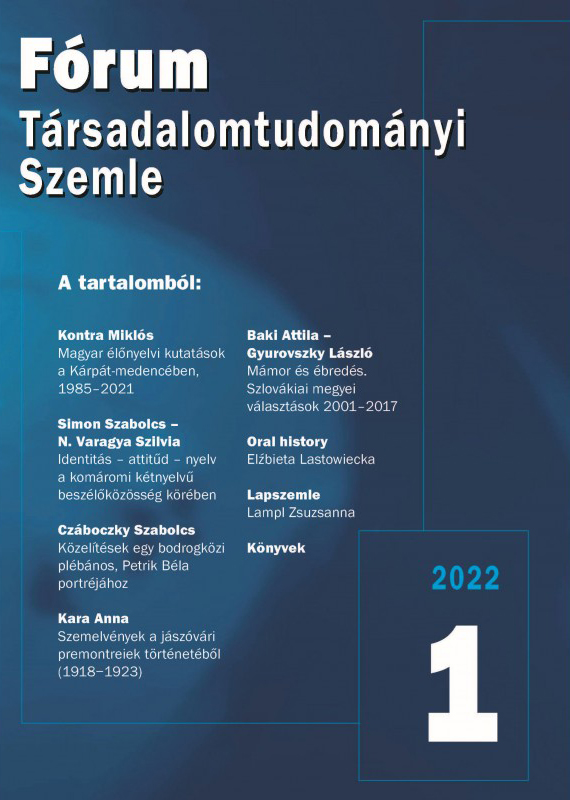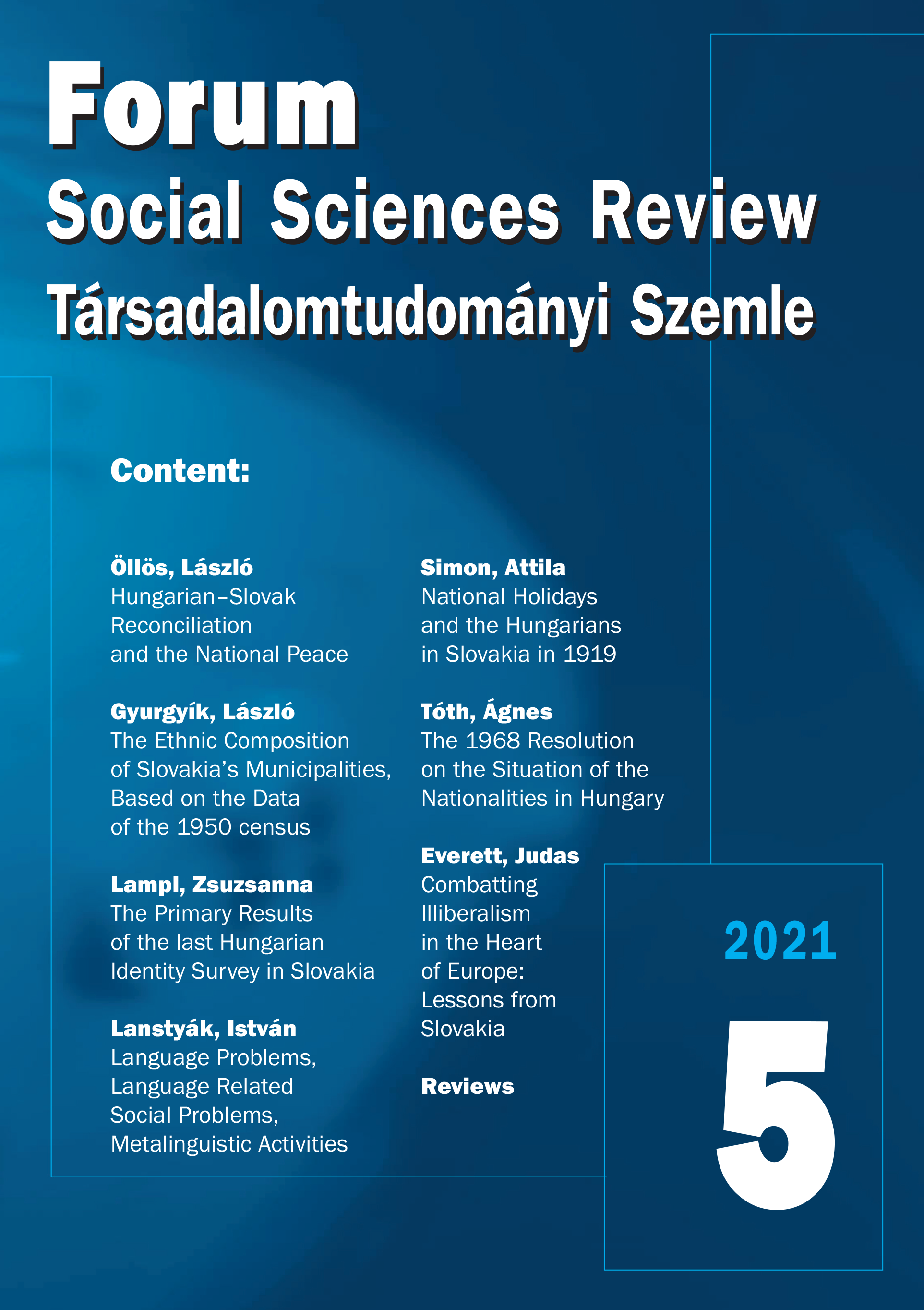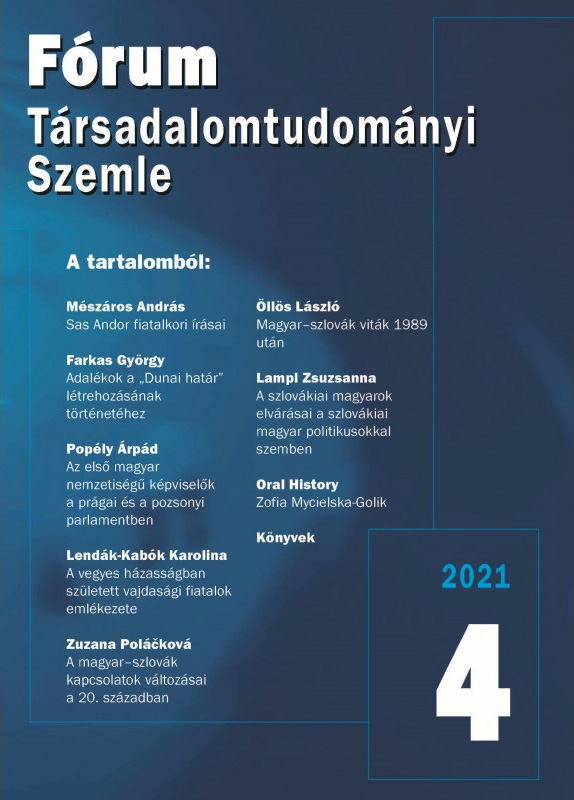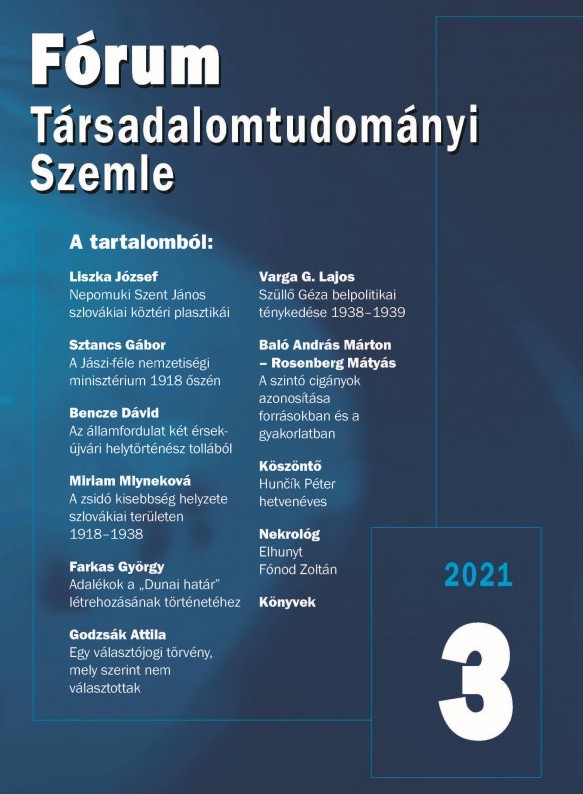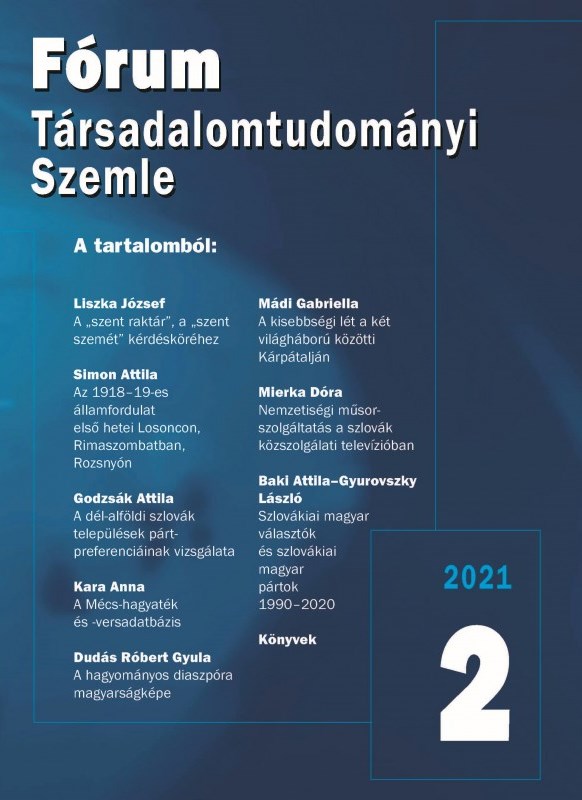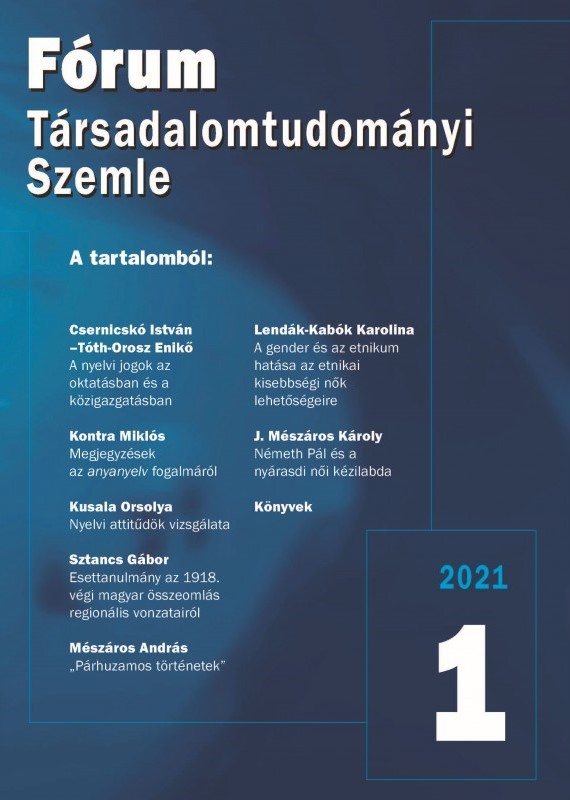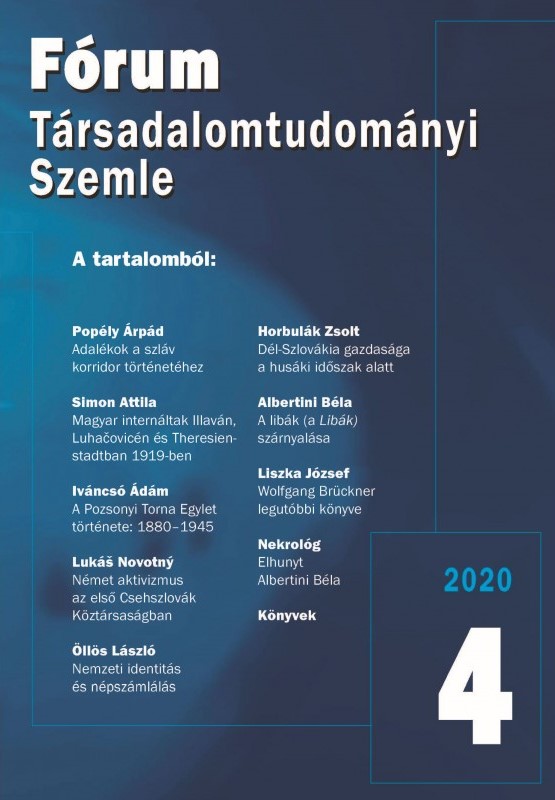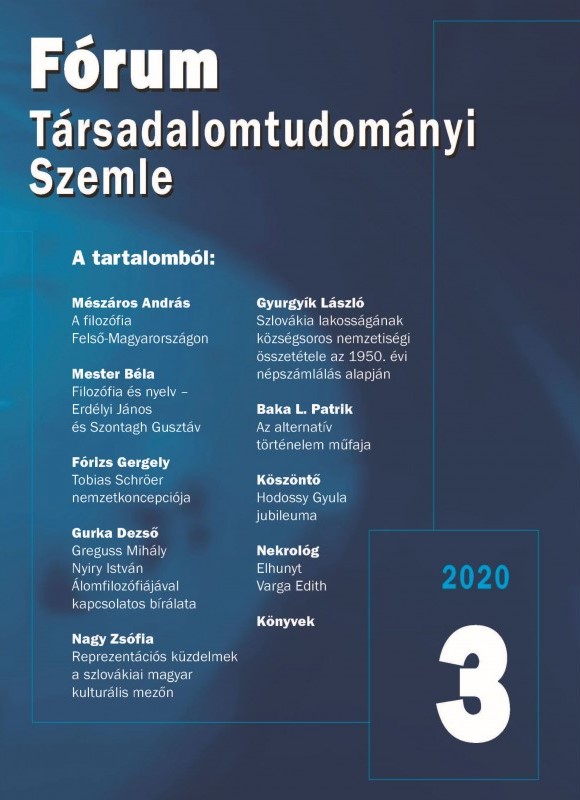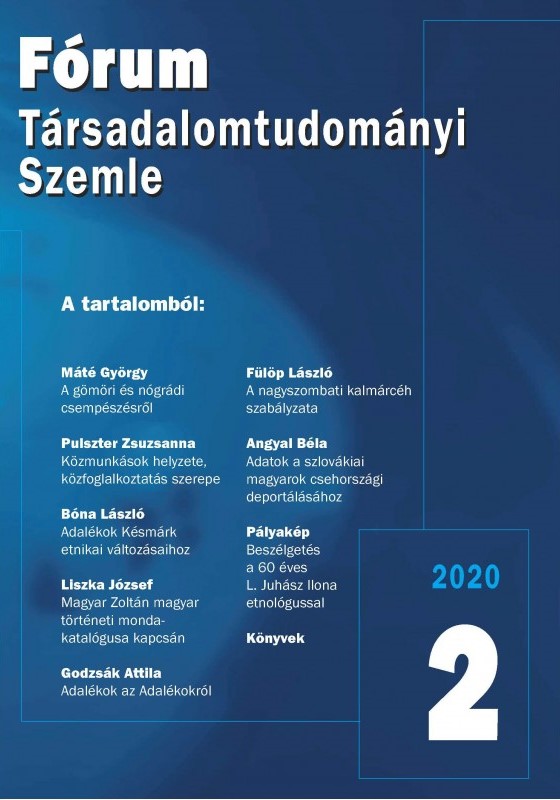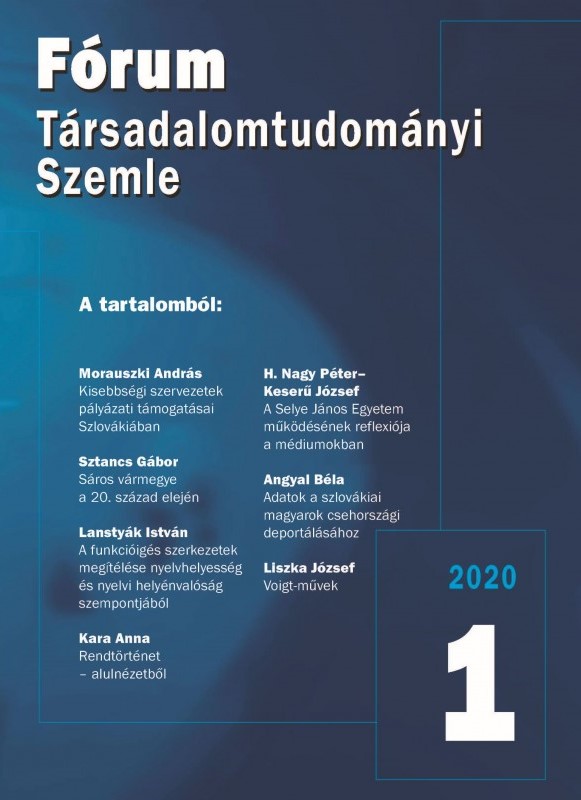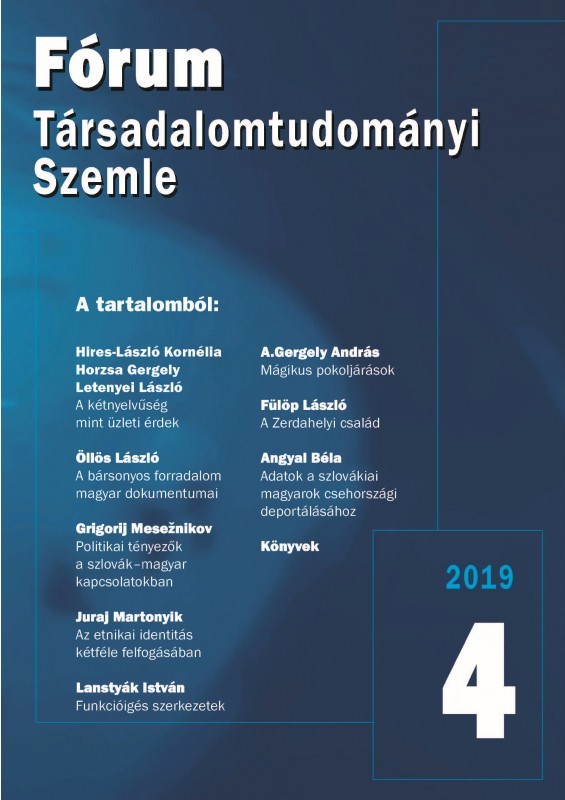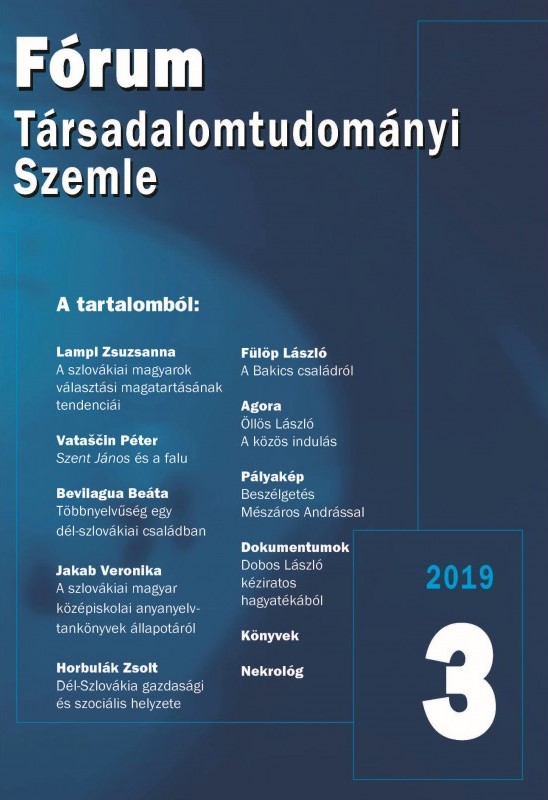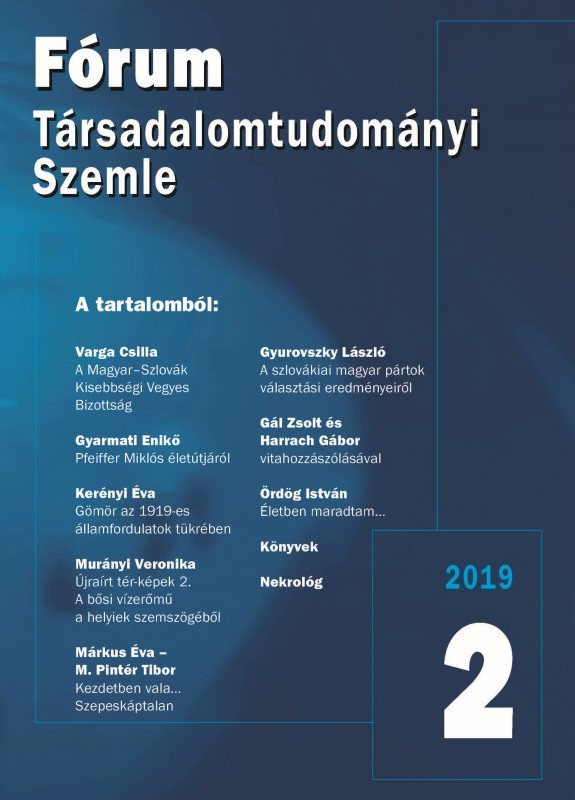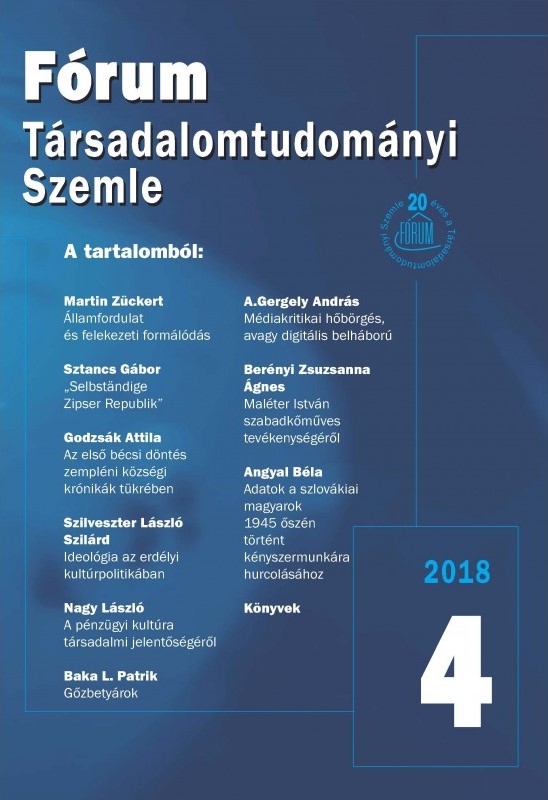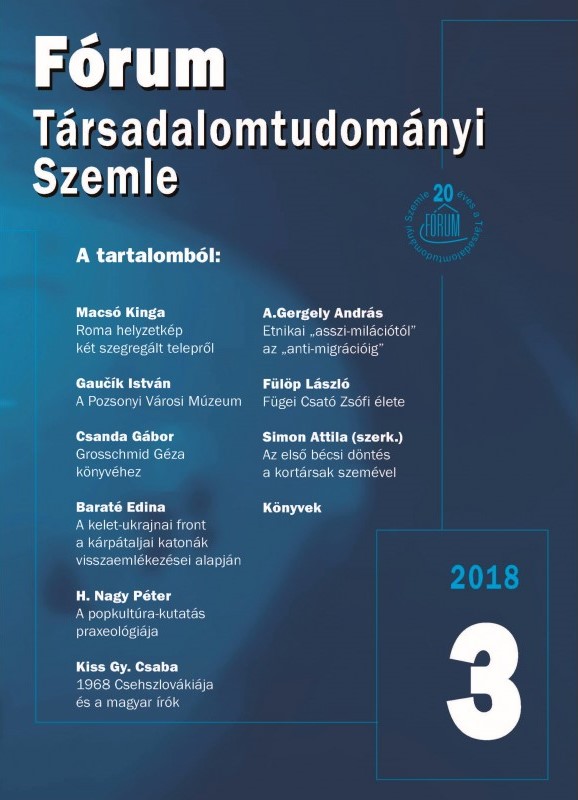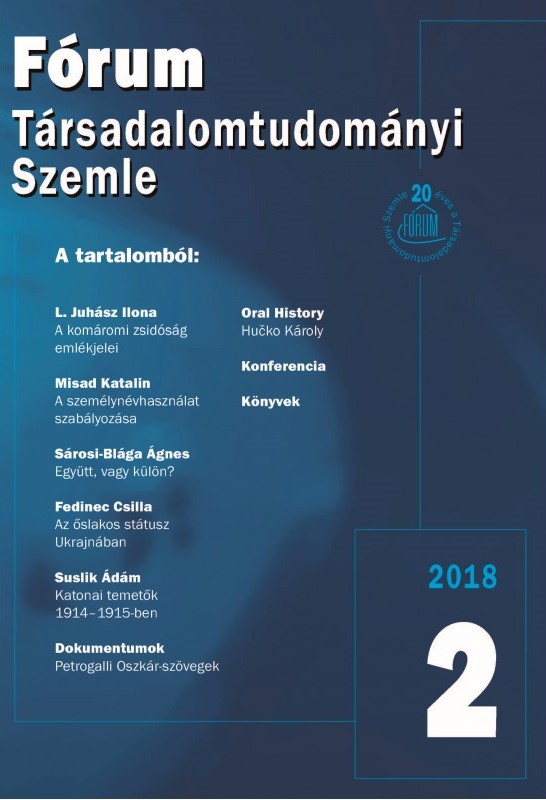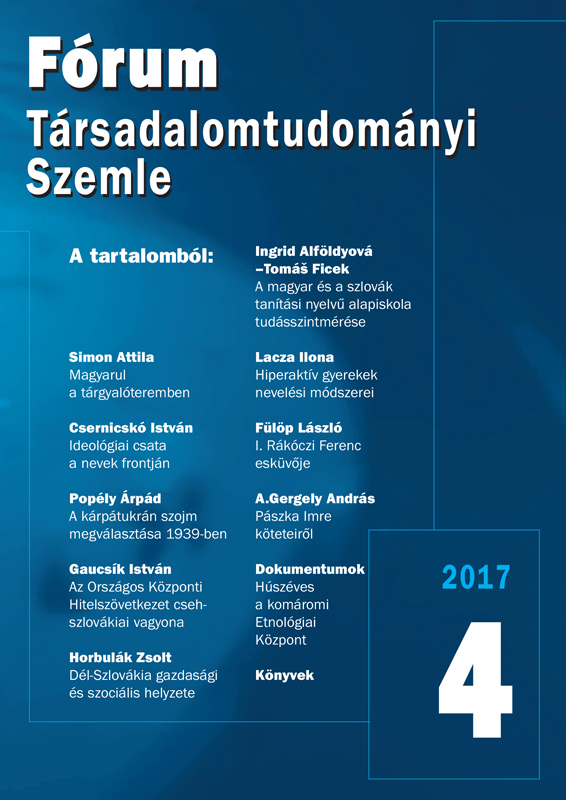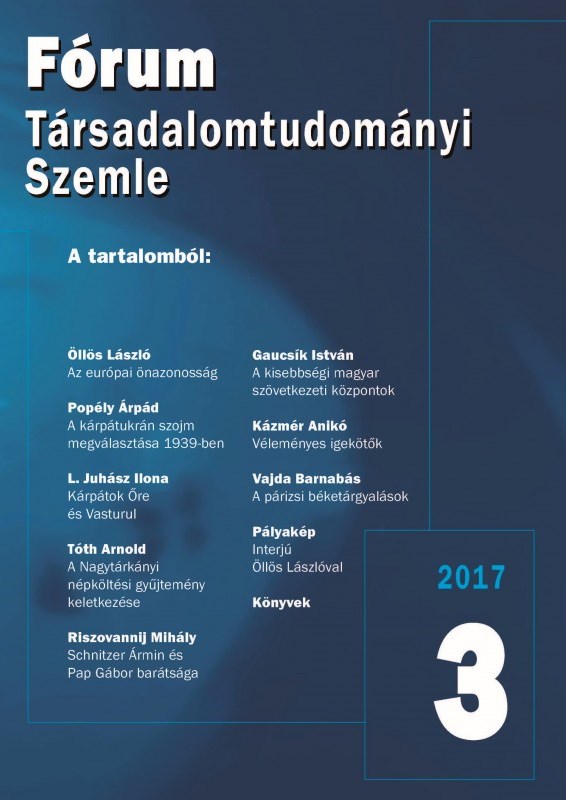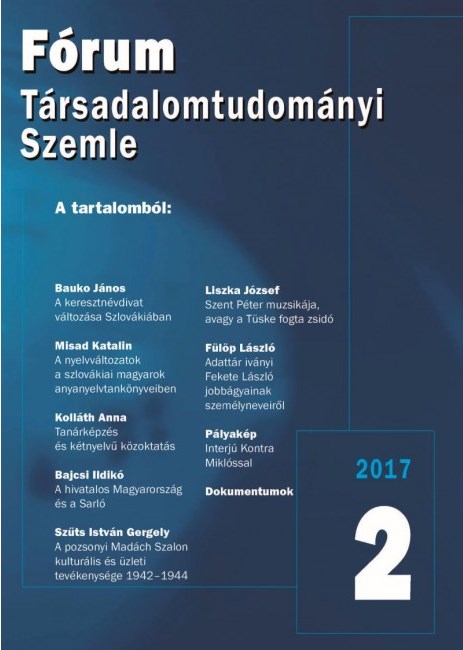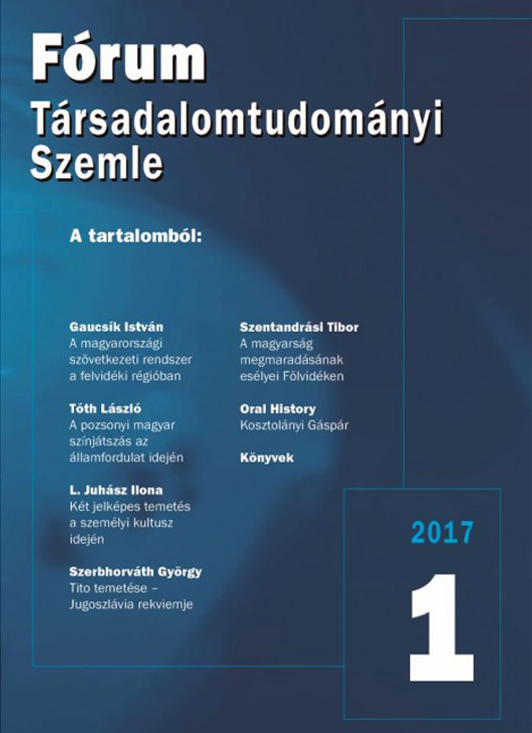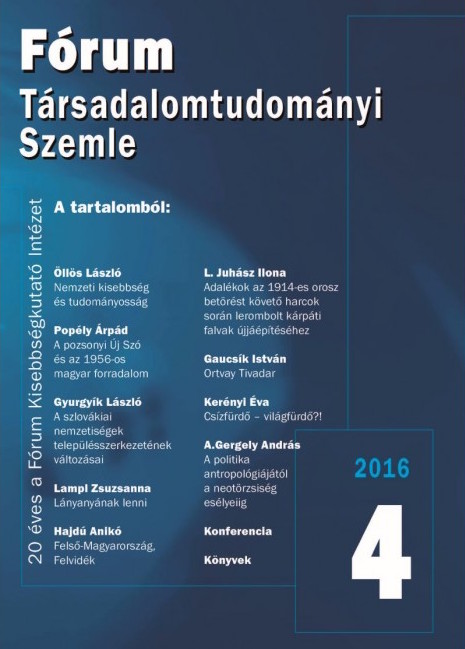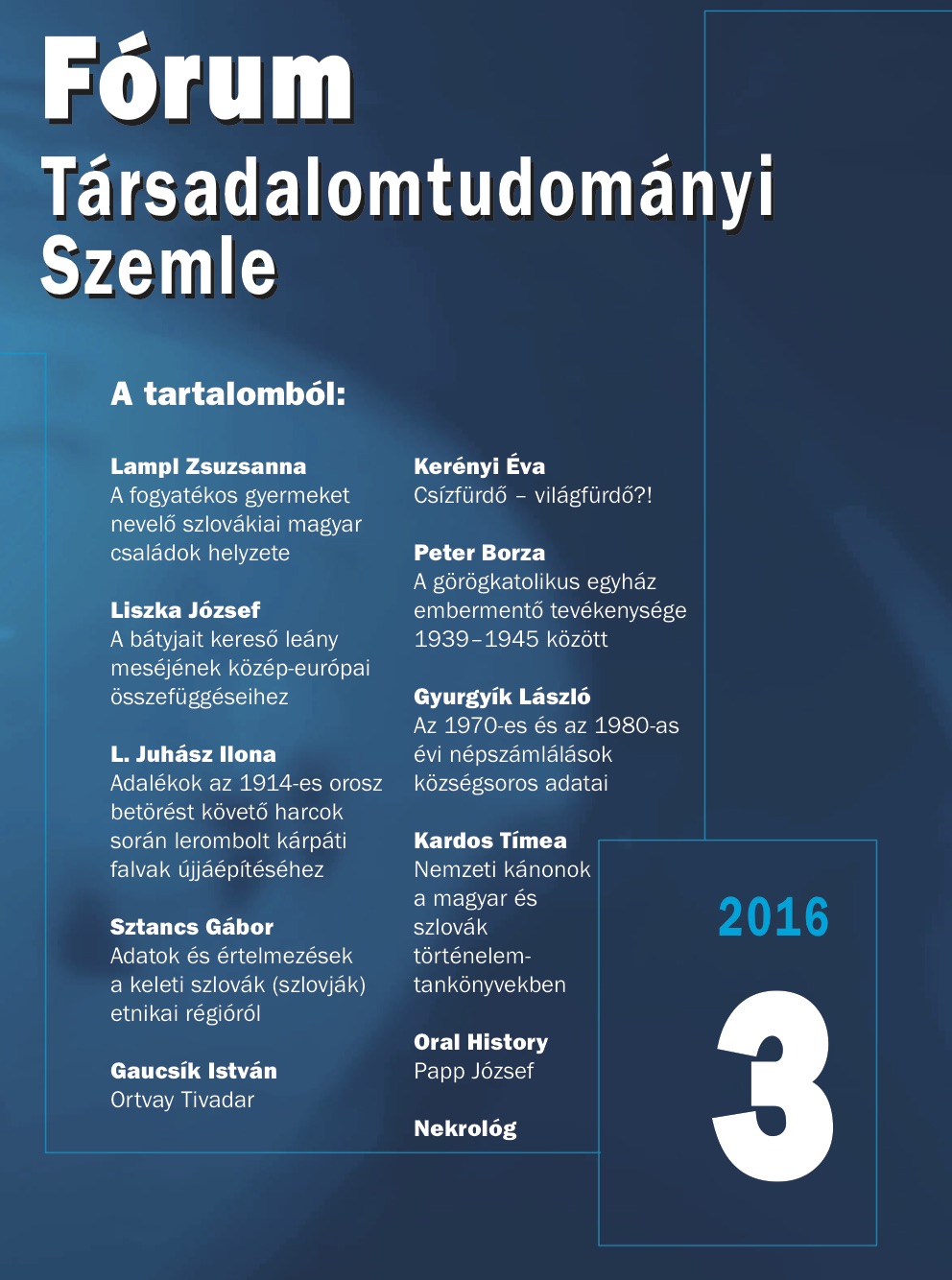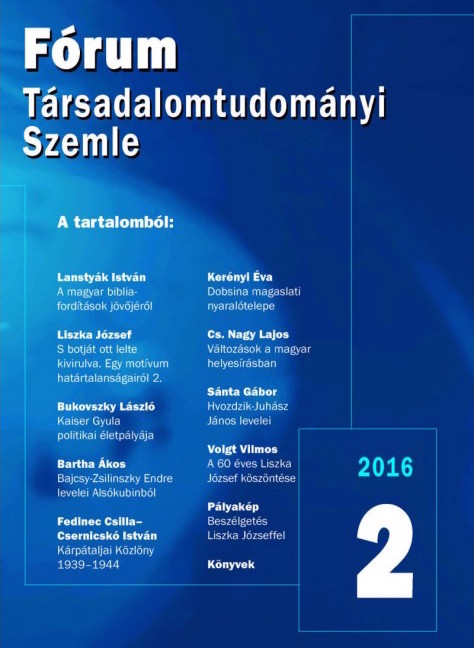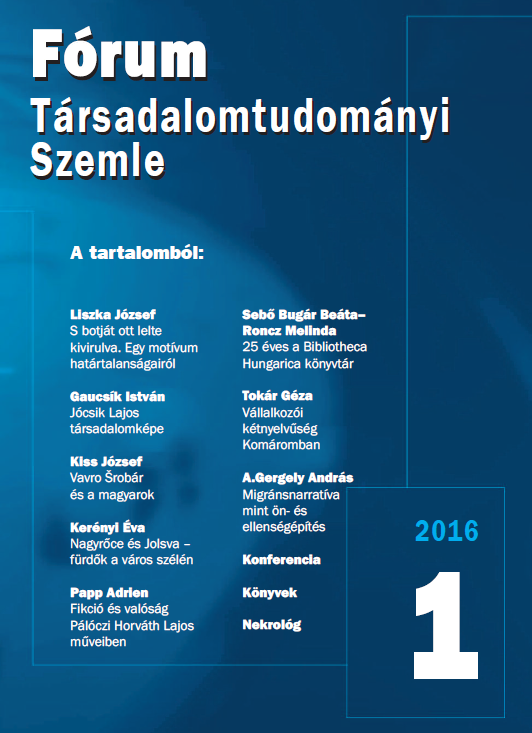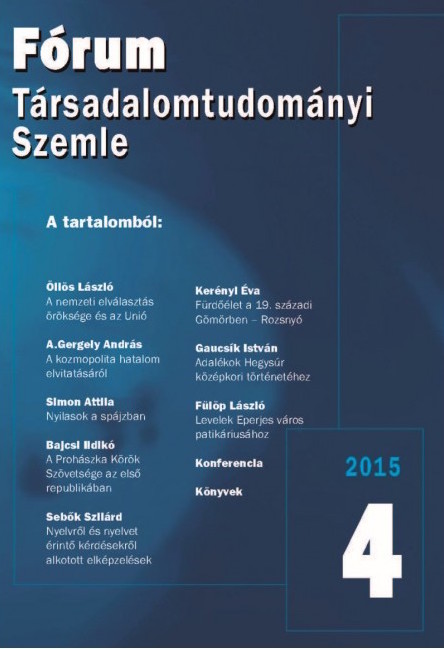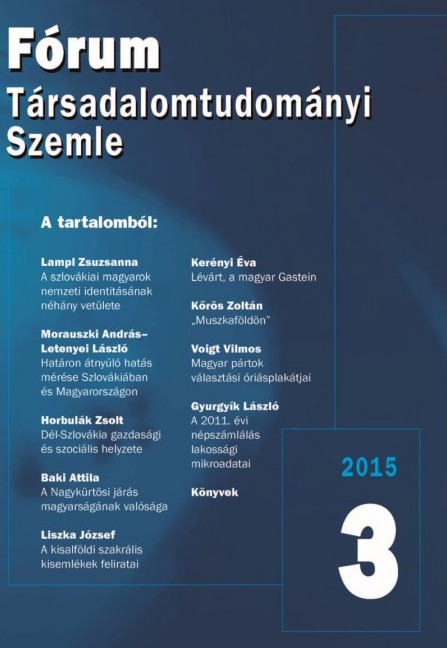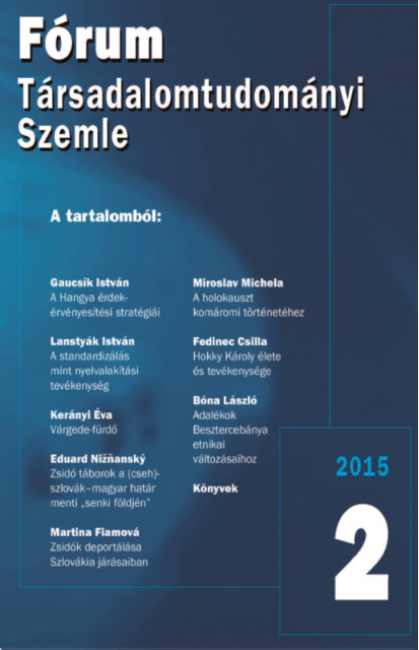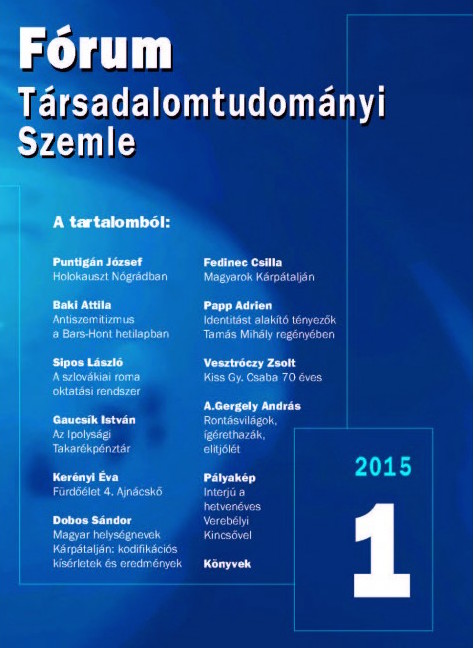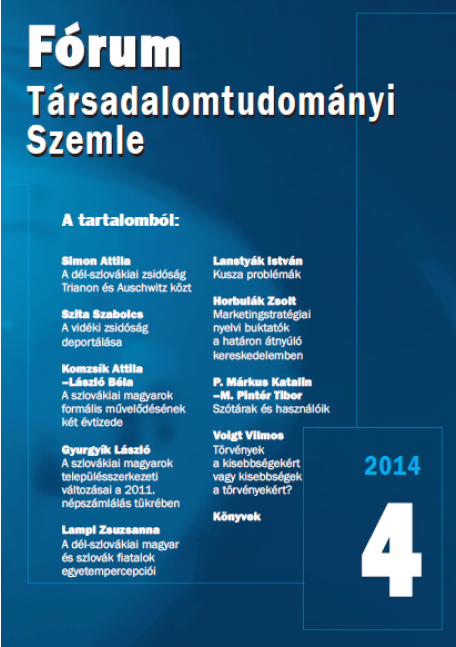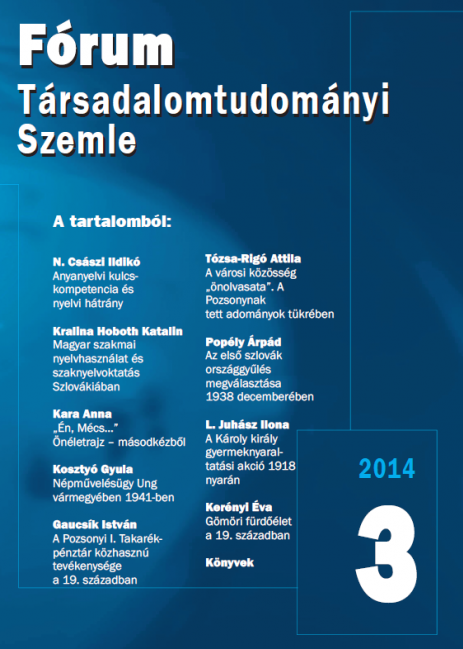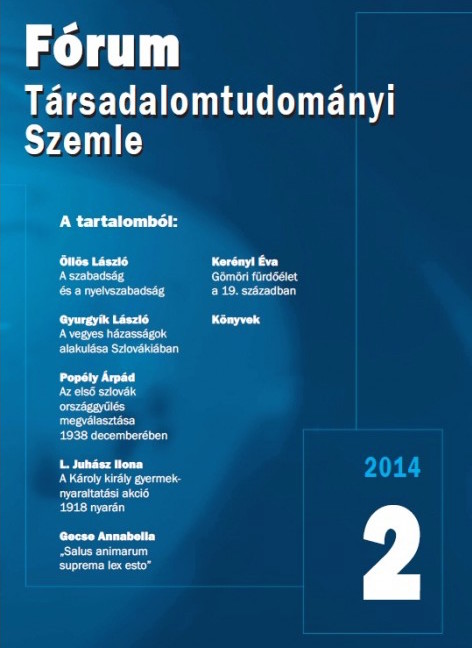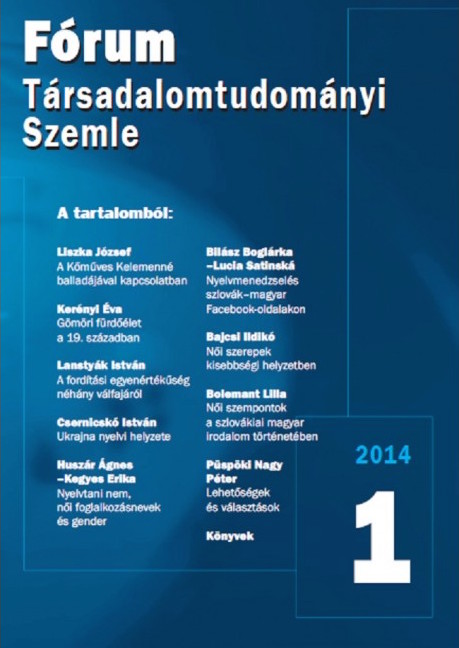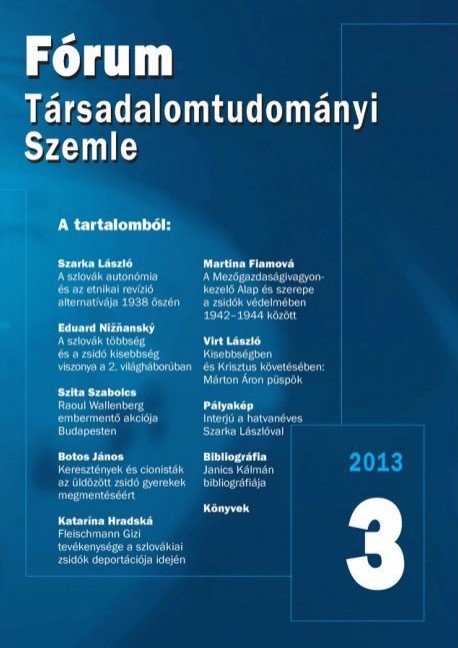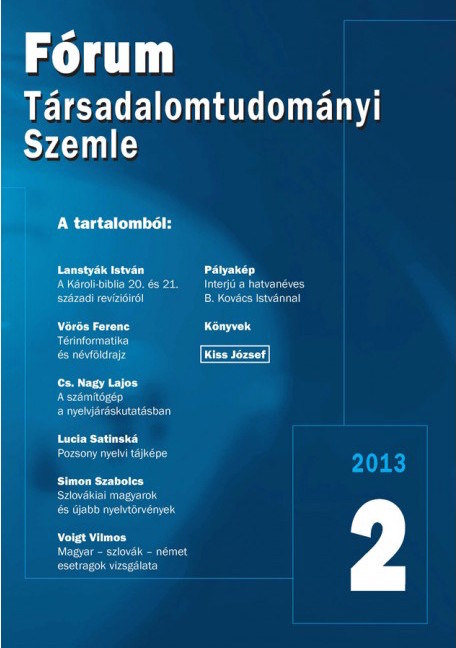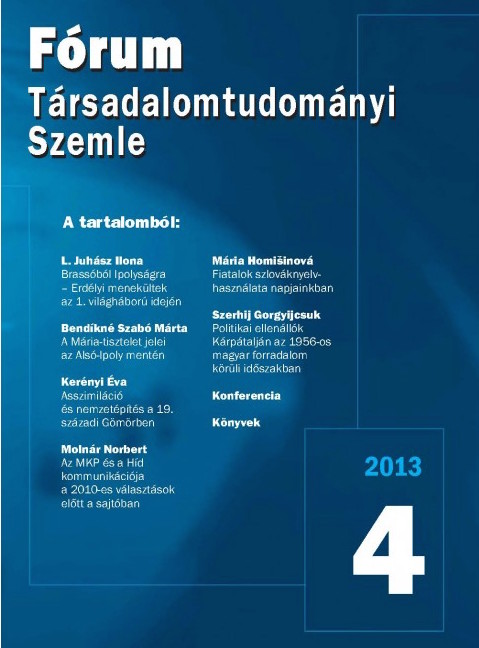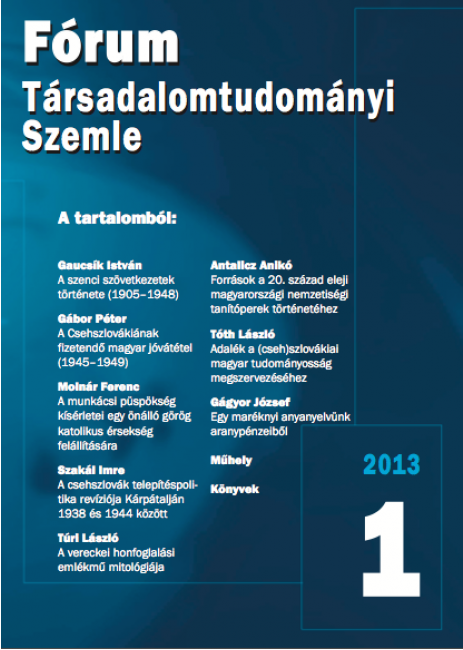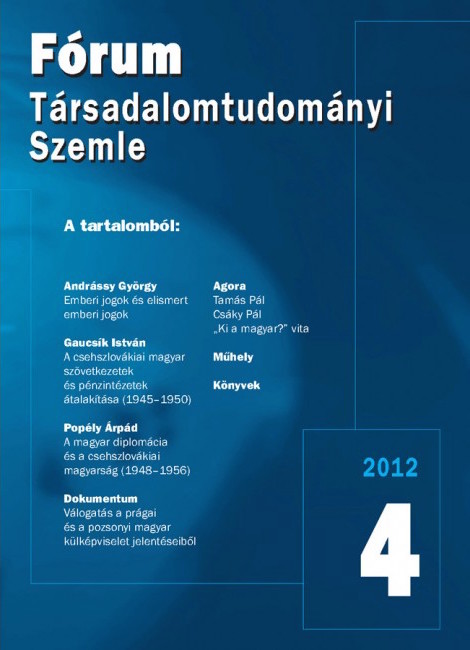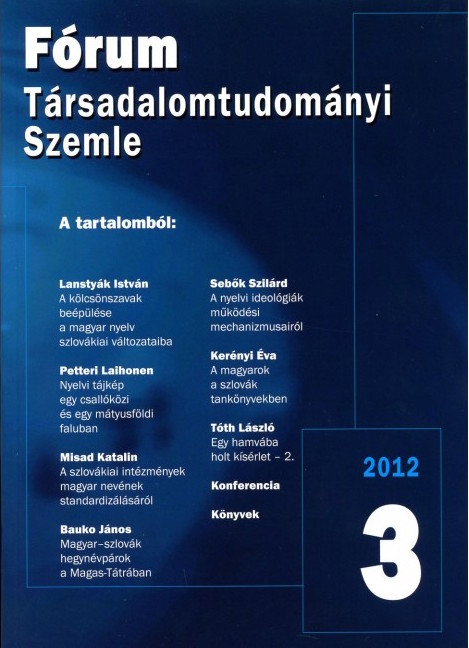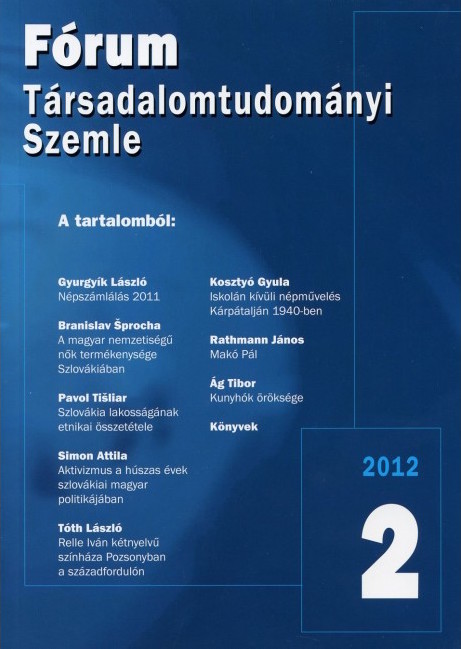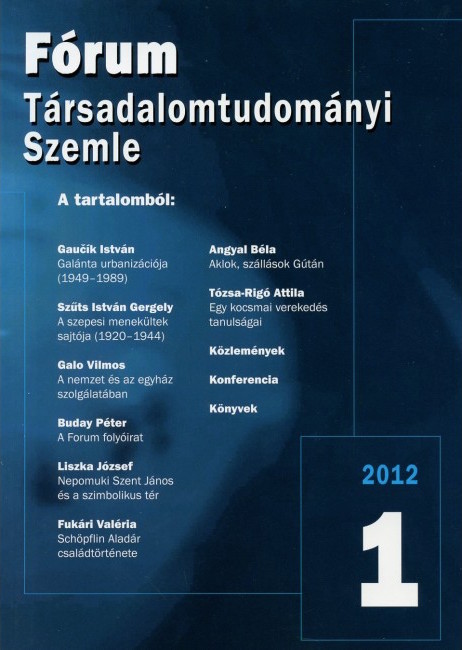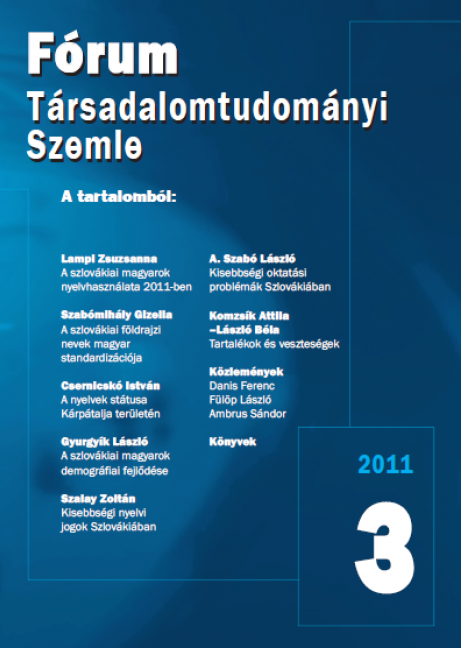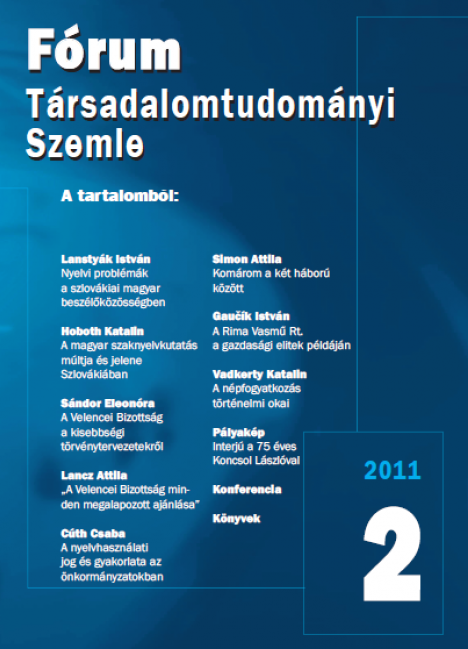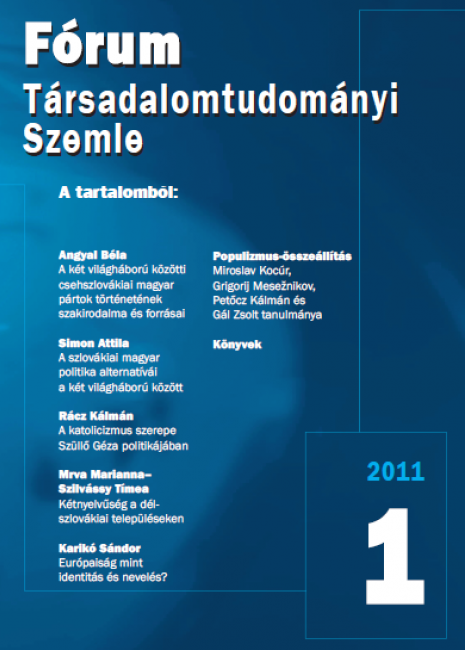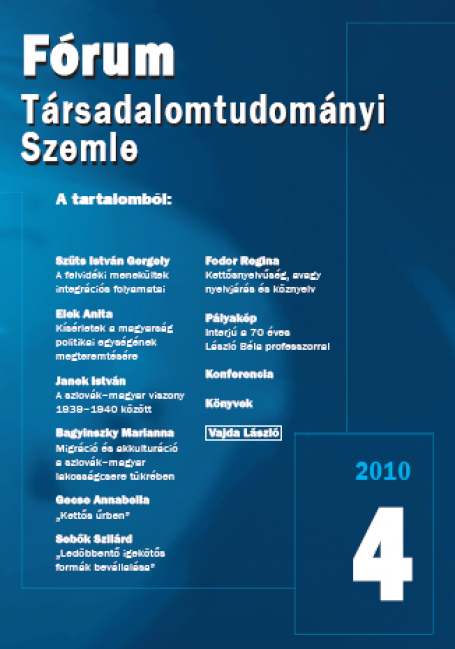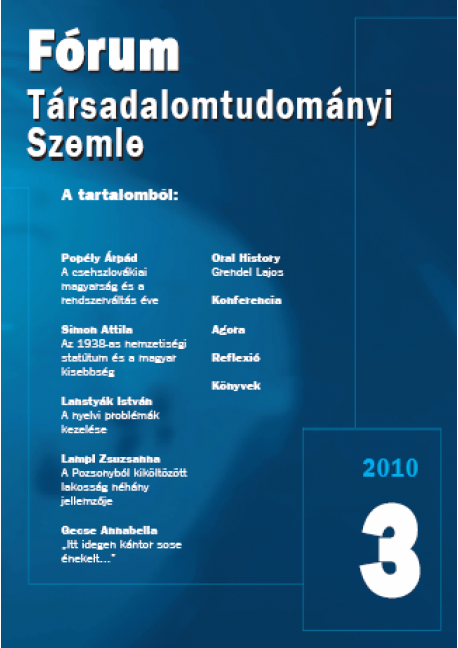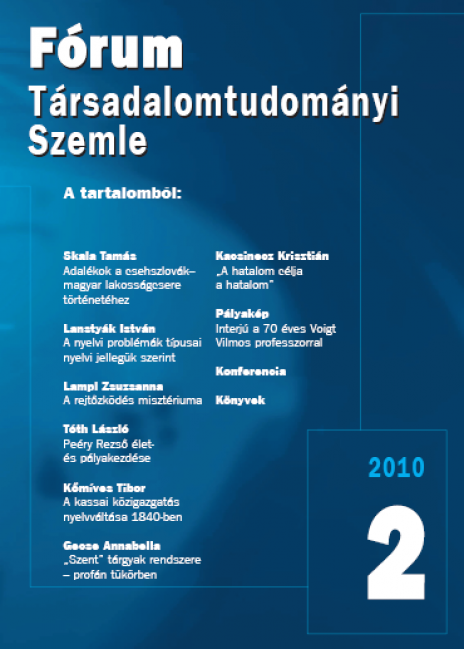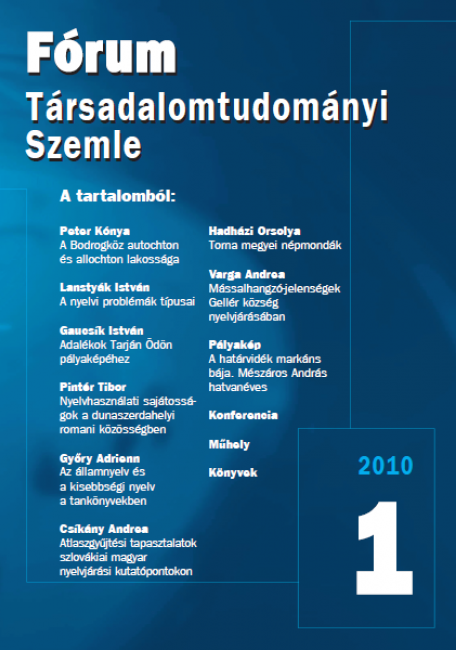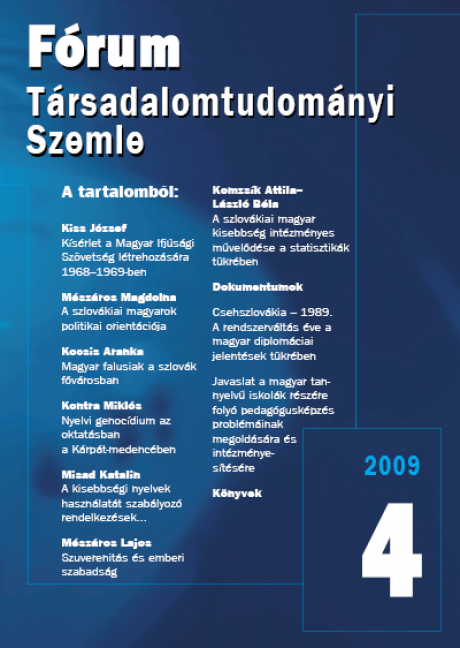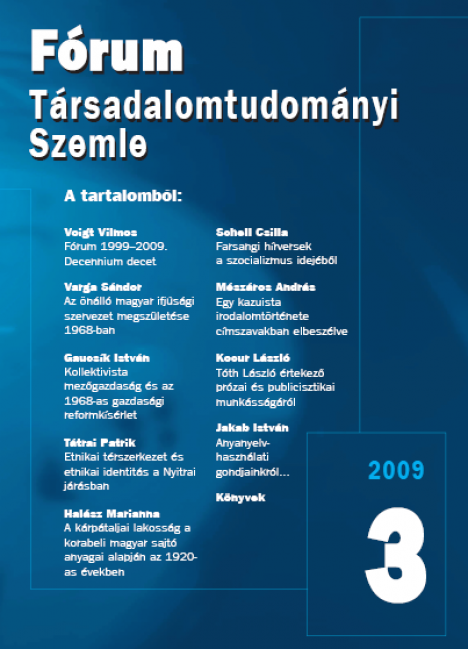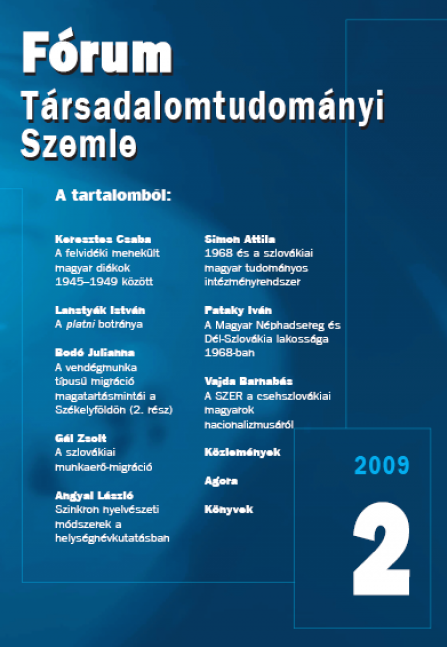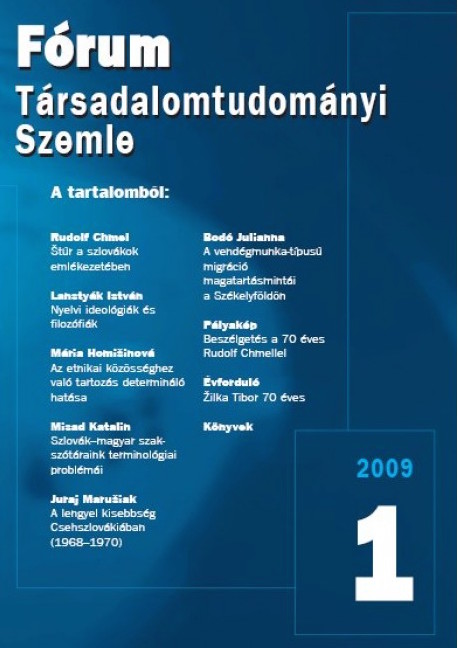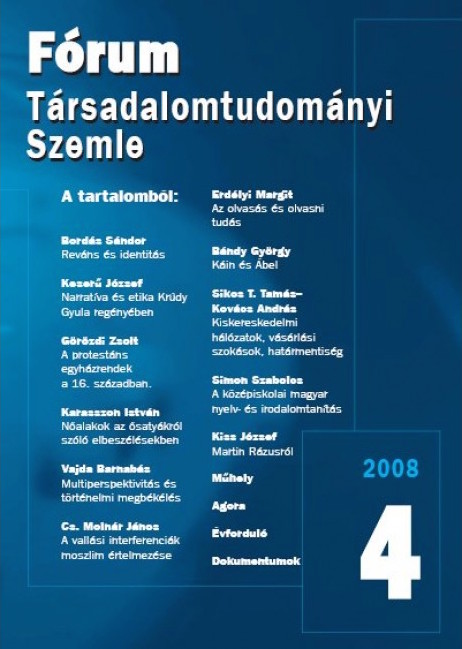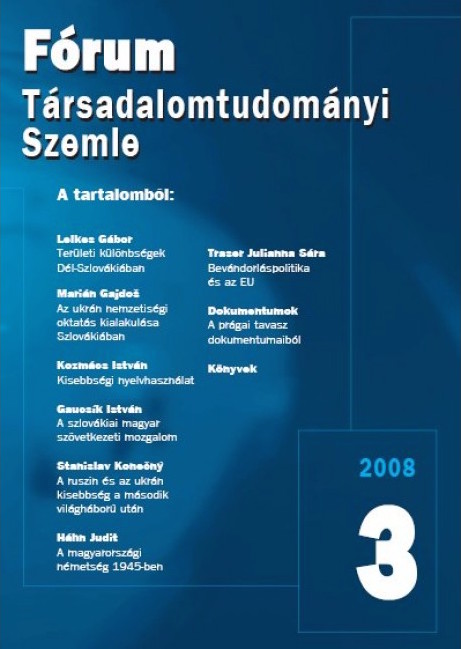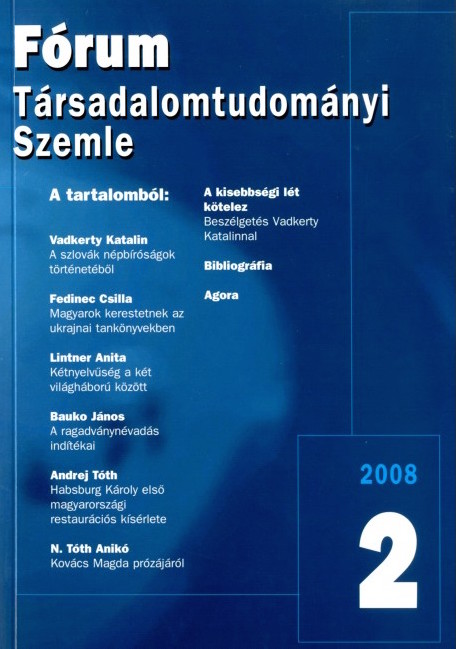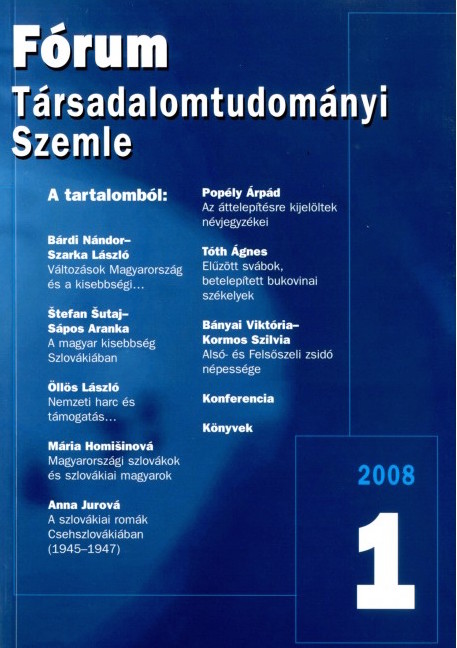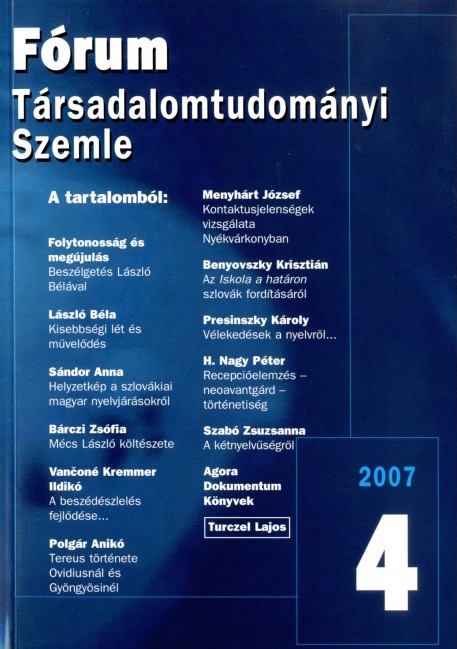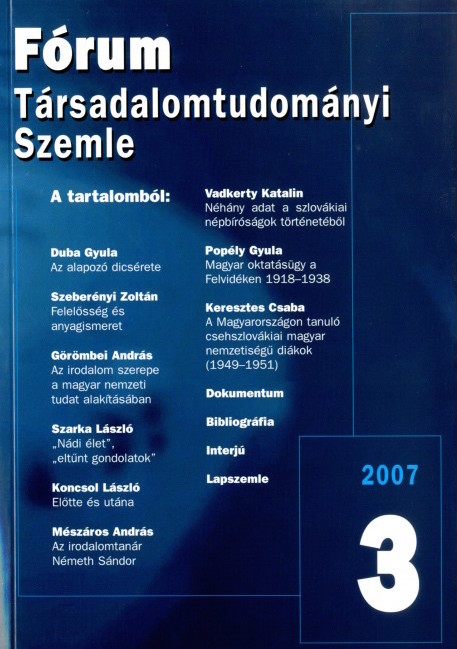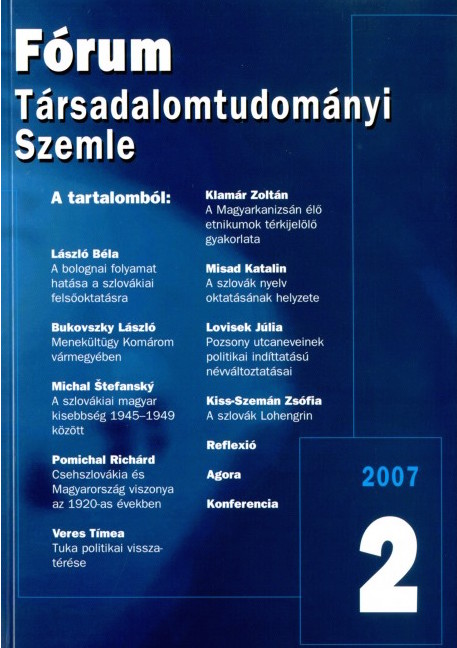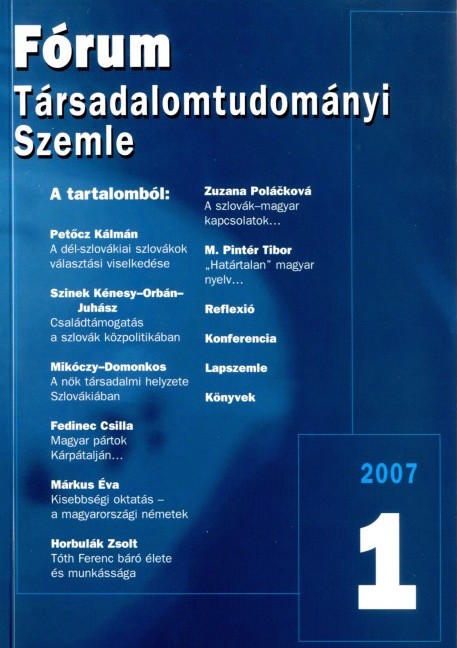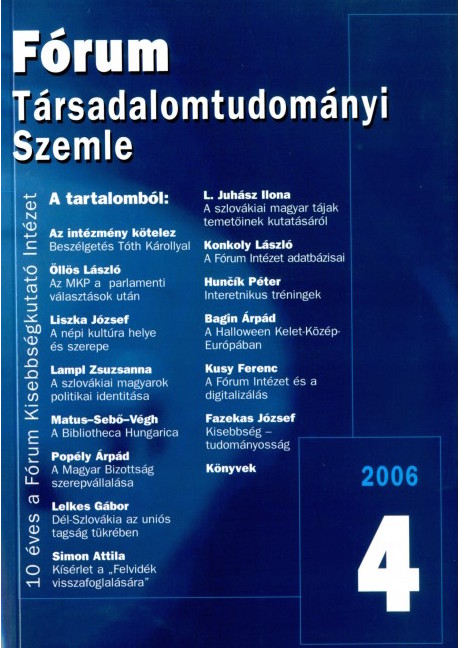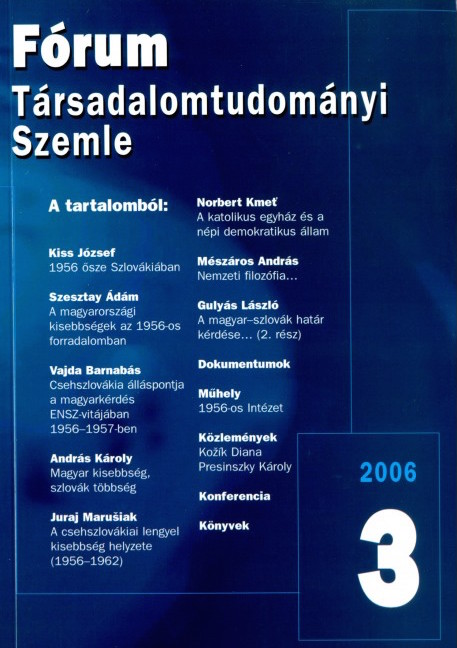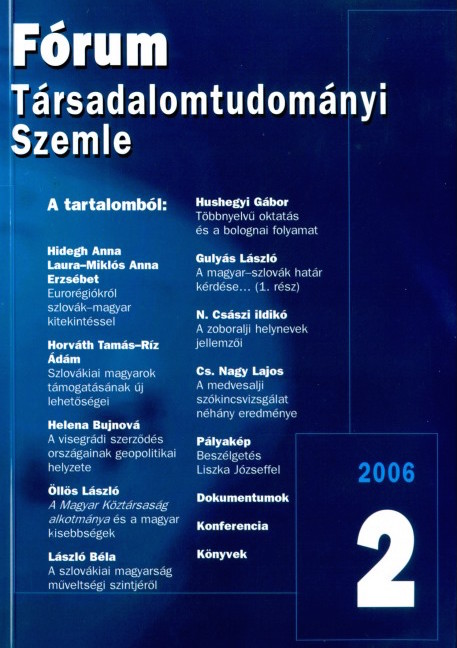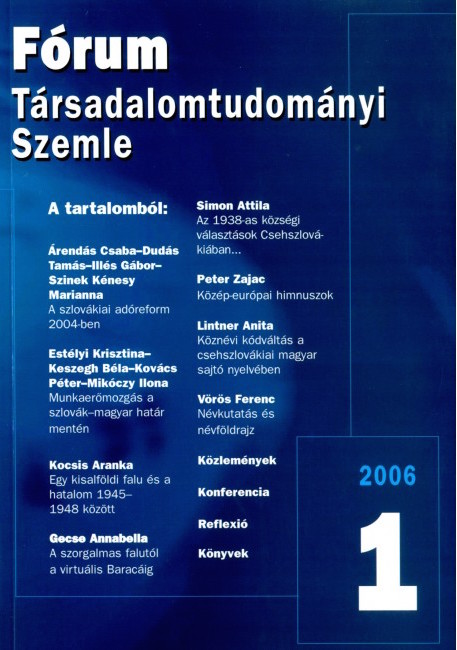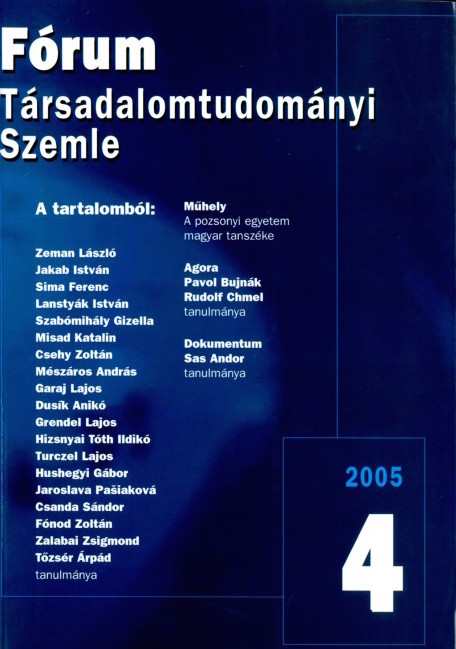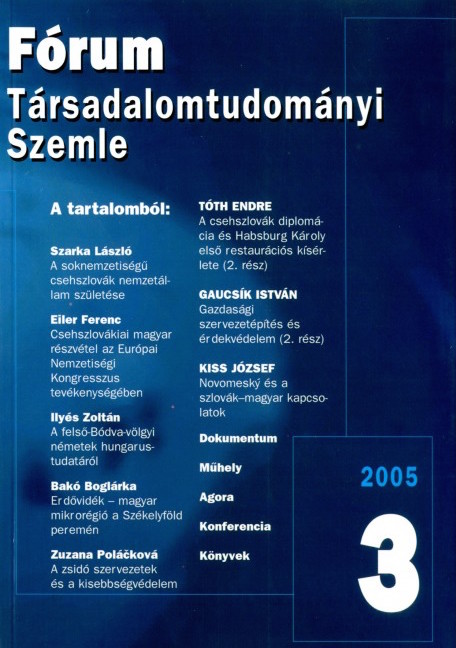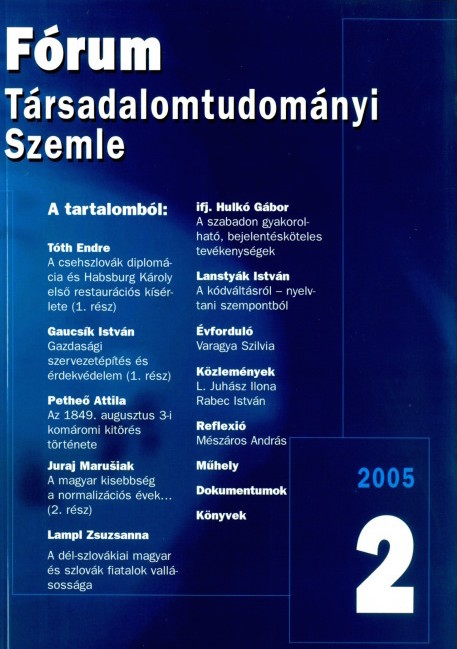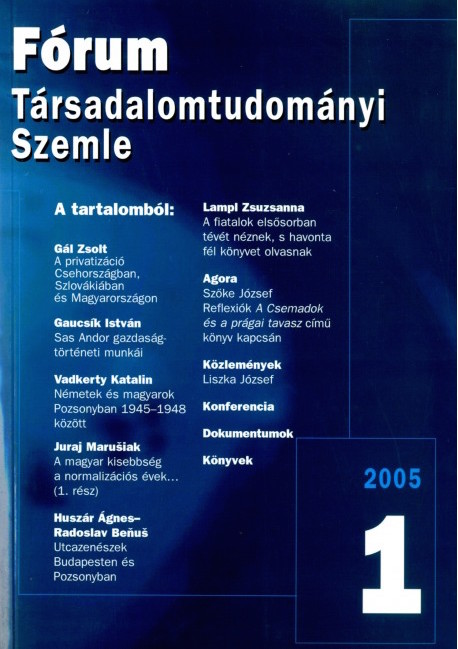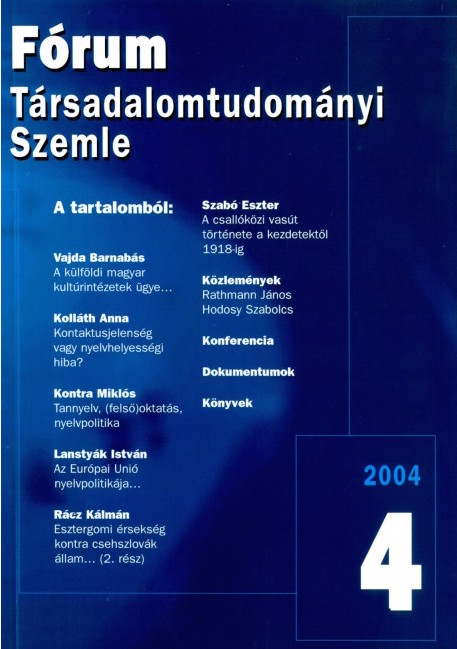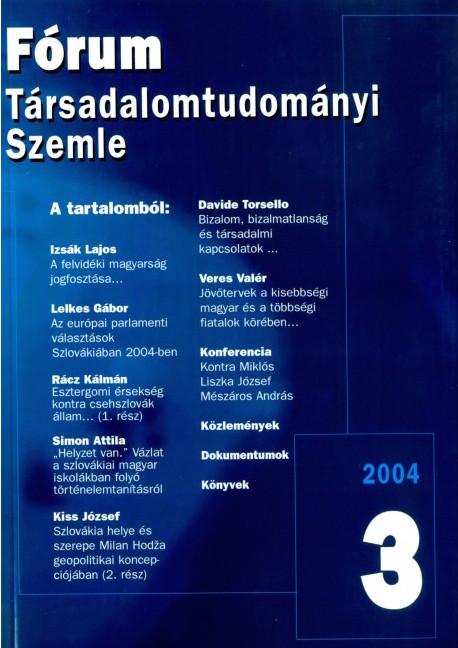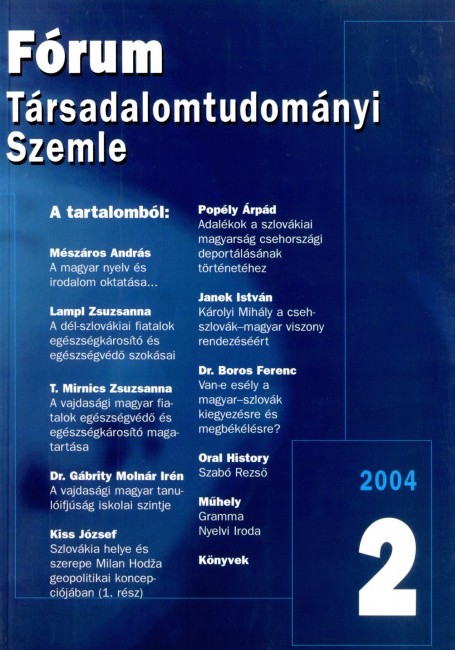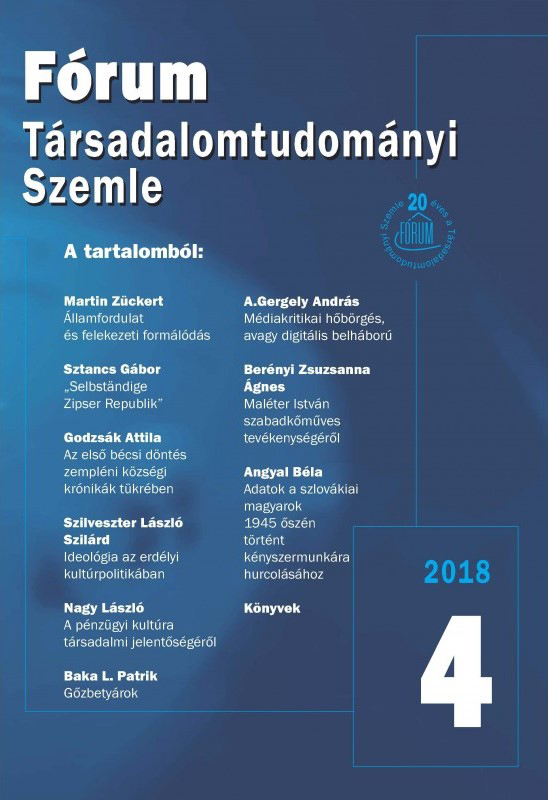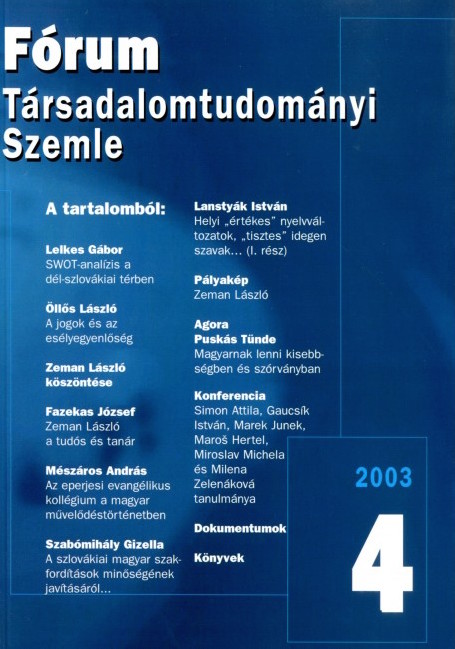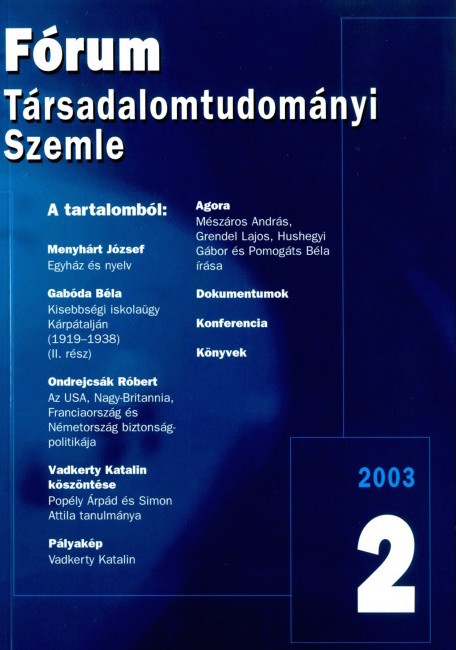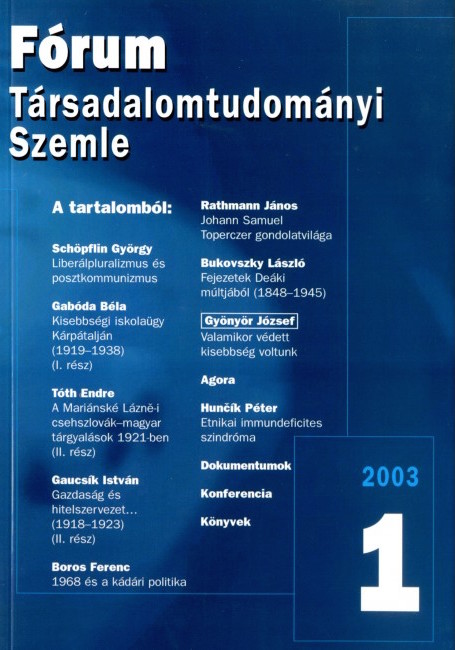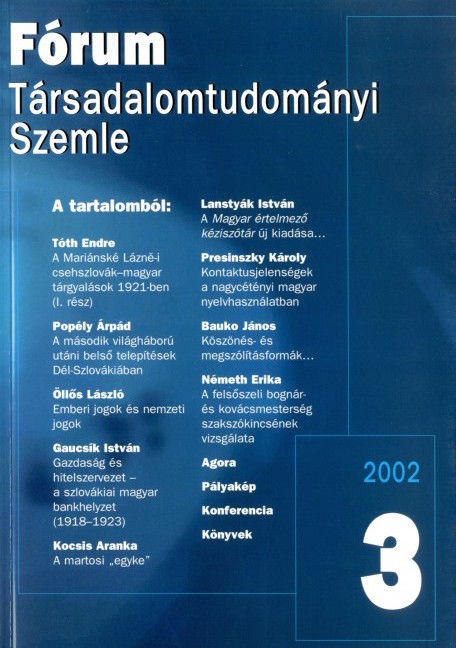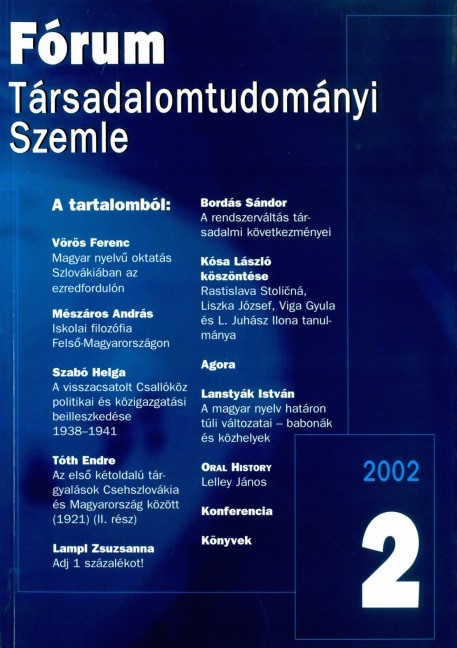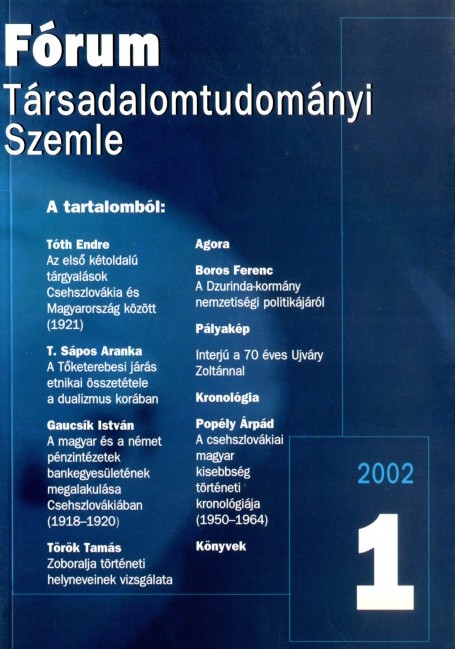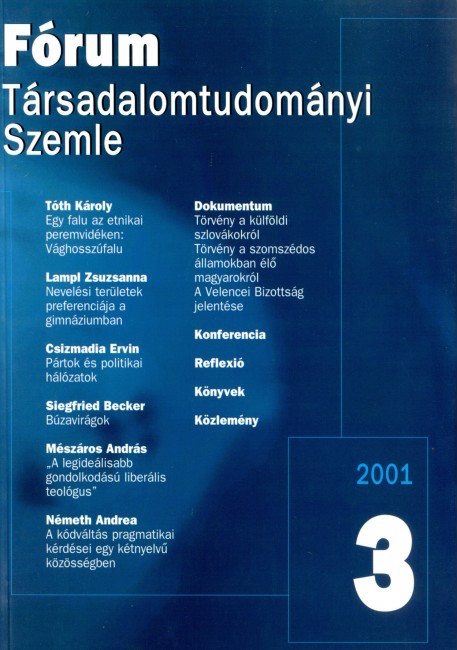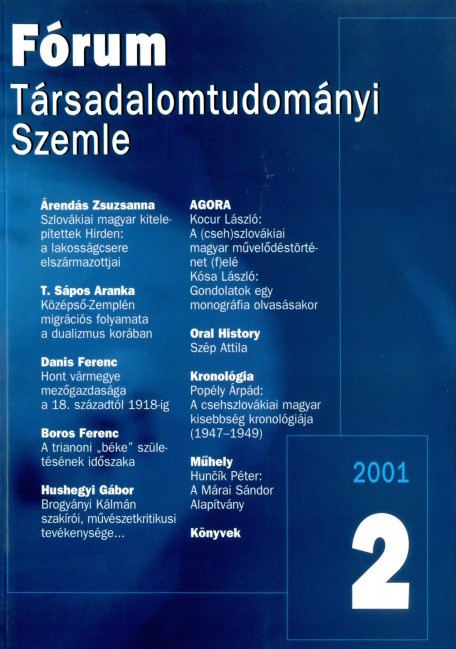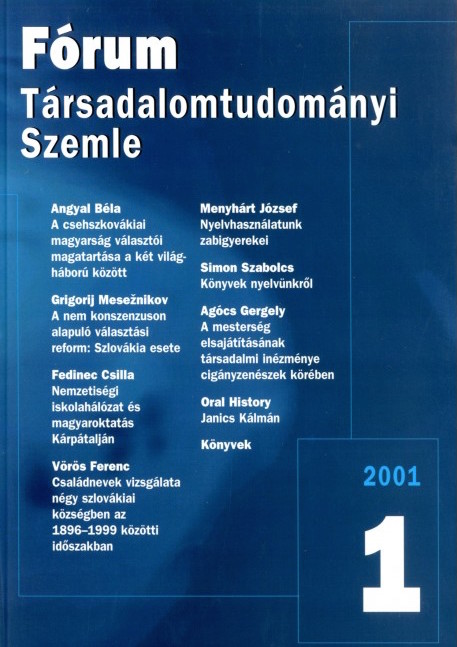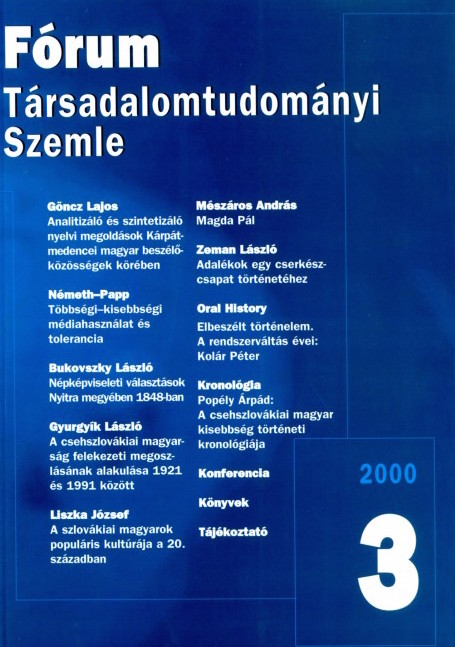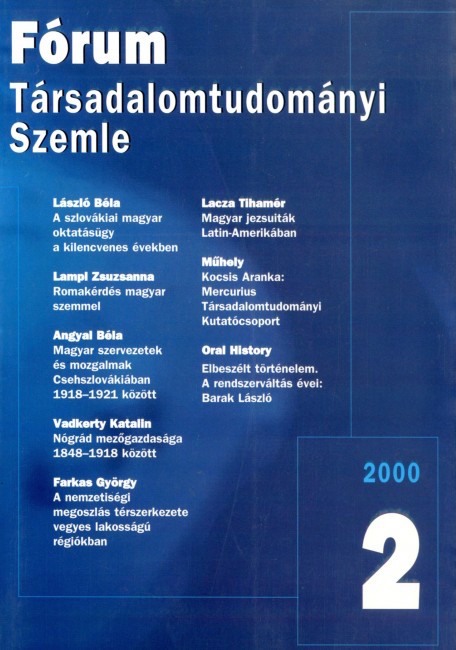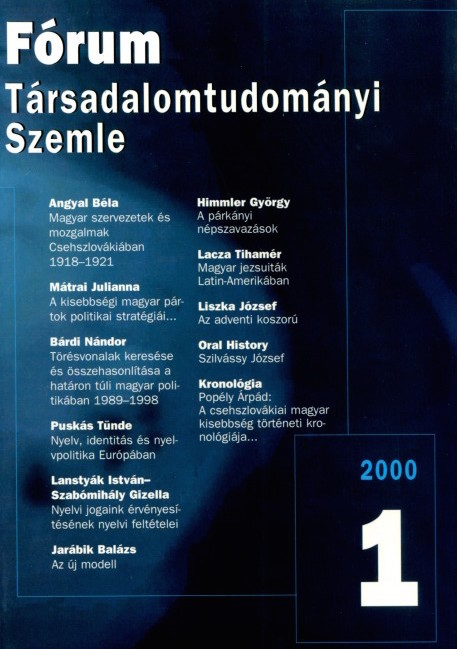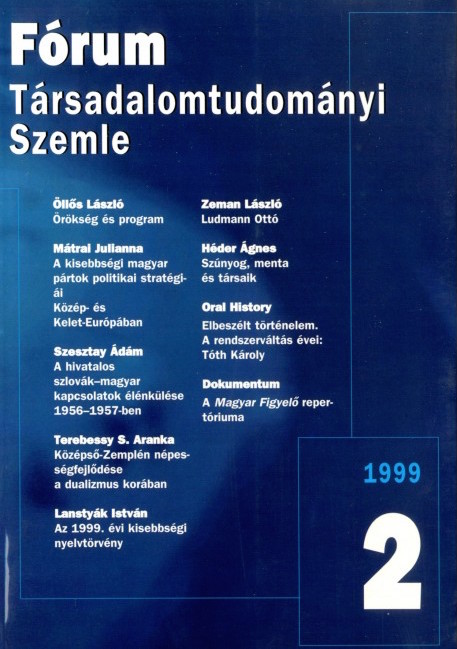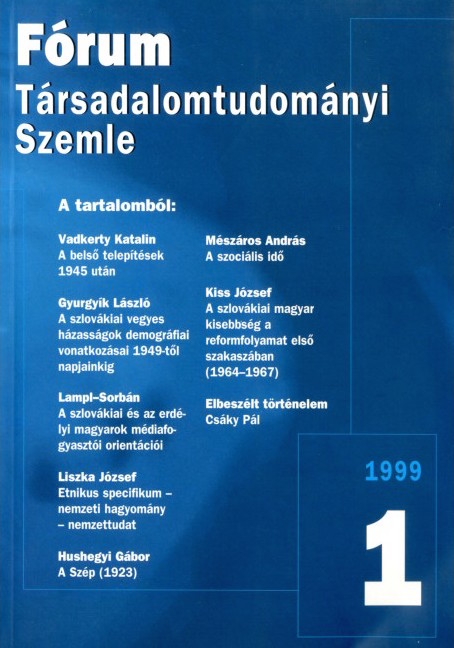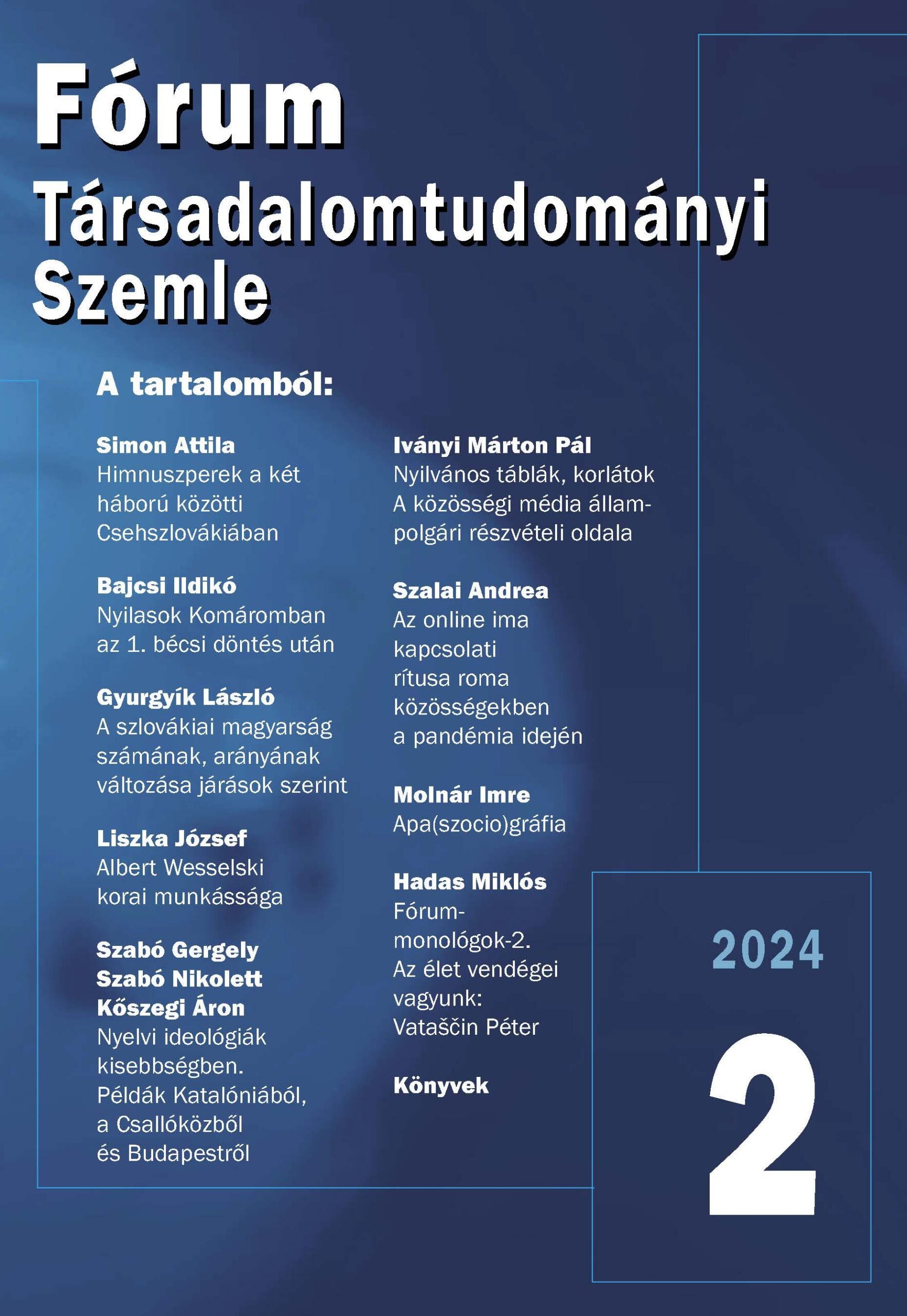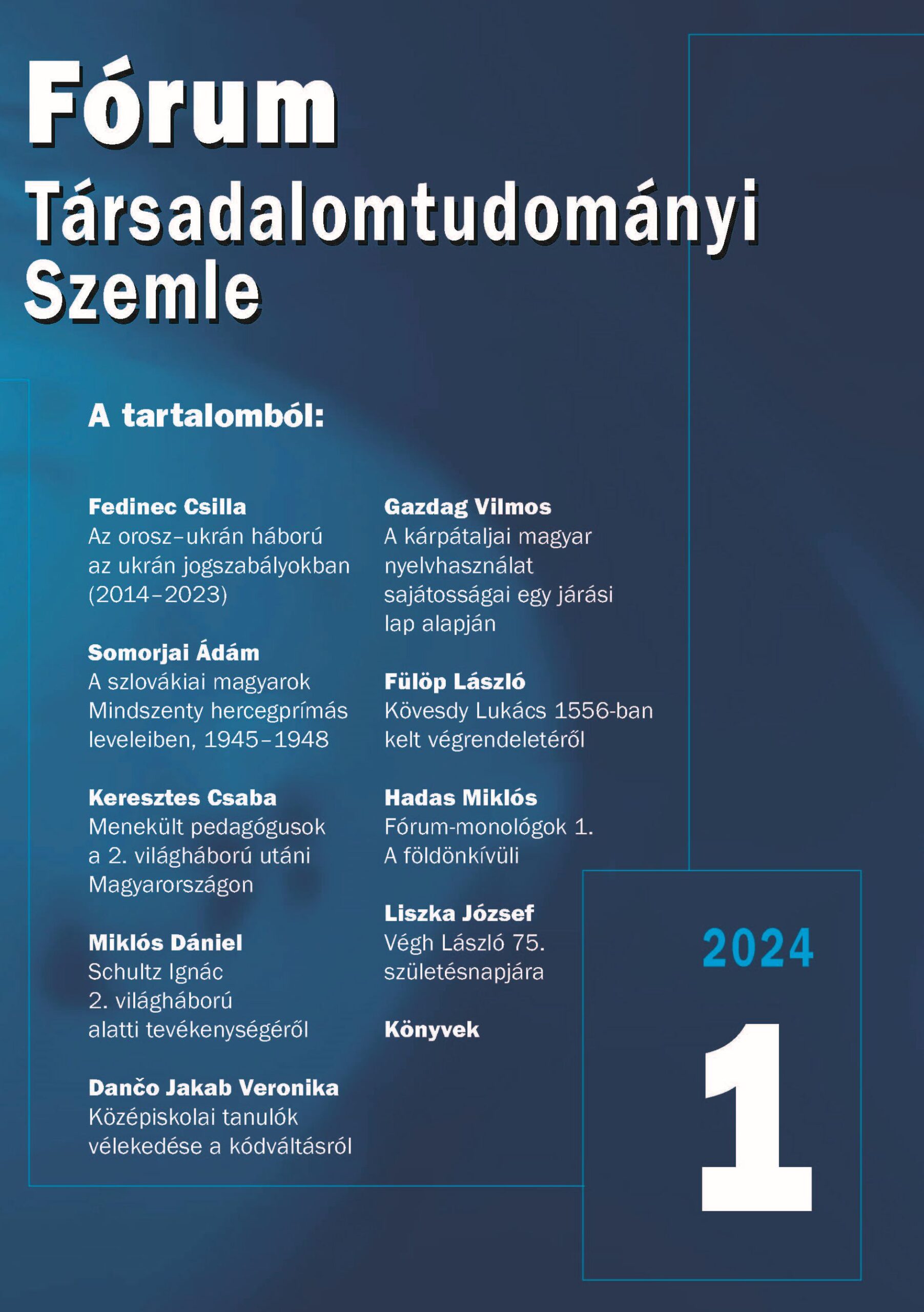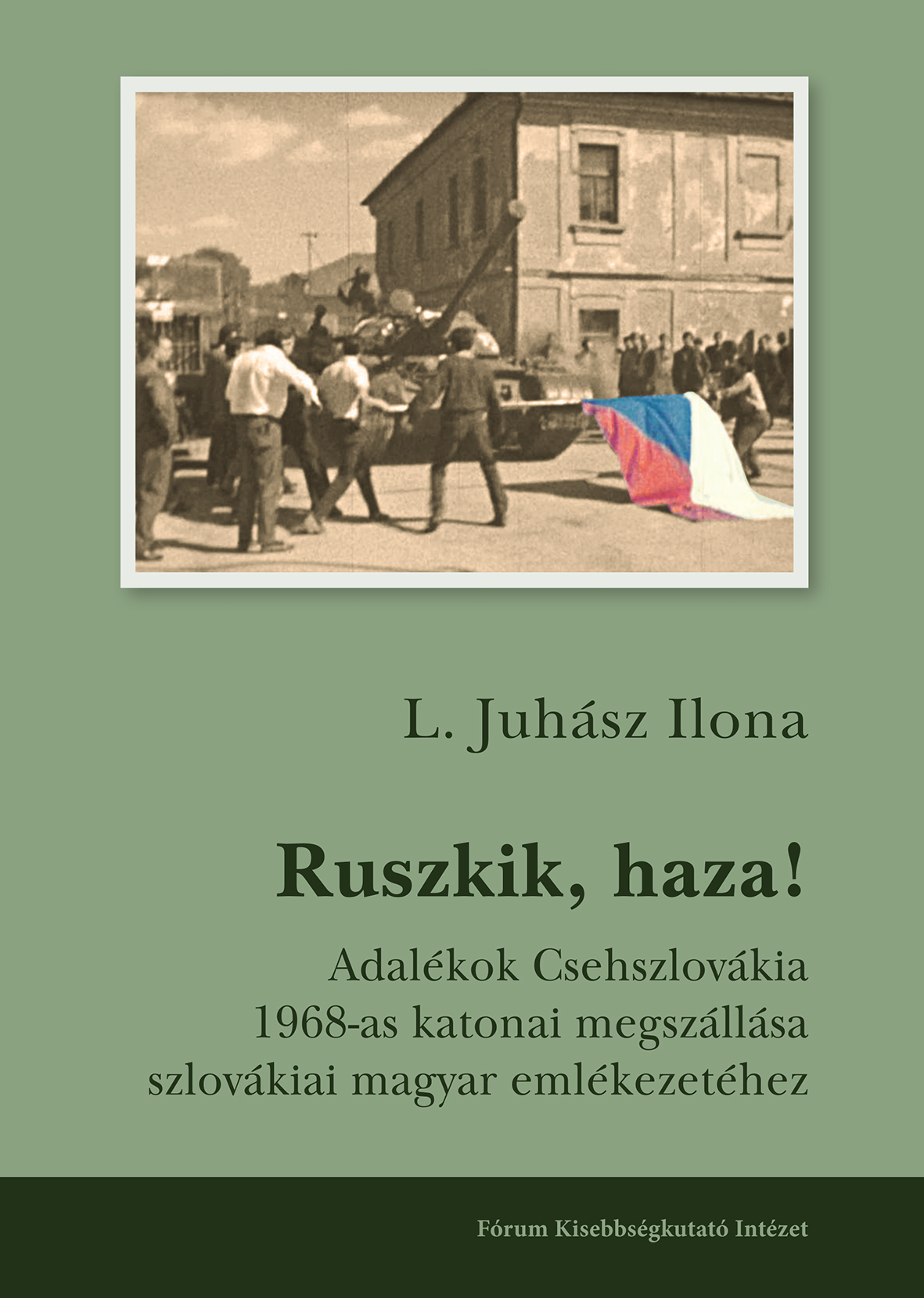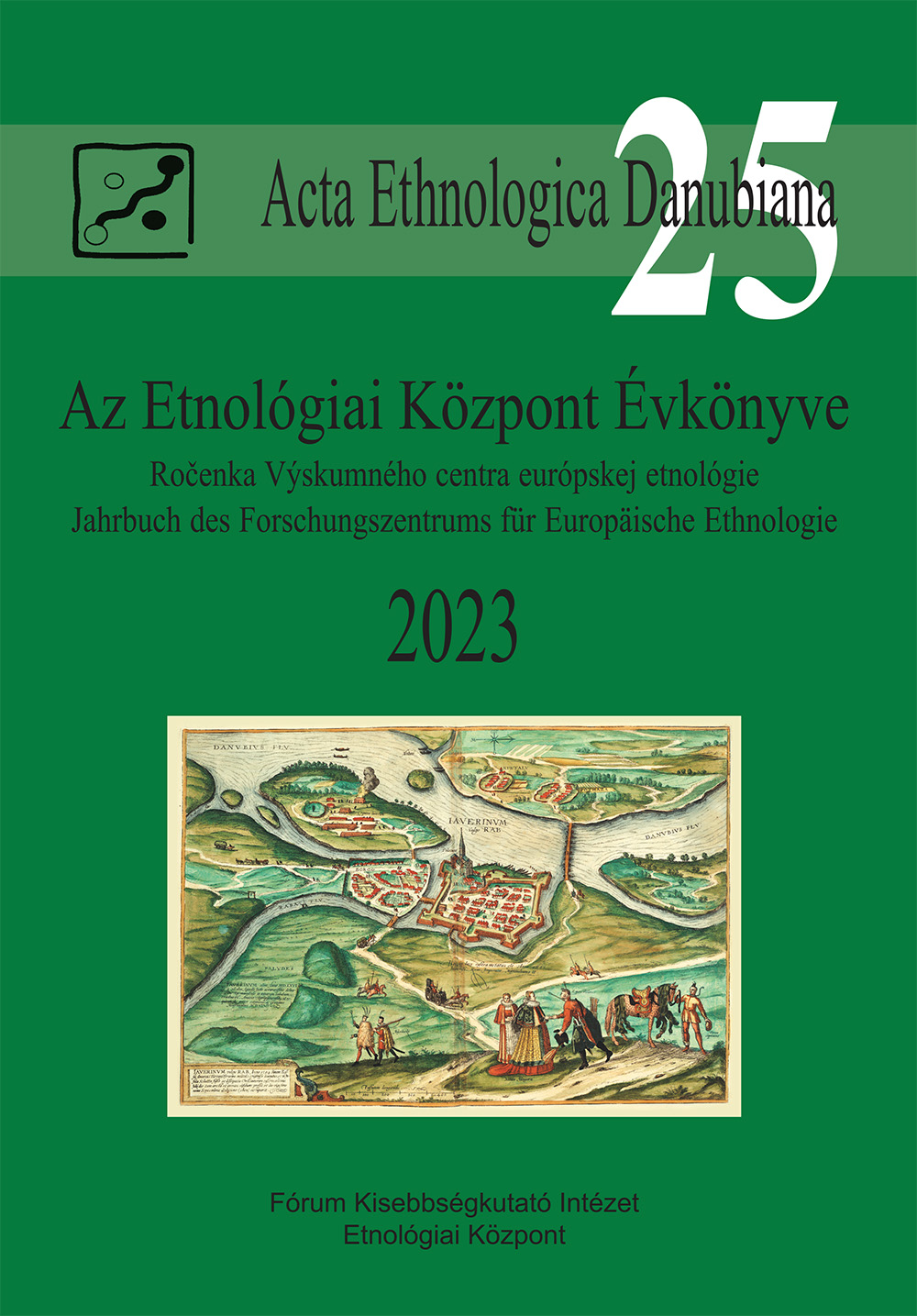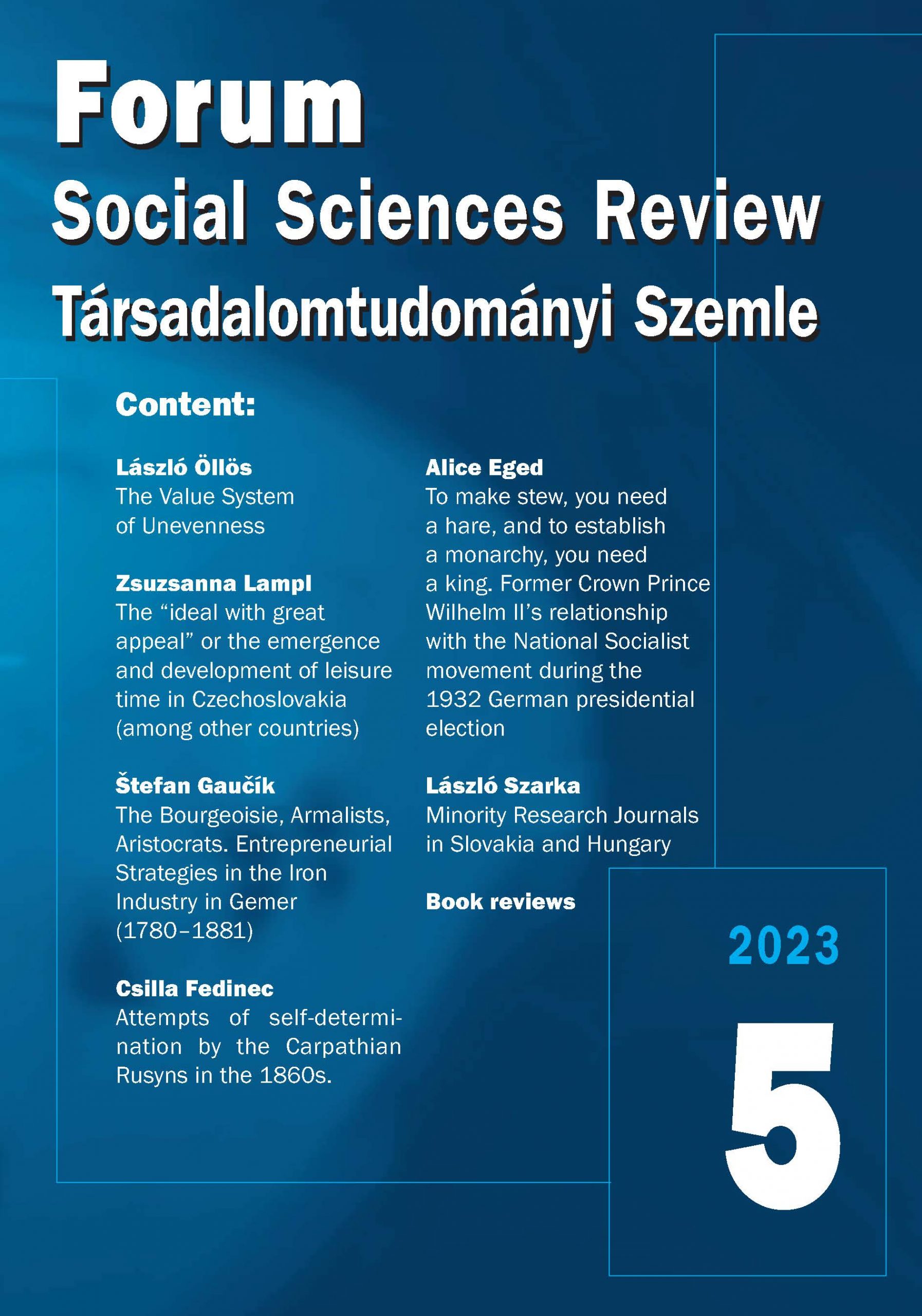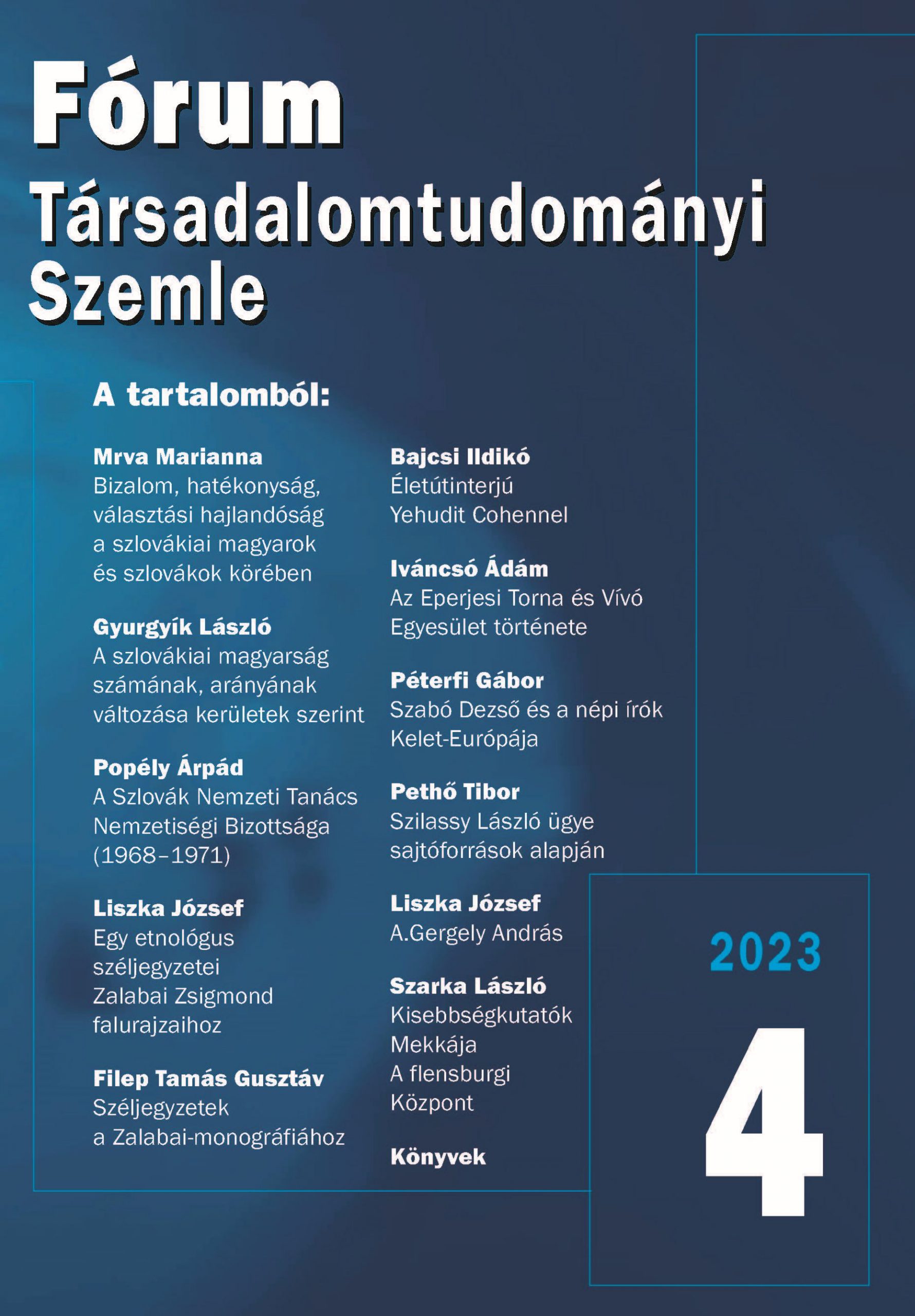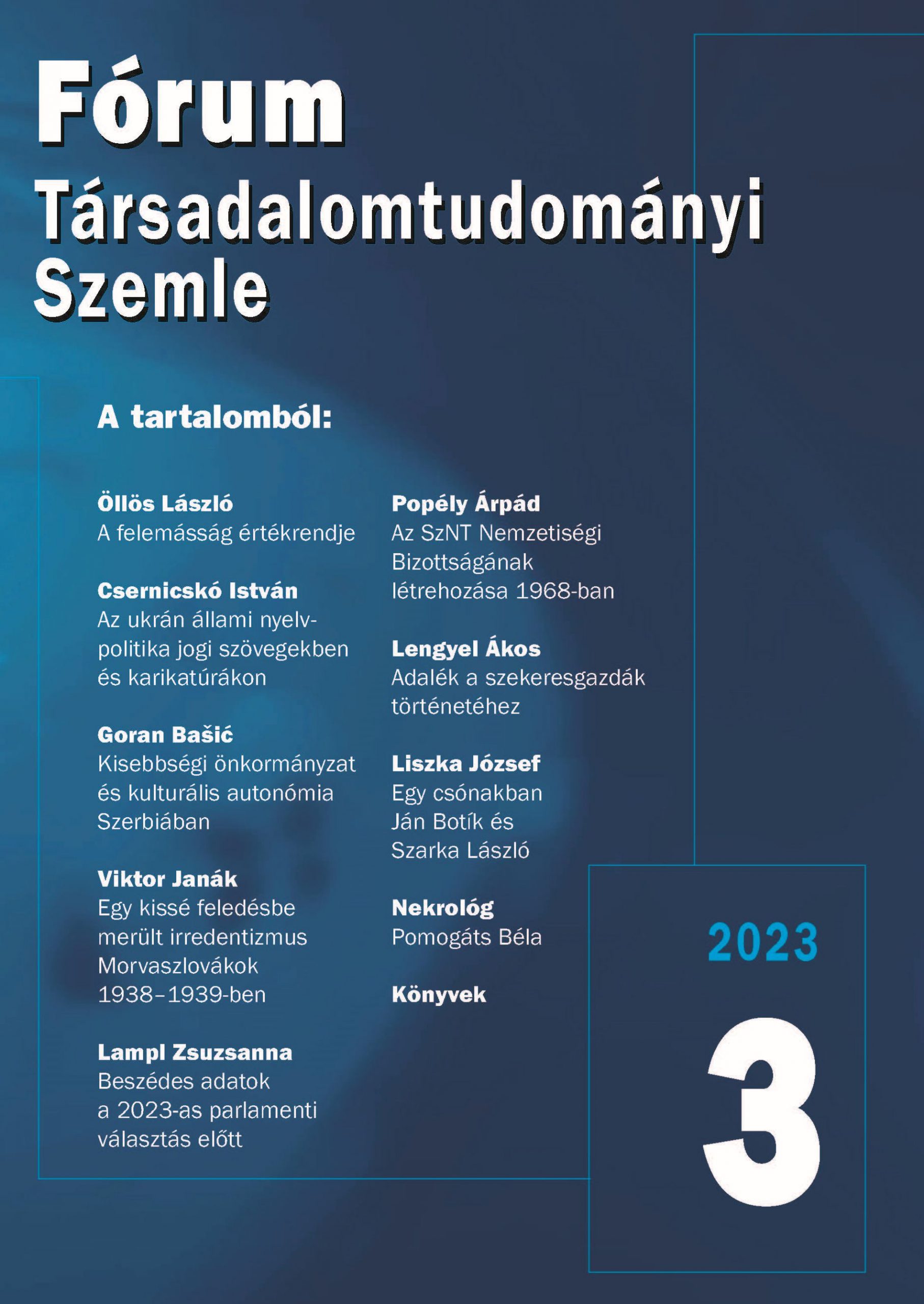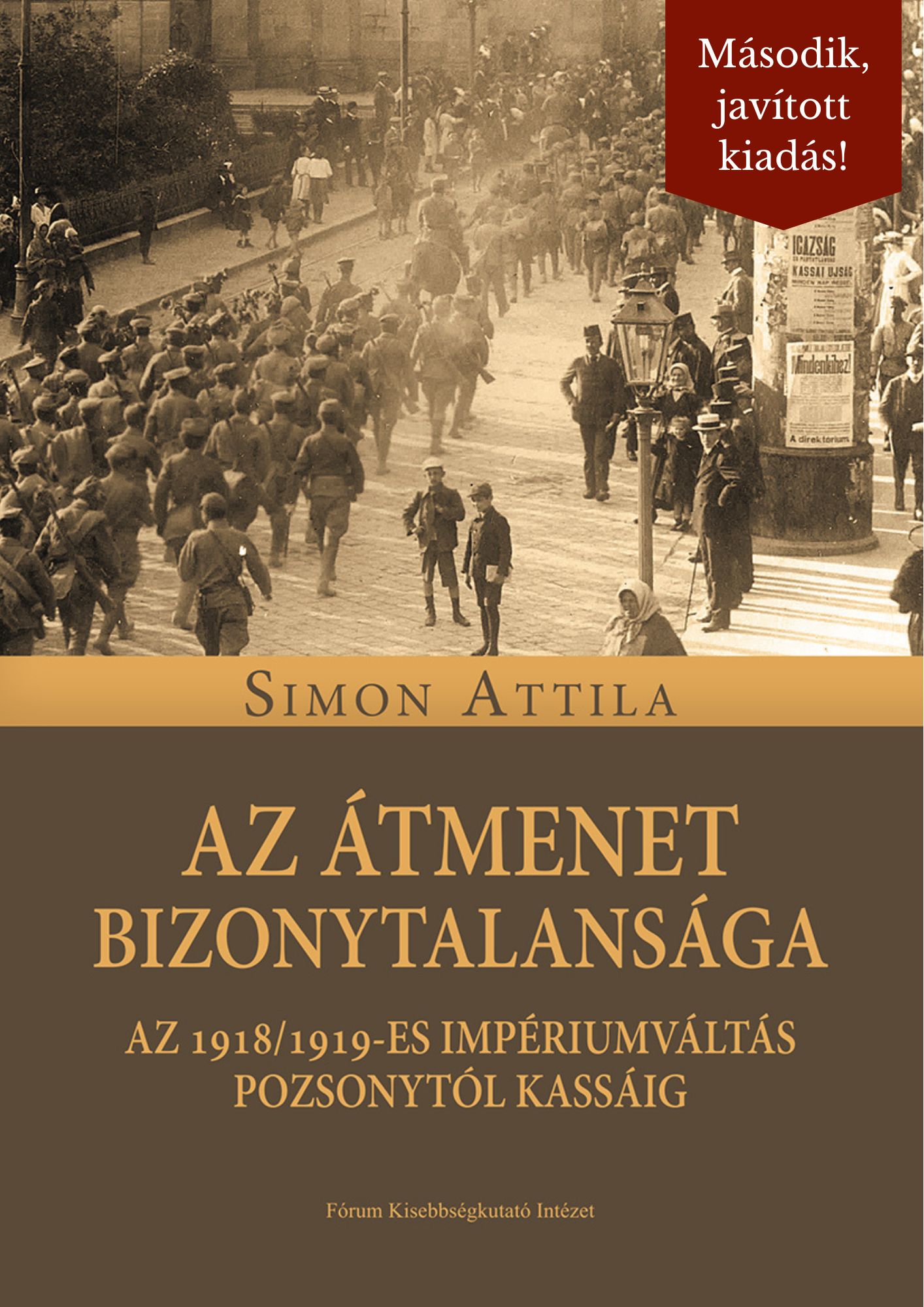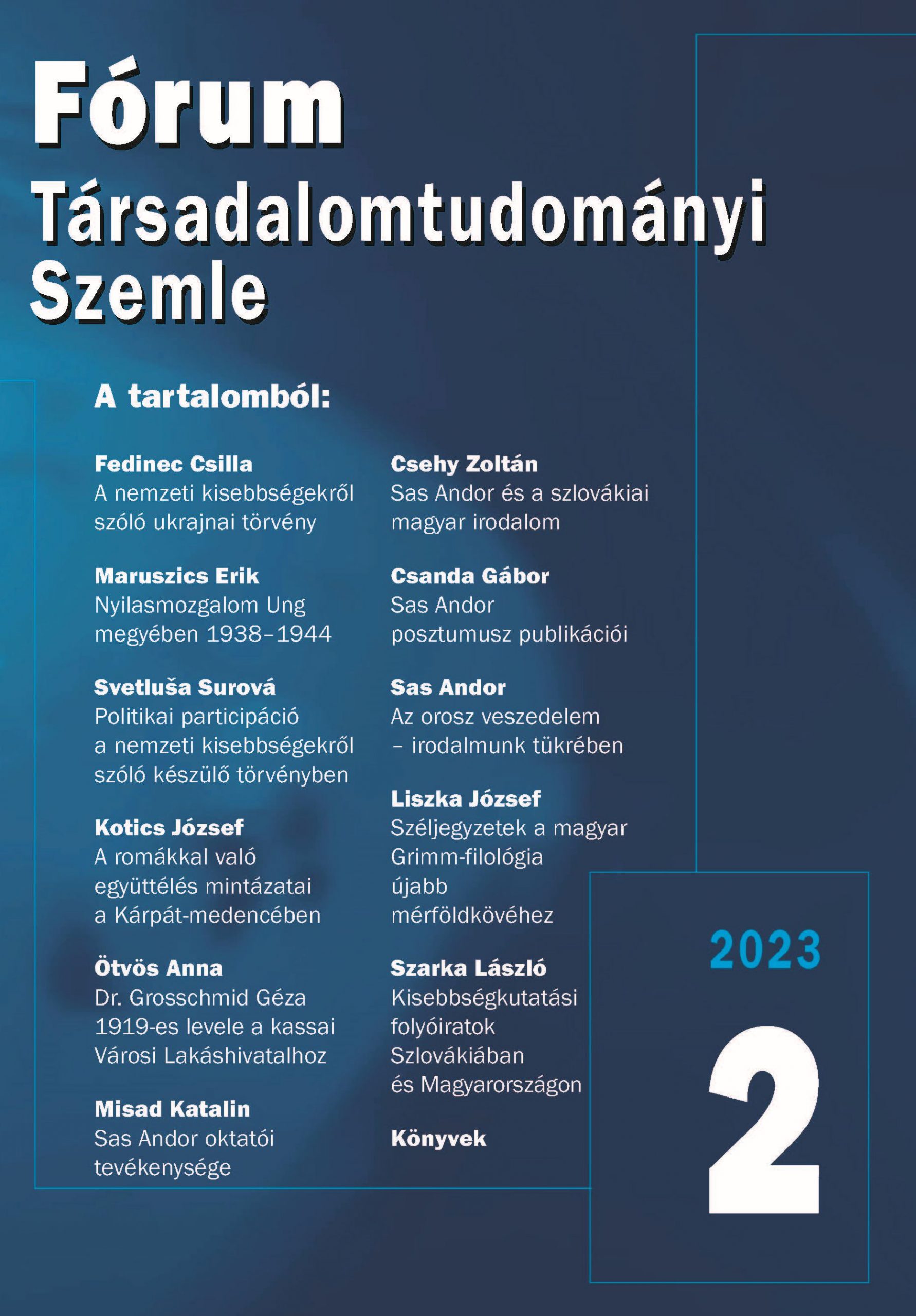Imprint 2021/5
FÓRUM TÁRSADALOMTUDOMÁNYI SZEMLE
FORUM SOCIAL SCIENCES REVIEW
ANNUAL SCIENTIFIC JOURNAL IN ENGLISH LANGUAGE
Volume XXIII (2021)
Head of the Editorial Board: LÁSZLÓ ÖLLÖS
Members of the Editorial Board
Zoltán Biró A. (Romania), Csilla Fedinec (Hungary), Holger Fischer (Germany),
László Gyurgyík (Slovakia), Péter Hunčík (Slovakia), Petteri Laihonen (Finland), Zsuzsanna Lampl (Slovakia), István Lanstyák (Slovakia), Zsolt Lengyel (Germany), József Liszka (Slovakia), András Mészáros (Slovakia), Attila Simon (Slovakia), László Szarka (Hungary), Andrej Tóth (Czech Republic), László Végh (Slovakia)
Content
Studies
ÖLLÖS, LÁSZLÓ: Hungarian–Slovak Reconciliation and the National Peace
GYURGYÍK, LÁSZLÓ: The Ethnic Composition of Slovakia’s Municipalities, Based on the Data of the 1950 census
LAMPL, ZSUZSANNA: The Primary Results of the last Hungarian Identity Survey in Slovakia
LANSTYÁK, ISTVÁN: Language Problems, Language Related Social Problems, Metalinguistic Activities
SIMON, ATTILA: The Banned, the Controlled, the Shifted, and the Compulsory. National Holidays and the Hungarians in Slovakia in 1919
TÓTH, ÁGNES: In the Margins of a Party Resolution. The 1968 Resolution of the Political Committee of the Hungarian Socialist Workers’
Party on the Situation of the Nationalities in Hungary
Central European Forum
EVERETT, JUDAS: Combatting Illiberalism in the Heart of Europe: Lessons from Slovakia
Reviews
Öllös, László: European Identity
(András A.Gergely)
Lampl, Zsuzsanna: The political identity of ethnic Hungarians in Slovakia, 1989-1990
(Gábor Csanda)
Gecse, Annabella: The Heart of Gemer/Gömör. Studies on the popular religious practice of Gemer/Gömör in Southern Slovakia
(Péter Vataščin)
Liszka, József (ed.): Acta Ethnologica Danubiana 22. – Az Etnológiai Központ Évkönyve – Ročenka Výskumného centra európskej etnológie – Jahrbuch des Forschungszentrums für Europäische Ethnologie
(Katalin Pajor)
Guidelines for Authors
Authors
Hungarian–Slovak Reconciliation and the National Peace
For three centuries, Europe has been organized into nation-states. This situation did not even change after the European Union had been established. The European Union, despite having its own central decision-making and executive bodies, is under the influence of its most powerful member states. The governments of these states decide over the main questions of the Union. The smaller member states could have significant influence only if they organize themselves in interest-groups, mainly on a regional basis. Together they could become strong enough to outweigh the power of the larger states, but still only in some issues. To achieve more, they need to build up a broader alliance of different state-groups.
It is a situation when nation-states fight each other, without a war, of course. But the main aim of the interstate relations remains the same. Their form is milder, but substantially unchanged. That is, the relations are based on strength and power regulated by national interest. (Horowitz 1985: 4)
Creating a commonly accepted system of values in political decision-making on a higher level could be realized by supporting the main components of a modern political society. But it needs reconciliation between nations.
The reconciliation between the small nations of Central Europe must be determined by basic national issues. The democratization of these countries and their independence depend on it. More than three decades after the revolutionary wave that triggered the change of regime, several small nations, including Slovaks and the Hungarians, still continue to fight against each other on a national basis. Their diplomatic efforts, many elements of their countries´ internal legal systems, their political parties, and the programs of many of their organizations are aimed at national victory over one another. When acting against each other, neither their accession to the European Union, nor their membership in NATO prevents their governments from orienting themselves toward great powers. As part of their strategy against their neighbour, they offer themselves to the supporting great power as a zone of influence. This, as they believe, strengthens their position in the European Union.
The issue of the Hungarian–Slovak reconciliation is one of the most important ones in regard to the future of the region. Both reconciliation and the absence of it, have had and will have a significant impact on the political community in both countries. It also sets an example, one way or another, for neighbouring countries. At the same time, as a non-negligible element of the experiment called EU, it can further or even hinder the solution of one of the fundamental problems of the Union, the conflict between the nation-state and the effectiveness of continental decision-making.
Reconciliation and the Visegrad Countries
By abandoning to serve a great power, small Central European nations renounce their sovereignty too. Their national advancement could only be expected from the service of one of the great powers. But for serving a great power, they should also adopt its poli tical system and serve its interests, oppressing and sometimes destroying others. (Kučera 2008: 39)
The national liberation of one party is linked to the national subjugation of the other. The extension of national freedom of one nation does not mean its further extension to another. Instead, it means a new dominance. National freedom also means national slavery. Not only did this model reinforce, but even made dominant the belief that the national freedom of one nation does not strengthen but it even endangers the freedom of the other.
It seems that whatever can be done with the support of great powers: even territories can be acquired, and the population of other nationalities can be expelled from those territories. Great powers never require effectively enough that national freedom and equality of nationalities is guaranteed.
The rejection or absence of the universal principle of national freedom and equality gave way to total national relativism. The principal here is that the human rights of other national minorities can be violated and their collective national life can also be obstructed or even prohibited. The national development of one nation is linked here to the national oppression of the other. One party links its own national future (i.e. persistence, survival) to the destruction and oppression of the other party.
This has a significant impact on the political culture of the two countries and, of course, on the behaviour of the majority of their leaders to this day.
Today’s interest alliance of Visegrad for reconciliation is worth little. The interests are temporary. Of course, it is difficult for the parties to expect more. There is the experience of past centuries of attempts to nationally destroy each other. And because of this experience, they have demonstrated to their own public how the other side has tried to do so. Therefore, now they have to listen to their own public which has been socialised in the spirit that the other side had tried to destroy them as a nation. Part of their current experience is that they only communicate their own threats to their own public. From this they conclude that the other side is communicating the same to their own public, in relation to themselves.
Their cooperation today is nothing more than a connection of interests. They are aware of its relativity. They are willing to cooperate with each other only to the extent that it does not change the essence of their national values established by the end of the twentieth century. This cooperation is subject from time to time to the disruptive intentions of external forces, considering the fact that the parties have repeatedly confronted, and even betrayed, each other whenever they expected a national gain. And this national gain came from one of the great powers that wanted to dominate the whole region in general. So, both the one that is currently supported and the one that is shortened.
The small state puts its foreign policy strategy of variable alignment with the great powers ahead of stable, reliable federal ties. From the point of view of small states, national security can only be ensured with the support of a great power, not even with any of them, but with the victorious one at any given time. Therefore, a rapid transition from one power to another is considered one of the fundamental requirements of their national security. They must therefore pursue a foreign policy so that the transition remains possible. This is called a balanced foreign policy. For if the neighbour becomes faster, he will be rewarded by the great power that is just becoming dominant, and following Niccolo Machiavelli’s admonition, he will not do it on his own.
It follows logically from the essentially threatening hostile relationship with a neighbour to serve the power that is becoming dominant at any given time. To them, only the full unification of small nations and the joint rebuilding of their position of great power would offer a real alternative. But there are high cultural barriers to this decision. There is some hope that these barriers, raised by them themselves, can also be torn down by them. But they have made it part of their national identity and are imbued with it so much that today they are even afraid of faltering. Therefore, a new idea must be offered.
The Ethics of Ambiguity
Ambiguity has become a moral category. It is something that needs to be protected. The moral essence of ambiguity is that the claim that certain elements of backwardness are more valuable than the state of development. For this, of course, this development must be seen as a vestibule of decay and fall, and if the fall does not occur, there must be no doubt as to the future realization of the prophecy. And, since all (highly) developed cultures will once undergo a crisis, how can anyone now claim that they could not get into trouble someday? What is really needed, however, is the way you could get to the forefront of development again. This is because criticism of the more advanced is not accompanied by a real development strategy that shows a different path. Rather, it attempts to mobilize only with predictive visions, and detailed programs that are feasible and measurable in their effectiveness are not born.
The ideological protection of backwardness is linked to the protection of those who cause backwardness. If they did not cause backwardness but prevented other people from embarking on the path of decay, then morally noble deeds could be associated with them. Thus, they retain their moral right to retain or regain power. The uncontrollability of the claim requires a vision and a passionate political identity. Strong passions instead of rationality, and attachments to them, that are powerfully held in power. Passions are primarily national passions. They rest in the constant strengthening of the temperaments of the offended national self-consciousness. The goal is not to resolve the offense, but to increase the pain, to strengthen the sense of pride of the offended.
However, the essence of Central European ambiguity also includes relative separation from the East. In contrast to the Eastern empires, they see themselves as Western, and therefore more developed. In spite of many features of their culture, including their Eastern political cultures (Bergyajev 1989: 200-201), they did not consider themselves to be part of the East. Otherwise, they should have accepted the na turalness and correctness of their repeated conquest by the East. Although some of their political elites spread this ideology, they knew their society did not want to become either Turkish or Russian, and they did not want to merge into these empires either. And with few exceptions, they themselves did not want to do so, even if they supported the rule of these empires and spread many elements of their culture with their power from their conquering lords.
However, masters of ambiguous separation still face another challenge. They also need to divide their societies, separate them from each other. Towards their eastern conquerors (Figes 2002: 368-371) they have behaved as more eastern, that is, more communist, more pro-Russian. When they were conquered by a western power (Simms 2013: 219), e.g. the National Socialist Germany, they presented themselves as more German-friendly than their neighbours. And more Western when they joined the democratic West, while at the same time pushing back their neighbours. And when they approach East and West at the same time, they will argue in two ways simultaneously.
Moreover, even in several ways, as the Central European country sometimes wants to adapt to more than one great power. It is not the resolution of the contradiction but its maintenance that becomes a political and cultural goal.
If a Central European country is positioned in more than one direction, it is not duplicating, but pursuing its own interests. It doesn’t necessarily perceive it as a dichotomy, tending here and tending there. If I am better positioned, if I jump to the other side at the right time, then I am at an advantage and he is at a disadvantage.
In other words, the power, the economic, and cultural consequences of duplicity should be accounted for. That is, the main consequence of power is not the independence of the region, but its suspension on the pretext of national fight with each other. (Smith 2004: 154) The formerly unified economic space is being dismantled, creating small units that are operational by depending on the currently dominant power. They did this in the twentieth century, in an age when the national markets that had been considered big have turned out to be small.
In the age of colonized markets, breaking down former big market units into small ones means that the dependence of the small ones on the big ones is growing. But it is also culturally necessary to separate those who were previously closely related. This is based on linguistic separation. They try to achieve it by creating linguistic dominance. The education system forces only the minority to learn the language of the majority, but it does not require the majority to learn the minority language. Not even in settlements or regions where they live together. The other language becomes an instrument of oppression as the two languages are not equal. With the break-down of Austria-Hungary, the dominance of the Hungarian language is not replaced by linguistic equality, but by the dominance of the Slovak one. This eliminates the ability of the members of the majority to form a picture of their neighbour’s culture, public life and the positions of their politicians.
Another important element of cultural separation is enemy construction. (Glover 1997: 11) The other side’s past is set in such a way that, for its own nationalists, only national fight seems like a viable path. And this would be difficult to achieve without linguistic division. If the majority understood the language of the minority, they could learn about the events of their common past that has benefited them all. But the injustices and inhumanities committed by their own people could not be concealed or, they would be much more difficult to misinterpret. They could get acquainted directly with the current views, positions, proposals and initiatives of the other nationalists without domestic interpretation and without misinterpretation. (Clark 2013: 558-561)
This is because their public opinions would converge, partly forming a common public opinion. Thus, arousing and manipulating national public opinion would become much more difficult, and, subsequently, the opportunities for the élite of the national minority to militarize that minority’s public opinion would also be limited.
Another important consequence would be the convergence of public opinions. A much denser web of direct relations between members of nations can be woven, especially in case of their cultural separation based on enemy construction. (Hirschi 2012: 214-215) And it could not merely be interest-based economic relations, but a full range of human relations.
It was not regional multiculturalism but segregation from what was declared a national enemy that became an example to follow. If someone, as a Slovak, publicly states that he/she speaks Hungarian and knows Hungarian culture, he/she becomes nationally suspicious, and therefore less valuable. In the value system of national struggle, someone who loves, and even someone who can only love the enemy, ranks lower in the value scale of fight as they become suspicious. Anyone loyal to their nation does not speak the other language, even if they could, but forces the other one to use their own language. It does not articulate the values of the other culture, but points to how much more valuable one’s own culture is.
If they can assert their own respective interests, mutual assistance will become the expected norm (of behaviour). They do not hold themselves responsible for the fate of the other party, if only in the sense that they do not fight them. In the case of a relationship of interest, alliances are formed within the boundaries of interests. But relationships whose publicly voiced essence would be responsibility for the other are not born. Yet it is quite clear that their decisions have a significant, and sometimes decisive, influence on the present and future of their national neighbours.
Making the shift away from responsibility a social value is becoming the main reason for the lack of solidarity within the European Union. Accession to the Union is also perceived mainly as an advocacy by the country’s political leadership as well as by a large part of society. Many are not even able to see the issue differently. And others were interested in not even being able to. Their argument is: making national advocacy a supreme value makes universal values volatile. The state of the fight and of potential combat makes awareness of the threat one of the main aims of politics. The other party is both a current threat and a potential threat.
Characterization of the other party is not possible otherwise. The desire to fight is all an unchangeable gift. Such is the essence of humans.
The consequences for ourselves: why we have to be all our supposed enemies and how we can become like that. They can be used to justify the violation of universal human values by invoking national goals. And local characteristics can be used to explain the national characteristics of neighbours in such a way that they appear invariably hostile.
With this hostility they give up their real sovereignty. In the age of global cultural competition, they also have weaker cultural chances because of the national cultural separation.
The Essence of Reconciliation
What does the state of peace between people mean? The essence of reconciliation in the age of modern mass politics lies in the desire of the people for peace. (Kant 1998: 315-318) Above all, they have a strong intention to end the war. But that intention alone could be a ceasefire. The foundation of peace is more than that: peace comes not only from the cessation of war (Macmillan 2002: 499-500), but from the intention to coo perate. And from the realization that cooperation is more noble and useful than fight.
Just as tribal, dynastic, religious, or any fight in history, whatever the motives were, could only be ended by tribal, dynastic, or even religious reconciliation, in our time, national reconciliation can only be achieved by people’s desire for national peace. Nothing less than that!
But in order to express national reconciliation, we must first examine the nature of fight between nations. state of national struggle. (Giddens 1985: 103-116) So what is the value basis of the state of national struggle. In our study, we do not immerse ourselves in the pure calculation of power that weaves human struggles in general, although it appears in all human struggles. But it can only become a social organizing idea through a more general set of values. In this age it is largely the national idea. However, the conclusion of national peace is not possible without the birth and spread of national peace and its essence, the consciousness of national togetherness, and the replacement of national relativism and, consequently, the conviction of the potential and realistic nation to fight. Not only in terms of the imagined elements of national identity, but also in their emotions. The challenge of reconciling Hungarians and Slovaks lies in solving this task.
The process of acquiring national identity packs the presentation of right and wrong forms of human behaviour into a fight with the national enemy and enemies. So not only does a person become Slovak, Hungarian, German, Italian in the process of becoming an adult, but as part of the process, he/she learns what heroism, cowardice, loyalty, betrayal is, what is good and what is bad. And in the spirit of national relativism, in a way that is noble in nature, and superior to members of the national enemy. (Spinner 1994: 142) That is because your own culture is real, pure, ancient, that is, more valuable. And the other is inferior, less valuable, and even more radical, dangerous and worthless. Therefore, its destruction, or even its complete destruction, is not a sin but a merit. How to do it is given by the situation. Sometimes by direct violence, other times subtly, by a combination of cultural and administrative and economic means, dressed in peaceful slogans. National separation is also emotional separation. They are experienced by members of different nations, among whom there are many similarities that can be grasped with abstract concepts, but they are unique in their specific emotional experiences. Their poems, songs, anthems are theirs, members of the other nation can only experience their own.
Presenting the other culture as worthless to one’s own national public hinders precisely what would be the main source of its development: the understanding, love, and acceptance by many of the other party’s outstanding cultural achievements. These are studied and known by a narrow layer of experts. But they, for the most part, are also screened so that they can reach their own national public only in a form that does not change national suspicion, does not break down national segregation.
National reconciliation in our age has to mean the parties can draw from each other’s cultures. They can get more from the other than they can gain from hostility. Even nationally. But this can only be imagined and realized if they give up their national aggression towards each other. (Majtényi 2007: 242-244) Without it, they are only able to reconcile interests, not to make real peace and to build national cooperation based on it. But if they give up their national aggression, they can create a relationship based on reciprocity in which helping the other to develop also helps their own development. The strength of the other is my strength. To do this, however, they would have to build a conviction of their belonging, and thus the connectedness of their destiny. In fact, both on their own and in community with others.
This task is undoubtedly enormous. For this reason, it also places restrictions on politicians. In the age of mass politics, a politician cannot break away from the values of the people. If you display and defend something that the public does not understand, and even thinks and feels downright dangerous, you can only create a chance for poli tical success if your offer is both better and more viable than the old one. But in the case of the dominance of a culture of national struggle (Greenfeld 2006: 137-139), one alone cannot do so unless one is highly educated intellectually and extremely ta lented as a politician. It needs social support. However, this requires a cooperation based on the convergence of the intellectual lives of the two nations, and a dialogue and, if necessary, a program of reaching out to the people of the two countries.
The basis of national peace is a sense of togetherness based on close cooperation founded on the interconnection of national cultures. If this brings with it the intertwining of their economies and their political alliance, it could grow into a close federation of states. A country where citizens experience team spirit, togetherness, a sense of belonging, a sense of community, a common fate. Their predecessors in the 19th and 20th century did not understand how valuable is such a development. But that does not mean it can’t now turn in a different direction. The fact that our predecessors did not understand this does not mean that we cannot change it now.
In the meantime, they can get rid of the moral relativism as the basis of the state with respect to national identity and thus its pervasive, crippling effect on the whole society. Instead, they could engage in intensifying global competition through the political and economic weight of their alliance, but above all through the inspiring power of their cultural interconnectedness. (Holton 1998:204)
In the age of the Internet, it is now possible to initiate an exchange of views that differ in essential elements from the ones preferred by the power and those socially dominant. Recognizing the togetherness of nations, especially of the Slovaks and Hungarians, is one of their most important cultural challenges. It depends on them whether they can rise from their minority position in the medium term. And in the long term, along with their neighbours belonging to other nations, their cultural survival makes special sense and takes on a special significance, as they are familiar with both cultures.
Literature
Bergyajev, Nyikolaj 1989. Az orosz kommunizmus értelme és eredete. Budapest, Századvég Kiadó.
Clark, Christopher 2013. Sleepwalkers. How Europe Went to War in 1914. London, Penguin Group.
Figes, Orlando 2002. Natasha´s Dance. A Cultural History of Russia. New York, Metropolitan Books, Picador, Henry Holt and Company.
Holton, Robert J. 1998. Globalization and the Nation-State. Houndmills, Basingstoke, Hampshire RG21 and London, Macmillan Press.
Giddens, Anthony 1985. The Nation-State and Violence. Cambridge, Polity Press.
Glover, Jonathan 1997. Nation, Identity and Conflict. In: McKim, Robert–McMahan, Jeff (eds.): The Morality of Nationalism. New York–Oxford, Oxford University Press, 11–30.
Greenfeld, Liah 2006. Nationalism and the Mind. Oxford, Oxford Publications.
Hirschi, Caspar 2012. The Origins of Nationalism. An Alternative History from Ancient Rome to Early Modern Germany. Cambridge, Cambridge University Press.
Horowitz, Donald L. 1985. Ethnic Groups in Conflict. Berkeley and Los Angeles, University of California Press.
Kant, Immanuel 1988. Zum Ewigen Frieden. Ein philosophischer Entwurf. In: Kant Immanuel 1988. Rechtslehre. Schriften zur Rechtsphilosophie. Berlin, Akademie-Verlag, 287–338.
Kučera, Rudolf 2008. Közép-Európa története egy cseh politológus szemével. Budapest, Korma Könyvkereskedelmi és Szolgáltató Bt.
Macmillan, Margaret 2002. Peacemakers. The Paris Conference of 1919 and Its Attempt to End War. London, John Murray (Publishers).
Majtényi Balázs 2007. A nemzetállam új ruhája. Budapest, Gondolat Kiadó.
Simms, Brendan 2013. Kampf um Vorherrschaft. Eine deutsche Geschichte Europas. 1453 bis heute. München, Deutsche Verlags-Anstalt.
Smith, Anthony D. 2004. The Antiquity of Nations. Cambridge, Polity Press.
Spinner, Jeff 1994. The Boundaries of Citizenship. Race, Ethnicity and Nationality in the Liberal State. Baltimore and London, The John Hopkins University Press.
The Ethnic Composition of Slovakia’s Municipalities, Based on the Data of the 1950 census
Of the Czechoslovak censuses held after World War II, the ethnic data series of the 1950 census are of special importance. The nationality data of the censuses held du ring the party-state period were published only in national, region and district level in some, mostly internal publications of the Czechoslovak Statistical Office. Earlier census publications from 1950 and 1961 were still encrypted. The ethnicity data from the 1950 census are questionable in several ways. According to our calculations, the censuses held shortly after the deportations, reslovakization and population change showed that the number of Hungarians was 113 thousand lower than expected. (Gyurgyík 2011) In the post-World War II period, at all the national, regional and district levels the standing-ground for the particular nationalities and their territorial distribution is reported by the data from year 1961. However, the ethnicity data of Slovakia’s municipalities of the 1961 census (based on statistical office data and archival sources) are not known till this day.2
Nationality (and denominational) data of the 1950 census have only recently become available in the archives of the Slovak Statistical Office. The data were processed from 6 manuscript-type internal publications (hereinafter referred to as „publication”). The publications contain data on each region. Some data of particular settlements of each region are written on A2-size typewritten pages. (See Sčítanie ľudu 1950) The manuscripts containing the data of Slovakia’s municipalities represent the data of 6 nationalities in Slovakia. It indicates the Slovak, Czech, Russian, Polish, German and Hungarian nationalities, which are supplemented by the other category, which is a kind of cover category for Russian, Ruthenian Ruthenian and Ukrainian nationalities.
1. The morphosis of population
The population of Slovakia at the time of the 1950 census was 3 442 317. (Sčítání lidu a soupis domů 1950: 3) According to the 1930 census, its population was 3 329 793. (Sčítání lidu 1930: 23) That means that its number increased by 3.4% between 1930 and 1950. In the period between the 1930 census and the 1946 census, the population barely changed, in fact, slightly decreased. (3 327 803 in 1946; Tišliar–Šprocha 2017: 39) While the population growth was significant in the 1930s, the subsequent loss during the war levelled it out. There was a significant increase also in the international population in the years following the Second World War. Considering the period between 1946 and 1950 only, the population of Slovakia increased by 114,514 or 3.4%.3
The registered data of the number and proportion of nationalities in 1950 do not provide a credible picture from the point of view of the Hungarian, German, and Slovak population, due to the events affecting Hungarians and Germans in Slovakia in the second half of the 1940s. They are rather telling us that after a few years, the disenfranchisement how many people dared to declare themselves Hungarian (or German) at the time of the 1950 census. At the same time, the registered number of the Slovak population is significantly higher than expected.
The last Czechoslovak census before the 1950 one was carried out in 1930, two decades earlier. (In the 1940s, there was a Slovak census in the territory of the Slovak State on December 15, 1940. In Hungary and in the areas annexed to Hungary after the 1st Vienna Treaty (Vienna Award or Arbitration), including the Hungarian-inhabited areas in Slovakia, a census was held in 1941.) Especially during the “long forties” of these two decades often contradictory processes influenced the lives of different social groups and nationalities of the population, and “községsoros” (i.e. municipal) demographic consequences we did not have data on.4 (Entry and expulsion of so called ”anyások”5; deportation of Jews, Holocaust; forced departure of Czechs from Slovakia; departure of Slovaks and Czechs from the territories returned to Hungary; deportation of Hungarians and Germans; re-Slovakization of a significant part of the Hungarian population also significantly reshaped the ethnic composition of the Slovak population.) All these changes can be felt in the differences in ethnic data sets of the two censuses.

Diagram 1: The change of proportion of nationalities in Slovakia 1930, 1950, %
During the two decades (between 1930 and 1950), the registered number of Slovaks increased unrealistically from 225,138 to 298,254 by 73,116 people, or 32.5%. Their proportion increased from 67.6% to 86.6%. The number and proportion of other identified nationalities decreased. The number of Hungarians decreased from 592,337 to 354,532, by 237,805 people, by 40.2%, and their proportion decreased even more from 17.8% to 10.3%. The number of Czechs fell by 1/3 from 121,696 to 40,365, and their number from 3.7% to 1.2%. The number of Germans dropped to 1/30 in 1950, from 154,821 to 5,179. Their statewide share shrank from 4.6% to 0.2%. But the number and proportion of other identified nationalities also declined. (See Table F1 in the Appendix.)6
The census held after the deprivation of the rights of Hungarians does not provide usable data on the Hungarian population, it rather provides information on how many people actually dared to confess their Hungarian identity in such a short time after the austereness affecting the Hungarians as a whole. (Gyurgyík, 2011)
1.1. Regions and districts
In 1950, at the time of the census, there were 3344 municipalities (villages and towns) in Slovakia. The number of localities and the population of Slovakia varied significantly considering the regions. The country was divided into 6 regions and at the lower level 91 districts. The number and proportion of localities (villages) and inhabitants of the regions differed significantly. Most settlements were located in the region of Eperjes (Prešov)7 (757), 22.6% of the settlements of Slovakia. The smallest number of settlements was found in the region of Pozsony (Bratislava) (460), which was 13.8% of the country’s localities. The distribution of the population is the opposite. Most of them lived in the region of Pozsony (Bratislava) (849,282 people) 24.7%, and half as many in the region of Eperjes (Prešov) (425,494 people) 12.4%. There is also a significant difference in the proportion of settlements and population of the region of Besztercebánya (Banská Bystrica). The localities belonging to the region of Besztercebánya (Banská Bystrica) accounted for 17.5% of the municipalities in Slovakia (584 settlements), while 14.2% of the country’s population lived in this region (487,903 people). The proportions of the localities and population of the other 3 regions are less divergent. (Diagram 2. See also Table F2 in the Appendix.)

Diagram 2: The proportion of settlements and inhabitants in Slovakia according to dist ricts in 1950, %
The number of districts belonging to each region showed less variation. The Pozsony (Bratislava) region contained 17 districts, while the Kassa (Košice) region included 13. The number of municipalities within each district varies greatly. On average, 36.7 places (municipalities) are per region. There are two districts with only one locality (Pozsony [Bratislava] and Magas-Tátra [Vysoké Tatry]). Most of the localities were in the Kassa (Košice) region (93 municipalities). The highest number of inhabitants were found in Pozsony-város (Bratislava-mesto) which had a district status, with 192,896 inhabitants.8 5.6% of the Slovak population lived here. The region of Szepesóvár (Spišská Stará Ves) had the lowest population of 9,163 or 0.3% of the country’s population.
When examining of nationalities by regions, the nationalities are divided into two groups. (In addition, data for the very low proportion of other and unknown categories are also included). The majority nationalities include the Czechs and Slovaks, hereinafter referred to as “Czechoslovaks”, and the other registered nationalities are the “national minorities”. From the data we can see that the largest proportion of national minorities lived in the Nyitra (Nitra) region (21.3%) and the least in the Zsolna (Žilina) region (0.5%). In most regions, the proportion of national minorities exceeded 10%. Besztercebánya (Banská Bystrica) (13.5%), Pozsony (Bratislava) (12.7%), Eperjes (Prešov) (12,8%). After the Zsolna (Žilina) region, the proportion of minorities is the lowest in the Kassa (Košice) region (7.0%). The proportion of those in the category of others and unknowns is very low (0.1%-0.3%).

Diagram 3: The proportion of groups of nationalities in Slovakia according to regions in 1950, %
In the following we will review the composition of the ethnic configuration by district, that is, examine the ethnic distribution of each region. We use the following categorization to examine the ethnic configuration of the district.9
In 1950, 81 out of the 91 districts in Slovakia had a Czechoslovak majority, with only 10 regions not having a majority of Czechs and Slovaks. They formed a qualified majority in 69 out of the 91 districts. In most districts (in 59) nationalities were in diasporas. In 46 of these, their proportion was less than 2%, and in 13 districts their proportion varied between 2% and 10%. They were in 16 regions a slight minority and in 6 regions a strong minority. They were a slight majority in 10 districts. None of them were a qualified majority.
1.2. Size groups of settlements
The population living in Slovak settlements varied widely. Most of the inhabitants were from the city of Pozsony (Bratislava) (192,896 people), and the fewest lived in the village of Bálintfalva (Valentová, belonging to the Túrócszentmárton [Turčianský Svätý Martin] region, 32 people).
In the following, we examine the composition of the settlements according to the size groups of the population.

Diagram 4: Distribution of population of Slovakia according to the size groups of settlements in 1950, %
Three quarters of the settlements in Slovakia were settlements with less than 1000 inhabitants. The largest number was of the settlements with 200–499 inhabitants (1200, 35.9%), and the number of villages with 500–999 inhabitants (1002, 30.0%). There was a significantly lower number (562) and proportion (16.8%) of villages with 1000–1999 inhabitants. The number of localities with a population of more than 5,000, which can be considered urban, was very low (67 localities, 2%). Only the two largest cities (Pozsony [Bratislava] and Kassa [Košice]) had a population of more than 50,000. Nearly a quarter (22.3%) of the population lived in small villages with 1000–1999 inhabitants, more than fifth (1/5) in small villages with 500–999 inhabitants (20.3%), and 17.9% in places (municipalities) with 2000–4999 inhabitants. 18,8% of population lived in the cities with 5000–49999 inhabitants, 5,6% lived in Pozsony (Bratislava), and 1,8% lived in Kassa (Košice). (See also Table F3 in the Appendix)

Diagram 5: Proportion of national groups of Slovakia by size groups of settlements in 1950, %
It can be observed within the population of Slovakia that the degree of urbanization of national minorities is lower than the national average. The proportion of national minorities is declining towards larger localities. Their proportion is higher in localities with a population of less than 5,000 than in the local population, and it is much lower in localities with a larger population. (See Table F3 in the Appendix)
Their proportion is the highest in settlements with a population of less than 200 (17.6%). But the decline is not continuous. Their rate is slightly lower in localities with 2000–4999 inhabitants (14.6%), while their scale (percentage) in localities with 500–1999 inhabitants ranges from 13% to 14%. Their proportion is much lower in localities with a population of more than 5,000. In cities with 5000–19999 inhabitants, their rate is above 8%, in cities with 20-100 thousand inhabitants it is above 3%, while in the only city with more than 100,000, Pozsony (Bratislava) is 4.5%. The difference between Czechoslovakians and national data is very small. Their proportion is higher in localities with a population of more than 5,000, while it is lower in localities with a lower population. This difference is only a few tenths of a percentage point. (Diagram 5)
2. Ethnic structure
So far we have classified the Slovak nationalities into two groups: we have distinguished the majority and minority nationalities. The first was the aggregate data of the Czechoslovakians (or “Czechoslovaks”), and the second was the aggregate data of the other nationalities (Hungarian, Russian, German, Polish and other nationalities). Let us examine the ethnic structure of these two groups of nationalities.
First we look at the number of settlements in which Czechoslovaks and those belonging to other national minorities live. In 1950, out of 3344 settlements, 3,339 had at least 1 inhabitant of Czechoslovak nationality. The missing 5 settlements were populated only by Russians. In the case of national minorities, at least 1 person belonging to one of the national minorities lived in 2018 settlements out of the 3344, i.e. the number of settlements inhabited by Czechoslovakians only was 1326.
2.1. Majority and minority nationalities

Diagram 6: The distribution of Czechoslovaks and national minorities according to the number and proportion of nationalities in settlements, 1950, %
In the following, we will examine the proportion of the majority and minority nationalities in the settlements of Slovakia. The ethnic structure will be analysed on the basis of a 6-categories-criteria system.10
Czechoslovaks lived mainly in settlements (78.9%) where they formed a dominant majority (their proportion is higher than 80%). On the other hand the vast majority of settlements inhabited by national minorities (76.9%) were sporadic settlements, ie their proportion was lower than 10% in the vast majority of settlements inhabited by nationalities. In 1950, out of 2018 settlements inhabited by minorities, in 1220 settlements their rate did not reach 10%. Of the 3344 settlements, in 2546 settlements the proportion of nationalities was less than 10%.
The number of municipalities with a majority of national minorities was 485, i.e. 14.5% of the municipalities in Slovakia had a majority of national minorities. (Diagram 6)

Diagram 7: The distribution of Czechoslovaks and national minorities according to the number and proportion of nationalities in settlements, 1950, %
Compared to the previous approach, when we examined the distribution of settlements according to the proportion of nationalities, a much more striking feature of the ethnic structure is the distribution of nationalities according to the ethnic proportion (composition) of settlements. From this point of view, we can observe completely different characteristics: 8.4% of nationalities lived in sporadic and in sporadic settlements. By contrast, 67.4% of them in 1950 lived in settlements dominated by minorities. The proportion of the Czechoslovak population in sporadic settlements is almost negligible, 0.1%, it was also very low at 3.9% in the settlements inhabited by their minority. It accounted for 5.0% in the slight majority settlements and 91.4% in the strong majority settlements.
3. Ethnic composition of Slovakia
3.1. Regions

Table 1: The distribution of the nationalities of Slovakia by regions, 1950
As mentioned, the 1950 census data of Slovakia’s municipalities showed data for 6 nationalities, supplemented by other and unknown categories. The 6 nationalities differed greatly in number as well as territorial distribution. Let us look at the morphosis of the number of individual nationalities by regions.
The proportion of Slovaks was the highest in the districts of Zsolna (Žilina) and Kassa (Košice) (97.9% and 91.0%). The proportion of Hungarians was the highest in the Nyitra (Nitra) region, 21.0%. The largest number of Russians lived in Eperjes (Prešov) region (10.6%) and the most of Czechs in the Pozsony (Bratislava) region (2.0%). The proportion of other nationalities is very low, none of them exceeding 0.1–0.2% in each region. (See also Table F2 in the Appendix)
3.2. Districts
In the following, we discuss the shaping of the distribution of Slovak nationalities by dist ricts. Our discussion, however, will be limited to those nationalities that constitute a significant proportion (at least 2%) in at least 1 district.
The proportion of one nationality, that of Poles does not reach 2% in any district, so we do not deal with their distribution by districts. The proportion of those in the other and unknown category is higher than 2% in two districts. Most probably, the Germans in the Késmárk (Kežmarok) district and some of the Hungarians in the Nagyrőce (Revúca) district did not declare their national affiliation and thus their proportion increased.
However, the distribution of the other 5 nationalities differs significantly. Slovaks were in the majority in 80 of the 91 Slovak districts. They had a qualified majority in 68 districts and a slight minority in 12 districts.
The proportion of Hungarians was lower than 10% in 66 districts, ranged from 10% to 50% in 17 districts, and made up the majority of the population in 8 districts, in none of which did they constitute a qualified majority.
The Russians were in a slight minority in 4 districts and in a slight majority in two districts. The proportion of Czechs was higher than 2% in 12 districts. In one of these districts (High Tatras), they were in a slight minority.
The proportion of Germans exceeded 2% in two districts: Stubnyafürdő (Turčianské Teplice) and Privigye (Prievidza).

Table 2: Distribution of districts in Slovakia by proportion of nationalities living in district groups in 1950
Now we examine the distribution of nationalities according to their proportion within districts. We can see from the data that the distribution of the nationalities involved in the study is quite diverse according to the ethnic composition of the districts. The vast majority of Slovaks (95.9%) lived in Slovak-majority districts. (Of these, their share is 87.3% in qualified majority districts and 8.6% in slight majority districts). 0.9% of them lived in strong minority districts. Nearly half of Hungarians (47.1%) lived in slight Hungarian-majority districts, and a similar proportion (45.7%) lived in Hungarian-mino rity districts. 7.3% of Hungarians lived in scattered districts. 37.6% of Russians lived in mild majority districts. 42.5% of them lived in mild minority districts and almost 1/5 (19.9%) in sporadic districts.
The vast majority of Czechs lived in sporadic districts. Only 4.7% lived in a district with a slight Czech minority (in the city of Pozsony [Bratislava]).

Table 3: Distribution of nationalities in Slovakia by proportion of nationalities living in district groups 1950, %
3.3. Settlements
Henceforwards, we examine the composition and distribution of nationalities in Slovakia and the development of the proportion of nationalities living in cities or towns at the level of settlements.

Diagram 8: The number and proportion of settlements inhabitated by each nationality in 1950
Firstly we examine how many settlements of each nationality were detected (in what proportion) in each settlement (i.e. we consider the municipalities where there lived at least one person from each nationality).
People of Slovak nationality lived in almost all settlements; in 1950, there were only 5 settlements (out of 3,344) without Slovak inhabitants, all of which were inhabited by Russians only. Czechs were present in 1294 municipalities, 38.7% of the settlements. Hungarians were found in a slightly smaller number of settlements, in 1216 municipalities (36.4%). Russians lived in 22.7% of settlements, Poles in 15.8% and Germans in 10.4%. (Other and unknown nationalities were detected in 21.4% of the localities).
3.3.1. Degree of urbanization
In what follows, we will look at the proportion of each nationality living in villages, respectively, towns. Whether members of a particular nationality will be considered rural or urban dwellers is not based on the legal status of the municipality in question; instead, settlements with less than 5,000 inhabitants are statistically considered to be villages and over 5,000 inhabitants are statistically considered to be towns. In Slovakia, in 1950, 26.2% of the population lived in cities or towns.

Diagram 9: The proportion of population living in cities according to nationalities in 1950, %
The under- and over-urbanization of each nationality compared to the country-wide average was very different. The Czechs were the most urbanized, with the largest proportion living in cities. Nearly ¾ (74.6%) of them lived in cities. This fact can be connected to the historical peculiarities of Czechoslovak social development.11 The proportion of towners among Slovaks is slightly higher than the national rate (27.2%). But members of some small scattered nationalities also lived in cities at a much higher rate than the country-wide: the proportion of Germans and Poles was the same in cities (43.2%). The settlement structure of the Germans was more urbanized than that of other nationalities for centuries, while in the case of the Polish migration to cities was more characteristic. The nationality living in towns in the lowest proportion were the Russians (7.3%), living in one of the most undeveloped regions of the country, and this is also reflected in their settlement structure. There are also historical reasons for the under-urbanization of the Hungarian population (14.2%).12
We get an even more detailed picture of the degree of urbanization of nationalities, their distribution according to the proportion of people living in cities and villages, if we take a look at the patterns of the distribution of nationalities according to the size groups of settlements. (See Table F4 in the Appendix)
3.3.2. Ethnic structure
In this section, we examine the ethnic structure of each nationality according to settlements. In our analysis, we analyze the ethnic structure of nationalities from two pers pectives: firstly, we examine the distribution of each nationality according to the ethnic nature of the settlements; secondly, according to the number of nationalities living in the settlements.
The Slovak nationalities are divided into 2 groups according to their ethnic structure. The first includes those that have the full spectrum of ethnic structure, i.e. all size groups include settlements where these nationalities live. Only 3 nationalities can be classified in the first category from this point of view: Slovaks, Hungarians and Russians. Group 2 includes those nationalities that have a distorted ethnic spatial structure, ie they live mostly only in sporadic settlements, incidentally living in a mino rity in some other settlements.

Table 4: Distribution of localities inhabited by nationalities of Slovakia according to ethnic composition of settlements 1950, %
From the data in Table 4 we can see that – disregarding Slovaks – the majority of settlements were inhabited by certain nationalities whose proportion is less than 10% and their population is less than 100 people. In the case of Slovaks, the proportion of such settlements in 1950 was 2.0%. The majority of settlements inhabited by Hungarians also belonged to this group. Among other nationalities, the proportion of Russians is still the most favorable: 70.2% of the settlements inhabited by them belonged to this group of scattered settlements. More than 90% of the settlements inhabited by other nationalities fell into this category of settlements.
We can also see that a relatively small proportion of settlements falls into the other category of sporadic settlements, where the proportion of individual nationalities is less than 10%, but their population is higher than 100 people: their proportion is highest among Czechs (3.9%) and Hungarians (1.8%). Members of other nationalities live in an even smaller proportion in these settlements.
Not all registered nationalities disposed of settlements where the individual nationality was in a slight minority. Among the nationalities we examined, the proportion of Poles does not exceed 10% in any of the villages inhabited by them. The proportion of settlements where certain nationalities live in a slight minority (10%–30%) is highest among Russians (7.1%), Hungarians (6.9%) and Slovaks (6.6%).
Their proportion exceeds 1% for Germans (2.0%). Only a very small number of sett lements falls into this category (9 localities) of the localities inhabited by Czechs, as a result of which their proportion is negligible (0.7%). In 1950, 5 nationalities shared sett lements where the proportion of the studied nationalities ranged from 30% to 50%. Apart from Hungarians (9.3%), Slovaks (5.8%) and Russians (5.7%), there were 9 sett lements inhabited by Czechs and 7 inhabited by Germans exceeding 30% (0.1%, respectively 0,6%). Three nationalities belonged to the nationalities that formed a majority in settlements: besides the Slovaks, the Hungarians and the Russians. The proportion of settlements with a slight majority is 19.2% for Hungarians, 7.9% for Russians and 6.6% for settlements inhabited by Slovaks in a similar proportion.
Settlements with a qualified majority included 78.9% of the settlements inhabited by Slovaks, 10.0% of the settlements inhabited by Hungarians, and 8.4% of the settlements inhabited by Russians. Now, we take a look at how the population of each natio nality is distributed according to the ethnic composition of the settlements. (Table 5) The distribution of the settlements -inhabited by nationalities and those belonging to each nationality – differs significantly according to the ethnic composition of the settlements. According to the ethnic composition of the settlements, the distribution of the Slovak population is the highest. 91.4% of them lived in places where their proportion exceeded 80%. Another 4.9% lived in settlements with a slight Slovak majority. The proportion of Slovaks in areas where they are not in the majority is negligibly low: 3.7%.
In 1950, the relative majority of Hungarians in Slovakia lived in settlements with a slight Hungarian majority (47.1%). Nearly a quarter (22.7%) of them lived in localities with a qualified Hungarian majority. At the same time, we can observe that the proportion of Hungarians is gradually decreasing in the direction of scattered settlements. Nearly a quarter of Hungarians (24.5%) lived in settlements with a Hungarian minority, 5.7% in sporadic localities.
In the case of Russians, a greater degree of scattering is observed. The proportion of people living in sporadic settlements is 11.4%, and of those living in minority settlements is 21.5%. In 1950, more than two-thirds (67.1%) of the Russian population lived in settlements where they were also in a statistical majority. Of this, the proportion of people living in qualified majority settlements was 33.9%. None the other nationalities, as already mentioned, lived in majority settlements. 7.3% of Czechs lived in minority settlements, the vast majority (92.7%) lived in diasporas. A non-negligible proportion of Germans lived in 1950 in German-minority localities (30.7%). More than 2/3 of them (69.3%) lived in diaspora. 1.5% of Poles lived in a slightly minority settlement. The vast majority of them were scattered.
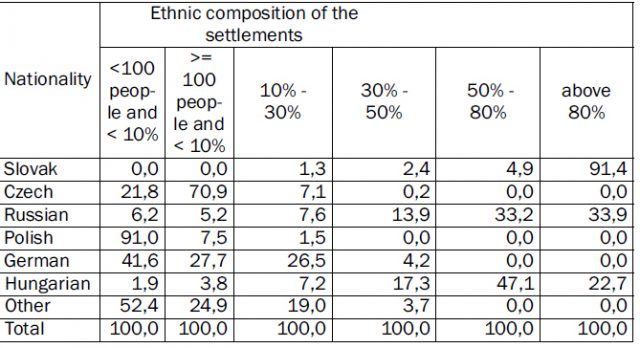
Table 5: Distribution of Slovak nationalities according to the ethnic composition of the settlements, 1950, %
The ethnic structure of the nationalities living in Slovakia is further examined according to the size groups of the number of nationalities living in the settlements. (Diagram 9) That is, we focus on how the settlements inhabited by each nationality are distributed according to the number (size groups of the number) of the nationalities living in the villages, as well as on how high the population of each nationality is in these settlements. In the first approach, the size groups of nationalities living in the settlements were considered according to the same system of categories as the one applied in Chapter 1.2.13 In this approach, in the case of Poles and Germans, we found only a very small number of settlements where their number was more than 199. Therefore, we developed a more appropriate category system for the purpose of our study. That is, the first, smallest range of the previous category system, from 0 to 199 people, was further divided into smaller units. (We created the following categories: 1; 2-4; 5-9; 10-19; 20-49; 50-99; 100-199.) The formation of the new categories follows the logic of the previous category system. As a result, the distribution of individual nationalities can be traced by groups of up to a few people in each settlement. (See Diagram 9, and also Table F5 in the Appendix)

Diagram 10: Distribution of settlements inhabitated by nationalities according to the sizegroups of the nationalities living there in 1950, %
The data show that the data of the Slovak population are closest to the normal distribution. The largest proportion (35.3%) lives in communities with 200–499 and (25.8%) in settlements with 500–999 people per settlement. In the case of Hungarians, also the group of 200–499 people is the largest, but this is followed by scrap groups of 1 and 2-4 people (16.2% and 14.9% respectively), only followed by groups of 500–999 people (11.7%). In the case of other nationalities, shreds of low numbers in each sett lement are the most numerous.
Among Russians, shreds of 1 and 2-4 people are the most numerous (36.2% and 16.6% respectively), then the categories with 5–499 people occur in almost identical proportions (their proportions are between 5.7% and 9.4% respectively) In the case of scattered nationalities, it can be observed that shreds of 1 and then 2-4 people are the most common, their number decreases rapidly as moving on towards larger communities. In the case of Poles and Germans, the proportion of 1-person shreds in the settlements inhabited by these nationalities is approximately 55.3% and 40.1%, respectively, and the proportion of 2-4 people is more than ¼.
Next, we examine the distribution of the number of persons belonging to natio nalities according to their size groups in the settlements.

Table 6: Distribution of nationalities in settlements inhabited by nationalities according to the size groups of nationalities living there 1950,%
In the case of Slovaks, we can observe that in those settlements where their number does not reach 200, their proportion is very low. As the distribution of Slovaks follows national trends to a very large extent, these cases are mainly small dwarf villages. The majority of Slovaks lived in communities between 500 and 4999 (58.1%), the vast majority of which are villages, but the proportion of Slovak communities in small, medium and large settlements is also relatively proportional (5000–19999 people: 14.6%, 20,000–99,999 people: 5.8%, over 100,000 people: 5.8%).
Almost 1/4 of the Czechs (23.1%) lived in communities of less than 100 people, more than 1/3 (39.1%) in communities of 100–999 inhabitants, 14.8% in communities of 1,000 and 4,999 residents, and 23.0% (9,296 people) – equal to the population of a small town – lived in Pozsony (Bratislava) alone. 83.0% of Russians lived in settlements with numbers ranging from 100 to 9999. 14.9% lived in localities with less than 100 people, and 2.1% in places with numbers between 1,000 and 1999. In the case of Poles, the very contrary process can be observed: the largest number lived in shreds of 2-4 people (22.0%), after that their number decreases, 4.8% lived in communities of 50–99 people. Most of them lived in Pozsony (Bratislava) (135 people, 7.5%).
In the case of the Hungarian population, we can also observe that with the increase of their number is accompanied by an increase in their proportion in the loca lities. 4.1% of Hungarians live in localities numbering 100–199 Hungarians, and their number is growing rapidly in the following size groups. Most (27.8%) of them lived in communities of 500–999, their share decreased slightly in the next two size groups, and then their proportion in communities between 5000–9999 was 6.1%. The number of Hungarians exceeded 5,000 in three cities: Gúta (Kolárovo) (7748 people), Komárom (Komárno) (7077 people), Pozsony (Bratislava) (6823 people).
The proportion of Germans is also increasing almost continuously in successive size groups. The largest number lived in the groups of 200–499 (26,6%) and 1000–1999 people (20.3%).
Summary and outlook
In 1950, 20 years after the 1930 census, the first post-World War II census took place. The so called ”községsoros” (see Footnote No 4) ethnic data were not known as they were not published. The nationality data sets of the census bear the imprint of the events of the long 40 years in the evolution of the number of individual nationalities. The registered data showed the number of Hungarians and Germans significantly lower than their expected number, while that of Slovaks significantly higher. Even if they reflect the real ethnic conditions in a distorted and questionable way, the data series indicate a very large transformation of the ethnic structure: the composition of settlement patterns of demographically negatively affected nationalities has changed signi ficantly; the number and proportion of Hungarians living in cities, Hungarian-majority administrative units and settlements, Hungarian communities living in the settlements decreased, the ethnic bloc areas with significant dimensions in the 1930s became fragmented, their borders blurred, and signs of scattering appeared. The discussion of these changes, however, is a subject of further research.
Literature
Administrativní lexikon obcí republiky Československé 1955. Podle správního rozdělení 1. ledna 1955. Praha, Státní úřad statistický a ministerstvo vnitra.
Gyurgyík, László 1994. Magyar mérleg. A szlovákiai magyarság a népszámlálási és a népmozgalmi adatok tükrében. Pozsony, Kalligram.
Gyurgyík, László 2011. A szlovákiai magyar lakosság demográfiai változásai 1949 és 1963 között, különös tekintettel a népmozgalmi folyamatokra In: Hushegyi, Gábor (szerk.): Magyarok a sztálinista Csehszlovákiában 1948–1963. Pozsony/Bratislava, Hagyományok és Értékek Polgári Társulás, 26-41.
Retrospektívny lexikon obcí ČSSR 1850-1970, 1978; počet obyvatelů a domů podle obcí a částí obcí podle správního členění k 1. lednu 1972 a abecední přehled obcí a část obcí v letech 1850-1970. 2. diel: Abecedný prehľad obcí a částí obcí v rokoch 1850-1970. 2. zv., Slovenská socialistická republika. Praha, FŠÚ.
Sčítání lidu v republice Československé ze dne 1. prosince 1930. Díl I. 1934. Praha, Státní úřad statistický.
The Ethnic Composition of Slovakia’s Municipalities… 33
Sčítání lidu a soupis domů a bytů v republice Československé ke dni 1. března 1950. Nejdůležitější výsledky sčítání lidu a soupisu domů a bytů za kraje, okresy a města. Díl I. 1957. Praha, Státní úřad statistický.
Sčítanie ľudu 1950. Plocha, vek, povolanie, pomer k povolaniu, národnosť a náboženské vyznanie obyvateľstva podľa obcí. Bratislava (Nitra, Banská Bystrica, Žilina, Košice, Prešov), manuscript.
Statistický lexikon obcí republiky Československé 1955 Podle správního rozdělení 1. ledna 1955, sčítání a sčítání domů a bytů 1. března 1950. Praha, Státní úřad statistický a ministerstvo vnitra.
Tišliar, Pavol–Šprocha, Branislav 2017. Premeny vybraných charakteristík obyvateľstva Slovenska v 18.–1. pol. 20. storočia. Bratislava, Muzeológia a kultúrne dedičstvo, o. z. v spolupráci s Centrom pre historickú demografiu a populačný vývoj Slovenska Filozofickej fakulty Univerzity Komenského v Bratislave.
The Primary Results of the last Hungarian Identity Survey in Slovakia
1. Survey and sample
In June 2018, the Department of Sociological and Demographic Research of the Forum Institute of Minority Research and the National Policy Research Institute in Budapest conducted a questionnaire survey in 16 districts of southern Slovakia2 in a total of 120 settlements, as well as in Bratislava and Košice. The sample consisted of 800 adult Hungarians from Slovakia. The sample is representative in terms of gender, age group, education, type of settlement, and the share of the Hungarian population per district in the mixed-population districts of southern Slovakia.
Of the sample 47.2% were men and 52.8% were women. As for the age groups, for the sake of comparability with previous surveys, three age groups were used as the basis for sampling: aged 18–34 (27.4%), aged 35–55 (39.3%), and over the age of 55 (33.3%). Regarding education, 22% of respondents had a primary education, 28% had a high school education without a high school diploma, 34% had a high school diploma, and 16% had a higher education. Regarding the type of settlement, 38% of the respondents live in a city or a town and 62% in a village.
The primary goal of the survey was to monitor the development of national values and national identity, which we have been researching for a long time, as well as the most important background factors and their impact.
In the following, we briefly describe some of the subjective indicators of the respondents’ living conditions, quality of life, and feelings of life; then we characterize their current public attitudes. Afterwards, based on the primary results, we present the most important issues of national values, national identity, and opinions about the Hungarian existence in Slovakia, as well as language use and school choice.
The aim of this paper is to present the preliminary results so that they can be accessed and used by others as source data. Unless otherwise indicated, the results are expressed as a percentage.
2. Living conditions, quality of life, feelings of life
One of the basic factors of the quality of life is health condition. The subjective health condition of the respondents is not the health condition measured by objective me dical devices, but what they themselves perceive. In accordance with this, 75% of them consider themselves to be healthy, of which 31% have not been ill for a long time, and 44% become ill once or twice per year. Moreover, 8% of respondents are often ill but have no major problems, 11% are under constant treatment, and 5% are disability pensioners.
In our previous surveys3, we addressed health protecting and health harming determinants several times within the lifestyle issues. Due to space constraints, only a few of these indicators were included in the questionnaire this time, specifically a few questions about eating habits, sports, and smoking. Regarding eating habits, it is favorable that the majority of respondents (80%) eat regularly, i.e. either three times per day – breakfast, lunch, dinner (56%), or five times per day (24%), supplementing the three meals with 10:00AM and afternoon snacks. The majority most often consume Hungarian (84% often, 15% sometimes) and Slovak meals (37% often, 57% sometimes). The third most popular is Italian cuisine (15% often, 60% sometimes). As for the unhealthy “fast” foods (e.g., McDonald’s), 5% consume them often, 48% sometimes, and 48% never.
The most common way to spend free time is via family programs, namely active social programs, such as joint trips, cooking together, and conversations. These were mentioned by 30.4% of the respondents. This is followed by cultural activities, such as reading, watching movies, listening to music (21.4%), meeting and having fun with friends (18.5%), pursuing a favorite hobby (13%), and lastly playing sports (4.6%). Of the respondents, 12% indicated that they did not have much free time to devote to themselves.
The fact that sport is not a frequent activity is shown not only by its low share among free time activities (barely 5%), but also by the answer distributions of a separate question focused on this. When asked how often they used to do sports in their free time, the results were the following: 5% answered daily, 15% at least three times per week, 49% rarely, and 31% never. “Rarely” (i.e., fewer than three times per week) is also scarce because, according to the WHO, one needs to move for at least 30 minutes three times per week. In other words, 80% of Hungarians in Slovakia move less than is needed. However, 30% smoke (EU average is 28%), of which 15% do so conti nuously or frequently.
The impact of social relationships on the quality of life is well known. With regard to the most intimate relationships (i.e., the family), the majority of the respondents (64%) live in a permanent partnership, mostly married (54%), and the rest in a coha biting relationship (10%). Of the respondents, 23% are unmarried, almost 10% are divorced, and 4% are widowed. In addition, 71% of the respondents have children and 31% have grandchildren.
One of the manifestations of the quality of social relationships is whether there is a person we can rely on in everyday life situations. Of the respondents, 86% have such people in their lives, of which 47% answered that there are more such people, and 39% know about one such person. However, 14% of the respondents do not always perceive this social support, and there are also those (1.3%) who have no one to rely on. Here we would also mention transcendent relationships (i.e., religiosity). Almost 90% of the respondents belong to some denomination: the majority are Roman Catholic (65%), followed by 20.2% Reformed, 2.7% Lutheran, 0.6% Greek Catholic, and 0.5% of other religions. Of them 11% are non-denominational. Regardless of whether or not they used to go to church, 80.4% consider themselves to be religious, 11% non-religious, 3% a staunch atheists, and 3.3% a seekers. Among the religious, the majority are those who consider themselves religious in their own way (48%), and 32.4% consider themselves religious in accordance with the teaching of the church.
Another important indicator of the quality of life is work and everything related to it. While 69% of the respondents work, 31% have no job. According to occupational status, every second respondent is an employee: 28.7% are in the private sector and 21.9% are in the public sector. In addition, 12.7% are entrepreneurs, 7.3% students, and 3.9% unemployed; 20% are retired; 1.8% are on maternity leave; 0.6% care for a
The Primary Results of the last Hungarian Identity Survey in Slovakia 39
sick family member; and 0.4% are homemakers. Of those who have a job, the majority work as subordinates (72%). The proportion of senior managers is 9%, middle mana gers 10%, and group leaders 9%.
How do they relate to their current jobs? Almost two thirds of respondents (64.2%) are satisfied with their current job, although part of them is also excited about other areas and new opportunities (39.7%), and there are those (24.5%) who feel that they have more to offer than they do in their current job positions. An additional 27.4% claim their job is also their hobby. On the other hand, almost 9% are unable to find a job, either because they cannot find any job (4.7%), or because they cannot find a job that matches their qualification and skills (4%).
The next indicator of the quality of life is financial situation. This time, we did not search for objective indicators (income, possession of material goods, etc.) – instead we were interested in the subjective assessment of their financial situation. When asked about the financial prospects of the family, almost three quarters of the respondents (73.2%) commented positively, still considering the financial situation of the family as good (32.7%) or encouraging (40.5%). Regarding the contrasting 17.2%, there are those who still perceive it as bad (15.2%) or alarming (2%). Almost 10% could not answer the question. Excluding these, 81% rate the family’s financial outlook as positive and 19% still find it bad or alarming.
The question of what vision one wanted to realize in the next five years was used to map out plans for the future. There were eight possible answers and more than one could have been chosen. Almost one in four respondents used this option, but the majority (76%) gave only one answer, that is they mainly focus on implementing one of the following plans: 15% want to buy a car and 14% an apartment, 10% want to find a better job, 5% want to start a family, 5% want to study/acquire a profession, 5% want to start a business, and 3% want to find a job. It is noteworthy, however, that most (19%) do not focus primarily on a plan for themselves, but want to act in the public’s interest in some way.
Returning to those who chose multiple responses (different combinations of twos, threes, and fours were circled), most (13%) associated their other plans with resolving the housing situation. Summarizing the combinations of plans for the future, the three most important are resolving the housing situation (in the case of 27% of respondents, this answer was indicated as a single or primary plan), acting in the public’s interest (25%), and buying a car (23%). The following are the additional plans in order of frequency: 15% want to start a family, 13% to find a better job, 12% to study/acquire a profession, 10% to find a job, and 8% to start a business.
Satisfaction with different areas of life is also a reason and a consequence of the quality of life. We listed 12 areas and asked the respondents to rate them on a five-point scale indicating how satisfied they were with these areas in the previous year (i.e., in 2017). The results reveal several things (Table 1). Firstly, 84% of respondents are overall satisfied with their lives, of which 36% are very satisfied and 48% are satisfied. Furthermore, in 10 of the 12 areas assessed, the majority are satisfied (this means “very satisfied” and “satisfied”), ranging from 56 to 91%. Looking at overall satisfaction, they are most satisfied with their friends (91%), spouse/partner (89%), and family life (87%). On the other hand, if we only look at the areas they are very satisfied with, then the spouse/partner comes first (65%), followed by family life (53%), housing situation (46%), and friends, acquaintances (45%). The high level of job and housing satisfaction is in line with everything we have already learned from the answers to other questions: the majority consider their job a hobby or have at least a satisfying job, but there is a smaller group looking for a job or wanting a better job. The majority are sa tisfied with their housing situation, but there are those who regard the solution to their housing situation as their primary plan for the future.
Of the 12 areas listed, earnings are the area with which half of the respondents are satisfied (14% are very satisfied and 37% are satisfied), and the other half are dissatisfied. However, they are the least satisfied with their social influence (43% in total, of which 10% are very satisfied and 33% are satisfied). This means that, in addition to the areas already listed, the respondents are also more satisfied with their success in their workplace, the recognition they receive from others, and their financial situation and earnings than with their social influence. This is also interesting because, in gene ral, we find that people complain the most about their financial situation and earnings. In this case, however, they lack the impact on society the most.

Table 1: How satisfied were you with the following areas last year (i.e., in 2017)? The figures are percentages.
Regarding the next important area in life (i.e., settlement), it was found that 86% of respondents do not want to change it in the next stage of their lives. Rather, they want to live where they live now, mainly because they were born there (51%) and, moreover, because they feel good there (35%). This also reflects a high level of satisfaction,
The last question relating to the quality of life was, if they looked back on their life so far, how would they see it? The responses received again support the above-mentioned results: 89% are satisfied with their lives, of which 34% are fully satisfied and 55% are satisfied for the most part. Dissatisfaction is typical for 11% of respondents, of which 10% are rather dissatisfied and 1% are very dissatisfied with their lives.
3. Public interest
Respondents’ overall interest in political and public events was measured on a five-point scale. The following results were obtained. “Medium” interest is most common (33%); otherwise there are more people who are not interested in politics (46%) than those who are interested (21%).
Nevertheless, 74% still follow the development of public events in the country, even though 31% are not interested in politics. Although the remaining 43% are inte rested in politics, 37.7% do not want to be actively involved. However, in addition to mo nitoring public life in Slovakia, 5% would like to politicize themselves.
Among the specifically defined political events, such as the public issues related to the Hungarians in Slovakia, to Slovakia, and to Hungary, they are most interested in the situation of the Hungarians in Slovakia. Of the respondents, 26% are very interested in this topic, while only 13% and 12% are very interested in issues related to Slovakia and Hungary, respectively. Regarding the distribution of answers, 60% of respondents are very or fairly interested in the situation of the Hungarians in Slovakia, 48% in issues related to Slovakia, and 40% in issues related to Hungary. The lack of interest also varies: 14% of the respondents are not at all interested or rather not inte rested in the situation of the Hungarians in Slovakia, 18% in issues related to Slovakia, and 29% in issues related to Hungary (Figure 1). Respondents are most interested in the events that affect them or relate to their own situation the most, so we cannot talk about a complete lack of political interest but rather about its differentiation determined by the topic and the location.

Figure 1: To what extent are you interested in issues related to…?
However, regarding the interest in issues related to the European Union, not only is differentiation present, but two opposing camps emerge: 51% have a positive and a rather positive opinion, 49% have a negative and a rather negative opinion. (Figure 2)

Figure 2: In general, what is your opinion about the European Union like?
On the question of whether things were going rather in the right or rather in the wrong direction in Slovakia, Hungary, Europe, and the world, 3% could not respond referring to Slovakia, 5.6% to Europe, 8.5% to Hungary, and 10% to the world. Apart from these, considering the development of Slovakia (32.5%), Europe (36.3%) and the world (45.3%), the most common answer was that they are moving both in the right and wrong direction, whereas in the case of Hungary, it is moving rather in the right direction (33.2%). Moreover, 46.5% answered that Slovakia is definitely going in the wrong or rather wrong direction, and 51.2% think the same about Europe, 46.7% about the world, and 26.5% about Hungary. Of the respondents, 21% think that Slovakia is definitely going in the right or rather right direction, 42% agrees referring to Hungary, 12.5% to Europe, and 8% to the world. In summary, Hungary’s direction is assessed most posi tively, much more positively than the development directions of the other three cases. Following Hungary, the second most positive evaluation was given to Slovakia and afterwards to the world. Respondents are most concerned about the future of Europe. (Figure 3)

Figure 3: Overall, are things moving nowadays rather in the right or rather in the wrong direction in Slovakia, Hungary, Europe, and the world?
4. National self-classification
In the field of national self-classification, we examined three characteristics: (1) natio nality (i.e., declared identity, more precisely, of what nationality the respondents consider themselves to be), (2) primary self-classification (i.e., how they would mostly identify in case of a single choice), and (3) primary and secondary self-classification in case they had two choices.
4.1. Nationality – declared identity
Of the respondents, 95.6% declared themselves to be of Hungarian nationality, 3% of Slovak, 1% of Romani, and some of other nationalities (Table 2). In other words, the majority are of Hungarian nationality, which is not surprising, as the target group of the survey was Hungarians in Slovakia. However, it might be surprising that there are Slovaks, too, but this is not a new phenomenon either, as in our previous surveys, we have already faced the fact that among those considered by their environment to be Hungarians, who speak Hungarian perfectly, understand and are able to answer the questions of the Hungarian questionnaire completely, there are also those who, after all, declare themselves to be of Slovak nationality. Not only are the respondents of Hungarian nationality, but the majority of their immediate family members are too.

Table 2: Nationality of the respondents and their immediate family members (%).
As 13.5% of respondents did not indicate the nationality of their mother and 17.5% of their father, it is not possible to reconstruct exactly the extent to which they come from a homogeneous or mixed marriage. However, it can be stated that out of the 80.4% of respondents whose parents’ nationalities are indicated, 95.3% of those who consider themselves Hungarian have both parents of Hungarian nationality (96% have a Hungarian mother and 99% have a Hungarian father), whereas 4.7% come from mixed marriages. Of the small number of respondents who consider themselves Slovaks (20 in total), 60% are children of parents from mixed marriages and 40% come from homogeneous marriages, namely from homogeneous Hungarian and homogeneous Slovak marriages in a 50/50 ratio. Thus, the respondents who consider themselves Hungarians are children predominantly of Hungarian parents, and 4.7% of Hungarian respondents are children of parents from mixed marriages. The respondents who consider themselves Slovaks are children of predominantly mixed or homogeneous Slovak parents, although 20% of them also have (or had) a Hungarian mother and father. Hence it is already true for the generation of the respondents that a mixed couple had a Hungarian child and a Hungarian couple had a Slovak child. In the sample, the latter (i.e., the fact that a Hungarian couple had a Slovak child) is almost five times more common.
The family of the respondents is therefore largely Hungarian. At the same time, similarly to our previous surveys, the decline of Hungarians from generation to generation can be shown this time as well, since the share of Hungarian children and Hungarian grandchildren decreased compared to that of the Hungarian respondents (Figure 4).

Figure 4: Of what nationality do you consider yourself to be? (Excluding those who answered that there is no such person or is of “other” nationality)
4.2. Primary national self-classification
We did not ask what one’s nationality was but we listed 10 options, and from these one could choose with which they best identified. According to this, 37% mostly consider themselves Hungarians in Slovakia, almost 31% Hungarians, and 24% Hungarians in Upper Hungary4/of Upper-Hungarian origin. Moreover, 2.4% identify as Hungarians of Slovak origin, 1% as Hungarians of Romani origin, 1% as Slovaks, and 1% as Roma. In addition, 0.6% consider themselves to be Slovaks of Hungarian or other origin, and 1% of respondents do not identify with any of the above (Figure 5).
These answers also indicate that almost 96% of respondents, as in case of the declared identity, consider themselves Hungarian at the level of primary self-classification too. In particular, the vast majority of them consider themselves to be Hungarians of Hungarian origin, since they did not regard it important to indicate any other origin (Slovak, Romani, or other). The mostly Hungarian origin is also confirmed by the nationality of the parents indicated above.
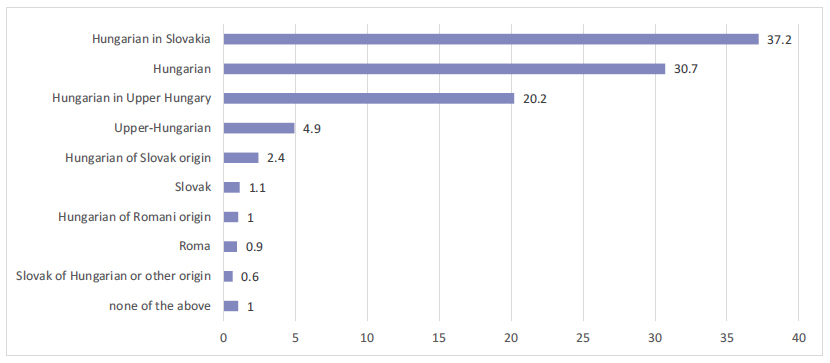
Figure 5: Which option do you identify with the best?
4.3. Primary and secondary national self-classification
If they had not just one, but two options, who would they consider themselves to be? For this question, they could choose from 11 options. Alternatives included “a Slovak citizen” as well as “a European” and “a world citizen” (i.e., the three categories “above” national self-classification, and also the possibility of regional self-classification; from Žitný ostrov, Matúšova zem, Gemer, etc.5). Let us take a look at the results. (Figure 6)
The distribution of the primary self-classification is as follows: 37% Hungarians, 28% Hungarians in Upper Hungary and of Upper-Hungarian origin, 20% Hungarians in Slovakia, 8% of regional identification, and 3% Europeans. The share of those who consider themselves to be primarily Roma, Hungarians of Romani origin, Slovak citizens, Slovaks, and world citizens ranges between 0.4 and 1.6%.
In the case of secondary self-classification, the most common answers appear almost to the same extent: 26% Hungarians in Upper Hungary/of Upper-Hungarian origin, 25% Hungarians in Slovakia, and 24% Hungarians. The extent of regional and European self-identity is almost the same. In both cases it is around 8%, although regional self-classification is slightly more characteristic of the two. Of the respondents, 5% identify themselves as Slovak citizens in matters of the secondary self-classification and 2% as world citizens. The extent for those identifying with the other options is 1% or less.
All in all, in the case when they could choose two options, most of the respondents primarily consider themselves to be Hungarians (37%), followed by Hungarians in Upper Hungary/of Upper-Hungarian origin (28%), and Hungarians in Slovakia (20%); they secondarily consider themselves to be Hungarians in Upper Hungary/of Upper-Hungarian origin (26 %), Hungarians in Slovakia (25%), and Hungarians (24%) to an almost equal extent.
Thus, the primary and secondary self-classifications show the same results as was in the case of only the primary self-classification: the vast majority of the respondents consider themselves to be Hungarians in one way or another, while identifying with different ethnonyms of the Hungarian community – mostly Hungarians, Hungarians in Upper Hungary, and Hungarians in Slovakia.
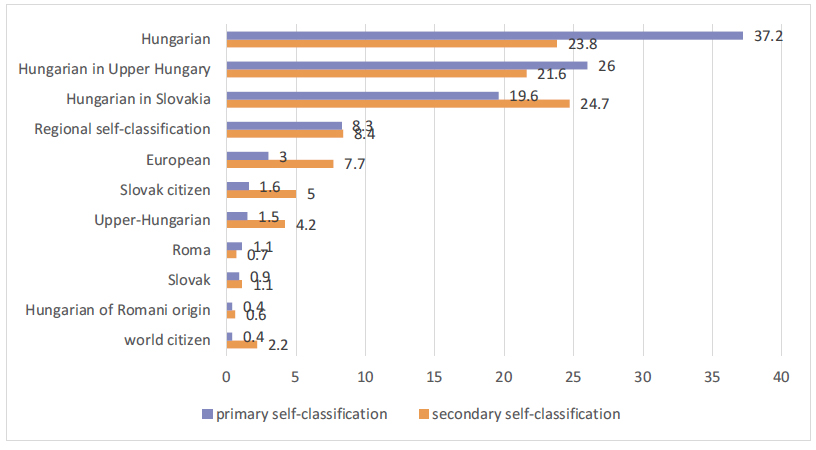
Figure 6: What do you consider yourself to be primarily and secondarily?
5. Opinions related to Hungarian existence and identity
One might think that the decline of Hungarians is a well-known fact in Slovakia (at least in Hungarian circles), but this is not the case. Although the majority of respondents (78.4%) are aware of this, almost 9% could not tell what the situation is like, and 13% were mistaken (i.e., they did not know either), since 9.4% claimed that the number of Hungarians in Slovakia is not changing, and according to 3.5% it increases steadily. So, although the majority are aware of the decline in numbers, almost 25% of the Hungarian respondents do not know where the Hungarian community in Slovakia is heading in terms of numbers.
What determines the national identity of the respondent the most? Of the respondents, 82% say it is determined by mother tongue and culture (Figure 7). Almost 12% believe that national affiliation is a matter of their own decision. In other words, a person’s national affiliation is independent of mother tongue and culture, but also of citizenship. Almost 4% of them agree that a person is of the same nationality as their citi zenship.
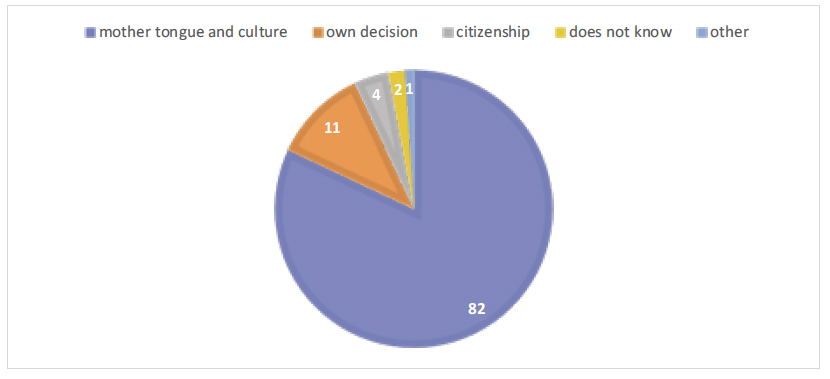
Figure 7: What determines your national affiliation the most?
What does it mean to be Hungarian in Slovakia? Respondents rated eight statements on a five-point scale, with a score of five representing the highest degree of agreement with the statement (i.e., the higher the average, the more they agree with the statement). Of the respondents, 1–2% could not evaluate the individual statements, except “being Hungarian is a political challenge,” “being Hungarian is nothing special,” or “it is dangerous to deal with something like this,” where the ratio of “I don’t know” answers is 3–5.5%. The omission of these answers reveals the following picture (Table 3). If we take as a basis only the proportion of those who completely agree, it also shows that the respondents agree the most with the statement that being Hungarian is natural for them because Hungarian is their mother tongue and they grew up in Hungarian culture (73.2%). Simultaneously 71% are completely proud to be Hungarian, and 63% fully experience their Hungarianness as a responsibility in the sense that they know that Hungarian culture must be preserved in order to survive. Compared to the previous ones, there is much less agreement (35.7%) with the statement that Hungarianness is a political challenge because it is important to live as an organized community. However, this average (3.71) testifies that “being Hungarian = responsibi lity” is evaluated also in a more positive manner, as it falls in the “rather agree” range. The majority do not agree with the statements that nationality is a disadvantage, it does not mean anything special, it does not concern the respondent, or it is dangerous to deal with the issue of nationality.

Table 3: There are various opinions about what it means to be Hungarian in Slovakia. To what extent do you agree with the following statements?
Detailed response distributions are shown in Figure 8. It is also clear from these answers that the majority are proud of their Hungarianness, believe that being Hungarian is natural, feel responsible for it, and perceive it as a political challenge, even though there is a small proportion of respondents that is more neutral or dismissive. Just as there are those who agree that it is a disadvantage for them to be Hungarian in Slovakia because as a minority it is more difficult for them to prove successful and/or they are not preoccupied with their nationality, moreover they think that it is dangerous to deal with such things. In other words, although the attitude towards the above-mentioned indicators of Hungarian existence is largely positive, there is a kind of divergence.
All this is in line with our previous results6, according to which three national value systems of the Hungarians in Slovakia can be detected: the resolute, the receding, and the rejecting national value systems.

Figure 8: What does it mean to be Hungarian in Slovakia?
Figure 8 shows that 61% of the respondents reject the statement that being Hungarian hinders their success in Slovakia, almost 20% both agree and disagree with it, and almost 20% also accept it. In other words, according to every fifth respondent, being Hungarian is more of a disadvantage because that is the reason for why they cannot prove to be successful. In this regard, there was another question in the questionnaire: “In your opinion, is it an obstacle to prove successful in Slovakia if one is Hungarian?” The answers show that 73% say that being Hungarian does not hinder their success. Moreover, 4.5% of them believe that not only is it not a disadvantage, but it is a direct advantage. However, those respondents (21.5%) who think that being Hungarian is a disadvantage also reappear. According to half of such respondents, Hungarianness is an obstacle in all fields, and according to the other half, it is only an obstacle in certain specific fields. Like in our previous surveys, by the specific field most people understand that it is more difficult to enter into public administration, or more precisely into any sphere where you need to know Slovak well, as a Hungarian. Thus, the disadvantages mentioned by them are not really related to Hungarianness, but to the inadequate knowledge of the Slovak language (which, in turn, is associated with the Hungarian-language schools where, in their opinion, it is not possible to learn Slovak). In this respect, there are significant differences on the basis of education: the more uneducated the respondents are, the more they consider Hungarianness to be an obstacle to their success, and the more educated they are, the less they consider Hungarianness to be an obstacle to their success. In fact, they even regard it as an advantage.
After what has been said, the question almost arises as to whether or not Hungarianness should be taken on, and if so, in what situation. The majority of the respondents (81.8%) consider it necessary to take on Hungarianness, while 16.8% answered that they do not usually deal with this issue, and 1.6% say that they do not know in what situation it should be taken on. Those who think that it should be taken on are divided into two groups. One group (54%) considers it necessary to take on Hungarianness in all situations, even if there is a disadvantage. The other one (27.5%) makes the commitment of Hungarianness conditional: 19.5% claim it should be taken on when one does not feel threatened, 7% when it suits the person, and 1% when there is an advantage from it.
Our previous surveys also support the fact that the acceptance of Hungarianness in practice is influenced by how important the factors related to the value dimension of national identity are for those concerned. The more important it is for someone to be Hungarian, for their descendants to remain Hungarians, for them to speak Hungarian, for their child to attend Hungarian-language primary school, and so on (we listed 13 factors in the questionnaire), the more likely it is for them to make decisions that strengthen the Hungarian identity in the decision dimension of national identity. The reverse is also true: the less important, that is, of less value it is to them, the more likely the decisions that generate assimilation are. The importance of the 13 factors to the respondents was measured on a five-point scale, with a score of five representing maximum importance. Table 4 shows the averages of the evaluations of each factor. From these, we can conclude that the assessment of all factors falls between the “very important” and “fairly important” range, with the exception of two: Hungarian young people should find a Hungarian partner and Hungarians in Slovakia should have dual citizenship (the latter mostly falls in the “both important and not important” range).

Table 4: How important do you consider the following factors?
Table 5 shows the factors in descending order of importance and presents the “very important” and “not important at all” response distributions representing the two endpoints of the scale. According to these, the respondents consider it most important to preserve their Hungarianness (very important for 73.2%) and for there to be Hungarian-language primary schools (very important for 71.6%). This time, too, the least important thing is for Hungarian young people to find a Hungarian partner and for Hungarians in Slovakia to have dual citizenship – these two are also the most unimportant factors for them. These results are consistent with the results of our assimilation research conducted on a sample of 3,000 in 2014, where these were the two most important and two least important factors too.

Table 5: How important do you consider the following factors?
Thus, almost three quarters of the respondents consider it very important that he or she remains Hungarian as an individual. However, what about the community of Hungarians in Slovakia? Should the Hungarians survive or melt into the Slovak nation? (Figure 9) The majority (81.6%) vote for survival, as they completely agree that Hungarians should preserve their language and culture. Three out of four respondents completely reject the Hungarians’ adaptation and integration into the Slovak nation.
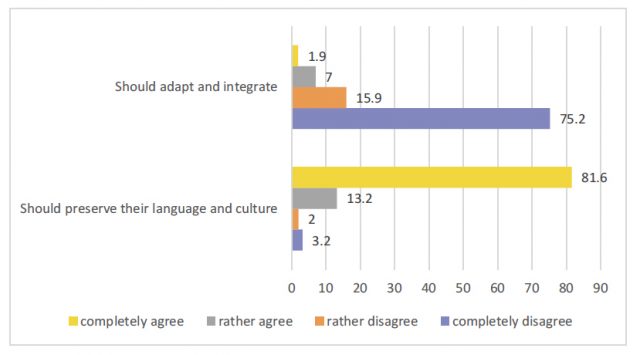
Figure 9: To what extent do you agree with the following statements?
They share a similar view on whether the representatives of national minorities should strive to preserve national identity. Almost all of the respondents (95%) answered that they should. The majority of them (86.7%) also claim that the state should support national minorities in preserving their identity, while a further 8.2% of those who agree assert that efforts should be made to preserve national identity but without the support of the state. In addition to those who consider the preservation of national identity important, there is a group amounting to 5% who state that efforts to preserve national minorities are unnecessary or downright inappropriate.
Moreover, on whom does the survival of Hungarianness in Slovakia depend the most? According to 92.3% it depends on the Hungarians themselves: according to 66.2% of them generally on Hungarians, according to 15.6% on Hungarian parents, and according to 10.5% on Hungarian young people. The Slovak state can contribute 4.5% and the Hungarian state 1.2% to the survival of the Hungarians, the Party of the Hungarian Community7 1.7%, and Most-Híd8 0.3%. This means that the individual primarily guarantees survival.
At the same time, we received much more restrained answers to the question of how the respondents themselves would contribute to the survival of Hungarians in Slovakia. Only fewer than half of the respondents (42.7%) believe that they can contribute to the survival of the Hungarians with something particular. The majority claim either that they cannot contribute (28.5%) or that they do not know how to contribute (29%).
6. Language use and school choice
In the previous chapter, we talked about how important the respondents consider the values of preserving the Hungarian identity, including the use of mother tongue and the preference of a Hungarian-language primary school for Hungarian children. As a reminder, 69% consider it very important to speak Hungarian and 54% to have Hungarian signs in their settlement. At the same time, almost 72% think that it is very important to have Hungarian-language primary schools in Hungarian-inhabited settlements. In the following, we take a look at how these preferences are reflected in practical life. In other words, we examine how characteristic it is of the respondents to use the Hungarian language and to have their children enrolled in a Hungarian-language primary school.
6.1. Family and public language use
Regarding the family language, in their childhood the respondents predominantly used Hungarian: in the case of 92% the parents spoke Hungarian with the respondents, and in the case of 5% the parents preferred Hungarian. In addition, 2% mentioned that Hungarian was spoken at home as often as Slovak, and 1% said that they spoke Slovak or preferred Slovak. These data support not only the Hungarian nationality, but also the Hungarian origin of the majority of the respondents. Simultaneously, we can conclude from them that the majority of the 20% of the respondents who did not indicate the nationality of one or both parents are probably also the children of a homogeneous Hungarian couple or at least of parents from a mixed marriage who use the Hungarian language exclusively or predominantly.
Before characterizing the current language use, it is necessary to determine the ethnic structure of the wider environment of the respondents, as this influences both family and public language use (Figure 10). By wider we mean the wider family, colleagues, friends, neighbors, bosses, and business partners. These are the people with whom they are likely to come into contact most often, as well as the most influential and popular people in their settlement who have a certain degree of influence regarding formal and informal opinions.
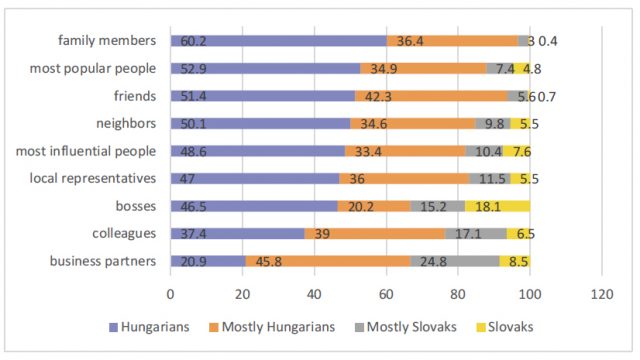
Figure 10: Of what nationality are the people listed below?
Most of these people in the respondents’ environment are Hungarians or mostly Hungarians. The environment consisting only of Hungarians is most characteristic of the wider family (the nationality of the wider family members is Hungarian in the case of 60%); it is the least characteristic of business partners, 21% of whom are Hungarian. Roughly half of the most popular people, friends, and neighbors in their settlement are Hungarian. The proportion of Hungarians among the most influential people, local representatives, managers, colleagues, and business partners falls below 50%, but in all cases it is mostly a Hungarian environment. The mostly Slovak or Slovak environment is largely characteristic of the workplace and the general area of work, mainly of the business partners, since one in four of them is mostly Slovak and 8.5% of them are Slovak. A third of the bosses are also mostly Slovak and the same is also true for almost a quarter of colleagues. Here we would like to note that the attitude of the respondents towards Slovaks is largely positive: 28.6% claim it is very good and 38% say it is good, whereas only 7.2% consider their relationship with Slovaks to be rather bad or bad.
The current family and public language use of the respondents therefore takes place in the ethnic/linguistic environment outlined above. The data show that the domi nant language of the family is currently Hungarian (Table 13), as some family members primarily use Hungarian in mutual communication. This is most characteristic of the mutual communication of the respondent and their parents (96 and 94%, respectively), the respondent and their siblings (93%), and the grandparents (i.e., the parents of the respondents) and their grandchildren (i.e., the children of the respondents; 92 and 94%, respectively). Regarding the youngest generation, in the communication between the respondent and their grandchildren (85%) and in the mutual communication between the respondent’s grandchildren (80%), the use of Hungarian is less frequent than in previous generations, but in these cases the most frequently spoken language is Hungarian.

Table 13: Current family language use.
In the survey of public language use, we focused on 13 areas that we considered most important and previously researched (Table 14). Three of them are characterized by mixed (Hungarian-Slovak) or rather Slovak language use. These three areas are: dealing with official matters (81% mixed or rather Slovak communication), doctor visits (61%), and addressing strangers (52%). The other areas are characterized by communication in mostly Hungarian (only Hungarian or rather Hungarian), although not to the same extent. The extent of use of only Hungarian or rather Hungarian is between 54% and 94%. The upper limit is communication with priests, with whom 94% of respondents speak mostly Hungarian (of which 92% speak only Hungarian and 2% rather prefer Hungarian). The lower limit is shopping, when 54% speak mostly Hungarian (of which 32% speak only Hungarian and 22% rather prefer Hungarian). The mayor is the second most common person, with whom they speak mostly Hungarian (87%), but in municipal authorities this proportion drops to 77%. The third area of the mostly Hungarian language use is in school, where three quarters of the respondents indicated only Hungarian, and 5% indicated rather Hungarian. Table 14 shows the 13 communication areas in descending order of the extent of Hungarian language use.
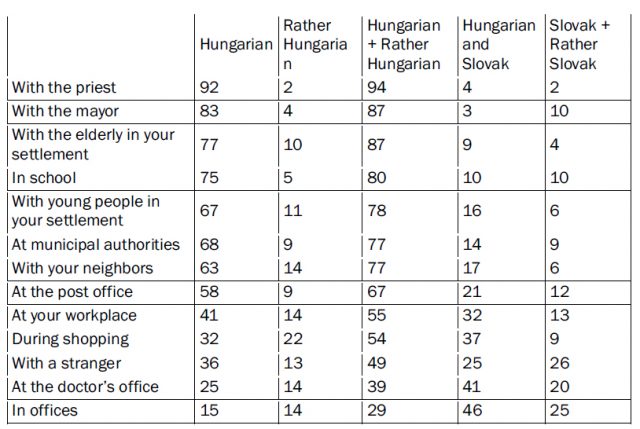
Table 14: Areas of public language use. The figures are percentages.
In further questions on language use, we discussed how tolerant the respondents are of non-Hungarian language use. The data show a high degree of tolerance. The majority of respondents are not bothered at all when someone in the family speaks another language (81%), just as they are not bothered by someone from the mixed population in southern Slovakia who speaks another language in public (94%). In addition, 62% absolutely tolerate when Hungarians in Slovakia mix Slovak words into their speech, and 56% tolerate it when they mix English words into their speech.
Regarding the use of visual language on public signs in southern Slovakia, 83% of the respondents are not bothered at all by Slovak signs and 74% are not bothered by English signs (e.g., “showroom” or “shop”).
The presence of bilingual Slovak-Hungarian signs in public places in southern Slovakia is considered to be very important by every second respondent, and 26% regard them as important. For every fourth respondent, this is rather not important or not important at all.
6.2. School choice
As we know, almost 96% of respondents are of Hungarian nationality. However, only 90% completed a Hungarian-language primary school, while 91% of their fathers and 94% of their mothers attended a Hungarian-language primary school.
Of the respondents who completed the following types of school and of those who completed them in Hungarian language, 55% graduated from vocational training school, 65% from vocational secondary school, 88% from grammar school, and 38% from college/university. Moreover, 48% received post-secondary vocational training in Hungarian (including a bachelor’s degree for undergraduate studies) and 20% received tertiary higher education or its equivalent (PhD, MPH) in Hungarian.
After these facts, let us take a look at how they contemplate school choice (Table 15). First of all, what kind of primary school should a child of a Hungarian and a mixed couple attend? Although 90% of respondents have finished a Hungarian-language primary school, only 74% resolutely state that a child of Hungarian parents should attend a Hungarian-language primary school. Few people agree with their child attending a Slovak-language primary school; however, 22% of the respondents are somewhat uncertain and indecisive about the issue, even if they are more inclined towards a Hungarian-language primary school. In the case of a child of a Hungarian-Slovak parent couple, 27% could not express an opinion, whereas those who could preferred a Hungarian-language school in their answers.

Table 15: Considering the language of instruction, which primary school should a child of Hungarian parents/Hungarian-Slovak parents attend? The figures are percentages.
Afterwards we asked whether they agreed or disagreed that a Hungarian child should attend a Hungarian-language primary school. The results show that 92% agree, mostly because they consider it important for the child to learn in their mother tongue (53%). The second most important reason was that it is easier to learn in one’s mother tongue (22%). In addition, 9% claim that the child should attend a Hungarian-language primary school because they will be more connected with Hungarian culture, 5% state that they will preserve their roots thanks to a Hungarian-language primary school, and 3% say that a Hungarian child should attend a Hungarian-language primary school because they will learn neither Slovak nor Hungarian correctly in a Slovak-language primary school.
However, 8% of respondents think that it is not good for a Hungarian child to go to a Hungarian-language primary school because they will not learn Slovak (5%) or it will be more difficult for them to prove successful (3%).
In these cases, we considered opinions. Now let us take a look at what the reality is (i.e., regarding the language of instruction), in what kind of school the respondents with children of this age enrolled their children (Table 16).
A child of Hungarian parents A child of a Hungarian-Slovak parent couple Hungarian 74 22 Rather Hungarian 18 38 Rather Slovak 4 11 Slovak 1 2 They do not know 3 27
The Primary Results of the last Hungarian Identity Survey in Slovakia 59

Table 16: Considering the language of instruction, what school (or schools) does (or did) your child (or children) attend? Multiple answers are possible in each line! The figures are percentages.
Much can be interpreted from the data, but at this time we will focus on just a few aspects, primarily the choice of kindergarten and primary school. Firstly, it can be observed that the majority of parents contemplate either a Hungarian or a Slovak kindergarten/primary school. There is a negligible number of parents who would alternate these educational institutions in the sense that they enroll their child first in Hungarian and then in Slovak institution (or vice versa), and also in the sense that, in the case of several children, one would be enrolled in a Hungarian kindergarten/school and the other in a Slovak one. Secondly, 85.7% of the respondents send or sent their child to a Hungarian kindergarten and 87.3% to a Hungarian primary school, which corresponds with the majority. However, if we compare these proportions with the Hungarian-language school attendance of the responding parents and their parents, we can observe the seemingly small “generation gap” of at least 3%, which is just enough to contribute to the weakening of the national identity of Hungarians in Slovakia due to preferring a Slovak-language primary school when choosing a school and consequently also to the continuous decline in their numbers.
From the free answers/explanations following the closed questions, it became clear again that several factors play a role in the choice of a Slovak-language primary school. It is mainly the case when at least one of the Hungarian parents attended a Slovak-language primary school or one of the parents is of Slovak nationality (i.e., they are a mixed couple). However, these correlations do not change the essence of the matters – they even re-support what we have revealed in our previous surveys: in addition to origin, school choice, and language use, choice of partner is the fourth key factor of national identity. Furthermore, the geographical distance of a Hungarian-language school is only one of the many reasons for choosing a Slovak-language primary school.
Translation by Beáta Izsófová
Language Problems, Language Related Social Problems, Metalinguistic Activities
1. Introduction
Just like anywhere else in the world, also in Slovakia, the language users or whole language communities face numerous bigger or smaller language problems. The project called “Language and Communication Problems in Slovakia and Their Management”2, which was launched in August 2018 and is to last until July 2022, aims at uncovering various types of language problems as well as concomitant communication problems which speech communities in Slovakia face, with a special regard to the Slovak community as the majority community, then to the Hungarian and the Roma communities, which are minority communities with a substantial number of speakers, finally the community of the Carpathian Germans as a small community. Within the Slovak community the problems which the researchers are dealing with include the problems of the use of standard Slovak and Slovak dialects as well as language problems related to teaching Slovak in the minority communities. As to the minority communities the researchers are investigating various kinds of language and communication problems in these communities and making propositions concerning the ways of their management. The project also includes theoretical and methodological questions concerning the investigation and management of language problems and their ideological determinants.
The theoretical background for the project as a whole is the Language Management Theory (LMT), more exactly the expansion of the LMT on the basis of the management theories of other types of problems3 and application on the Slovak linguistic and social context. LMT was developed by J.V. Neustupný and B.H. Jernudd in the 1970s and 1980s as a more comprehensive alternative of the Theory of Language Planning.4
The management of language problems in Slovakia has not always been based on scientific principles and approaches so far, it has either been spontaneous or politically manipulated, and some of the problems have not been tackled at all. By the application of scientific principles and approaches the research team wants to achieve that the experience with the general problem solving as well as language problem solving in different communities be used in the management of language problems in Slovakia.5
The project topic is being approached from two perspectives: the first is the theoretical base for the whole research and the other is the application of the theoretical concepts. This paper aims to be a contribution to the theoretical base of the project, by trying to answer the question what kinds of problems LMT or a new theory of language problem management should deal with.
2. The scope of LMT
As can be seen from the above description of the project, the key concept of the project is that of “language problem”. This concept is of utmost importance for any theory which aims at dealing with the management of problems connected in some way to a language or to languages. The traditional definition of “language problem” in LMT – a negatively evaluated deviation from the norms or expectations concerning the verbal, communicational and associated socio-cultural behaviour of the participants in a particular interaction6 (cp. e.g. Nekvapil 2006: 97, 2009: 3, 2012: 160) – may be suitable for the small-scale simple management of inadequacies, but it seems much less satisfactory for the small-scale or large-scale organized management of metaproblems occurring trans-situationally.7 If we want to be able to define the “language problem” in a more comprehensive and at the same time more elaborate way, we must start with more general questions of how to delineate the scope of LMT, i.e. we should answer the question: What kinds of language problems should LMT be concerned with?
2.1. Language problems proper
We may possibly limit “language problems” to those instances when changes in the discourse or in the so-called language system8 are being brought forth predominantly for linguistic and communicative reasons. That means that the foremost goal of language managing activities is to enhance the quality of communication or eliminate miscomprehension in communication.9 Of course, speaking in a different way in order to communicate more efficiently is usually not the ultimate aim of the interaction, only a means to achieve some other, non-linguistic aim, so it may not be simple to separate this group of problems from those below. One would think, for instance, that creating a standard language has purely linguistic and communicative goals, i.e. to be able to communicate within a language community in the most efficient way, yet we know that often there is a hidden or unhidden agenda behind it, e.g. nation building, gaining poli tical independence, elite closure etc. (Cf. Milroy 2001: 534–5)
This group of problems best conforms to the traditional definition of “language problem” in LMT: they usually manifest themselves in deviations from the norms (even if it is not always simple or even possible to identify these norms). Some of these problems can be successfully managed within the simple management, especially the micro level inadequacies. E.g. correcting a slip of the tongue has evidently purely linguistic and communicative reasons: to ensure the grammaticality, stylistic adequacy and comprehensibility of the discourse.
The requirement of the goals being predominantly linguistic does not mean that the means of accomplishing them should also necessarily be “linguistic”. On the cont rary: it is duly emphasized in LMT that successful treatment of language problems – especially those which are handled within large-scale organized management – involves intervention into a number of fields outside linguistics. For instance to incorporate new terminologies into a language will not be successful if it consists only of coining new words and phrases and no attempt is made to disseminate them during the implementation phase of the LM process. (Cf. Hübschmannová–Neustupný 2004) Dissemination inevitably requires managing the outside world, not the language itself; something what Neustupný and other proponents of LMT call communication ma nagement and socioeconomic or sociocultural management. (See e. g. Neustupný–Nekvapil 2003: 186 and passim; Nekvapil 2009: 8–9; Neustupný 2012: 299) The management of many problems involves also the management of concurrent language ideologies.
2.2. Language related social problems (where intervention is needed)
Since the borderline between language problems proper and other kinds of language related problems is blurry, it may seem feasible to extend the concept of “language problems” to include those non-linguistic – social, political, educational, cultural, religious, etc. – problems the management of which requires changes in discourses or ultimately in the so-called language system, even though the real goals are clearly non-linguistic and non-communicative, e.g. lessening discrimination based on unequal allocation of power by “PC talk” or giving a new name to an Australian “rat-like” animal in order to save it from extinction 10.
I would definitely argue for including this type of problems among the issues which should be managed within the LMT framework. One of the arguments is the intent of bringing forth language changes. It seems expedient that all interventionist approaches should be considered part of LMT. Although these problems probably seldom manifest themselves in deviations from the linguistic and communicative norms, they clearly demonstrate the participants’ “behaviour towards language” (see below) and so they are legitimate object of interest of experts in LMT.
Another argument in favour of the inclusion of this type of problems among language problems to be dealt with in the LMT framework is the great social utility of ma naging language related social, political, educational, cultural, religious etc. problems. As we know from critical discourse analysis and other critical approaches, language helps to create and sustain a lot of social injustice. Eliminating or alleviating social injustice is a non-linguistic goal, but it can be fostered by linguistic means, which may require changes in discourses and even in the language system. This should therefore be considered part of LMT, even if most laymen do not realize that discriminatory language use is a problem11, and so these issues cannot be comfortably tackled within the “problem-is-what-the-layman-perceives-as-problem” paradigm.
Finally, as was suggested above, the large-scale metaproblems are seldom purely linguistic and communicative, they usually (maybe always) have social consequences; this is also a reason why LMT and other possible language problem management approaches should be concerned also with that kind of social problems the management of which entails intervention into discourses or language ideologies.
2.3. Language related social problems (where no intervention is needed)
Theoretically, we have the possibility to extend the category of LM even further, to every language-oriented act (or dealing) which reflects any possible form of “behaviour toward language”, not just interventional behaviour.
“Behaviour toward language” as opposed to ordinary “language use” is mentioned as a matter of course in the works about LMT. (See e.g. more recently Sloboda et al. 2010: 95–6; Nekvapil 2011: 880; Marriott–Nekvapil 2012: 155; Nekvapil–Sherman 2013: 91) It is not clear, however, what this ready-made term is to denote exactly. Although in theory the authors claim that language management covers all forms of “behaviour toward language”, i.e. all forms of metalinguistic activities (see Neustupný 1994: 52; Nekvapil 2009: 2; Dovalil 2013: 150), when specified, the authors usually have interventionist activities in mind. E.g. Nekvapil and Nekula (2006: 310) explicate “behaviour toward language” as “the activities aimed at the production and reception of discourse, that is, metalinguistic activities”. Activities aimed at the production and reception of discourse as metalinguistic activities, are undoubtedly interventionist activities (since ordinary language production and reception is not a metalinguistic activity), however, “metalinguistic activities” do not subsume only these two, but also metalinguistic reflection, i.e. thinking and consequent talking about language (including all linguistic research aiming at the description of discourses and language, with no intention to bring about changes in them).
A non-self-contradictory explanation of what “behaviour-toward-language” means, can be read in the announcement of the 3rd International Language Management Symposium, which defines language management “as any sort of behaviour toward language, in other words, the various forms and manifestations of attention devoted to language or its use.” It goes without saying that “attention devoted to language or its use” includes also non-interventional metalinguistic activities like “innocent” reflexions about language and language use.
According to the cited statements all metalinguistic activities could be said to be the object of language management, including thinking and talking about language matters without the slightest intention to change anything in the discourses or in the language. In this case LMT should have concern – among others – towards problems dealt in forensic linguistics (Gibbons 2004, 2007; Coulthard–Johnson eds. 2010), like e.g. analysing the language of a blackmailing letter to find the blackmailer or deciding on the basis of a linguistic analysis whether a statement was a slander (and thus a language crime) or not, even if the management of such issues does not require intervention into the language. (Nobody would think of re-writing the blackmailing letter not to be blackmailing or a slanderous statement to be void of slander, let alone change the language in a way that no blackmailing letters or slanderous statement could be produced in it.) And we could go even further and present – say – Quirk’s A comprehensive grammar of the English language as a monumental example of language management effort – after all, a written grammar definitely belongs among “[v]arious forms and mani festations of attention devoted to the generation of sentences or communicative acts”. (Marriott–Nekvapil 2012: 156; see also Marriott–Nekvapil 2012: 155)
Since probably no proponent of LMT would like to go thus far, I tend to think that all non-interventionist metalinguistic activities should be excluded from LMT. In fact, actually they are not included, but theoretical definitions of LMT and the delimitation of “behaviour-toward-language” should be put in line with the practice. So broadly conceived language related problems do fall within the scope of applied linguistics, which shares with LMT its central interest in language problems (Davies–Elder 2004: 1–4, 11; Davies 2007: 158), but applied linguistics does not necessarily aim at bringing about changes in discourses or the language system.
4. JAKOPROS and language problems
Language problems dealt with in the project mentioned in the Introduction are typically unstructured, large-scale metaproblems called also “wicked problems”,12 which have to be managed in an organized way. Both in respect to Slovak and in respect to the mino rity languages (Hungarian, Romani, and German) the focus is on the problems of mino rity speakers, whose variety or language is in some way stigmatized.
On the one hand the speakers of Slovak dialects (as opposed to the speakers of the Slovak standard) suffer discrimination, since the standard is the preferred variety considered “correct” and adequate to be used in public spaces; this way they can be considered a minority because of lack of political and social power to promote their interests. (Cp. Skutnabb-Kangas 1990) On the other hand the speakers of minority languages (as opposed to the speakers of the majority language, which is Slovak) are disadvantaged in many respects. Speakers of dialectal Hungarian and German (who constitute by far the greatest part of these speech communities) suffer double stigmatization: their varieties are considered less valuable both in respect to the Slovak language as such and the Hungarian and German standard, respectively. As far as Romani is concerned, the absence of a well-known standard variety prevents the speakers from feeling doubly stigmatized.
Though the management of the large-scale metaproblems is alleged to be based on the management of small-scale inadequacies in face-to-face communication in LMT, some of the ways of small-scale simple management of these problems are evidently unacceptable on the level of large-scale organized management.
One example may be suppressing dialectal features in face-to-face communication to prevent stigmatization, as a small-scale simple management of the problem. On the level of large-scale organized management the change of language ideologies should be fostered as the best solution: linguistic standardism should be replaced – or rather supplemented – by linguistic vernacularism, using additive approach to mother tongue education, i.e. considering the standard as a valuable variety which is to be added to the equally valuable vernacular variety without replacing it.13 As we can see, the small-scale and the large-scale management are based on completely different attitudes: the small-scale management aims at preventing the problem by changing the linguistic behaviour, not dealing with the discrimination, while the large-scale management seeks to eliminate the discrimination.
Another example is using occasional code-switches into Slovak or ad-hoc paraphrases in the first language to fill in a language lapse or a language gap.14 These are often applied communicative strategies in Hungarian, Romani and German speech communities and as a matter of fact they solve the problem very successfully – in the framework of small-scale simple management of inadequacies in face-to-face communication. However, this strategy is not applicable at all in large-scale organized management of the “language lapse” or “language gap” metaproblem. One of the ways to ma na ge these problems in the framework of large-scale organized management is to widen the scope of mother tongue education and of the bilingualism in these communities, so that the minority speakers would be exposed to the first-language equivalents of the Slovak words, phrases or grammatical structures, or (if they are already exposed to them to some extent), to substantially increase this exposition. (Lanstyák–Szabómihály 2005: 65, 2009: 62–64; see also Hübschmannová-Neustupný 1996) Again we can see that the small-scale management and the large-scale management are completely different.
The metaproblems mentioned above seem to belong to the first category of problems dealt with in Section 2.1. (language problems proper), since they all have to do with the “quality” of the communication, the way the discourses are formed, the difficulties the speakers come across when forming these discourses because of their restricted competence in the standard variety in the first example or in their first language in the second example. However, since their way of speaking is often stigmatized, the language problem is embedded into a social problem and thus the whole “package” can be said to be a language related social problem.
This way the examples presented above affirm our contention that both language problems proper and language related social problems requiring intervention into the “language” should be the object of language problem management in LMT and its expansion into a new theory that would include concepts and methodologies used in the management theories of other types of problems.
5. Conclusions
The paper has dealt with the problem of delineating the scope of Language Management Theory and possible new approaches to language problem management stemming from it. It has aimed at identifying the kinds of problems which should be treated within the framework of these theories. In applied linguistics, three different circles of problems are handled: 1. language problems proper, 2. language related social problems whose management requires intervention into the “language”, 3. language related social problems whose management does not require intervention into the “language”. In contrast, it is argued that LMT and similar language problem management approaches should include only the first two of the afore mentioned three circles of problems.
Literature
Bianco, Joseph lo 2004. Language Planning as Applied Linguistics. In: Davies, Alan–Elder, Catherine (eds.): The Handbook of Applied Linguistics. Malden, USA etc., Blackwell Publishing Ltd, 738–762.
Coulthard, Malcolm–Johnson, Alison (eds.) 2010. The Routledge Handbook of Forensic Linguistics. New York, Routledge.
Davies, Alan 2004. Introduction to Part I: Linguistics Applied (L-A). In: Davies, Alan–Elder, Catherine (eds.): The Handbook of Applied Linguistics. Malden, USA etc., Blackwell Publishing Ltd, 19–24.
Davies, Alan 2007. An Introduction to Applied Linguistics. From Practice to Theory. Edinburgh, Edinburgh University Press Ltd. (Second edition.)
Davies, Alan–Elder, Catherine 2004. General Introduction. Applied Linguistics: Subject to Discipline? In: Davies, Alan–Elder, Catherine (eds.): The Handbook of Applied Linguistics. Malden, USA etc., Blackwell Publishing Ltd, 1–15.
Deumert, Ana–Vandenbussche, Wim 2003. Research directions in the study of language standardization. In: Deumert, Ana–Vandenbussche, Wim (eds.): Germanic Standar di zations. Past to Present. Amsterdam–Philadelphia, John Benjamins, 455–469.
Dovalil, Vít 2013. Ideological positioning in legal discourses on European multilingualism: Equality of languages as an ideology and a challenge. In: Barát, Erzsébet–Studer, Patric–Nekvapil, Jiří (eds.): Ideological Conceptualizations of Language. Discourses of Linguistic Diversity. Frankfurt am Main, Peter Lang, 147–170.
Elder, Catherine 2004. Introduction to Part II: Applied Linguistics (A-L). In: Davies, Alan–Elder, Catherine (eds.): The Handbook of Applied Linguistics. Malden, USA etc., Blackwell Publishing Ltd, 423–430.
Fill, Alwin 2007. Language contact, culture and ecology. In: Hellinger, Marlis and Pauwels, Anne (eds.): Handbook of Language and Communication: Diversity and Change. Berlin–New York, Mouton de Gruyter, 177–207.
Gay, William C. 2007. Language, war, and peace. In: Hellinger, Marlis and Pauwels, Anne (eds.): Handbook of Language and Communication: Diversity and Change. Berlin–New York, Mouton de Gruyter, 493–521.
Language Problems, Language Related Social Problems… 69
Gibbons, John 2004. Language and the Law. In: Davies, Alan–Elder, Catherine (eds.): The Handbook of Applied Linguistics. Malden, USA etc., Blackwell Publishing Ltd, 285–303.
Gibbons, John 2007. Forensic linguistics. In: Hellinger, Marlis–Pauwels, Anne (eds.): Handbook of Language and Communication: Diversity and Change. Berlin–New York, Mouton de Gruyter, 429–457.
Hübschmannová, Milena–Neustupný, Jiří V. 2004. “Terminological” processes in north-central Romani. Current Issues in Language Planning, Vol. 5 Nr. 2. 83–108.
Jernudd, Björn H. 1991. Individual discourse management (the 5th lecture). In: Lectures on Language Problems. Delhi, Bahri Publications.
Jernudd, Björn H. 2001. What happened to language planning? Noves SL.Revista de sociolingüística 2/1. (http://www.gencat.cat/llengua/noves/noves/hm01hivern-primavera/ internacional/jernudd1_3.htm; last accessed 2021.06.21.)
Jernudd, Björn 2009. An apology for Language Management Theory. In: Nekvapil, Jiří and Sherman, Tamah (eds.): Language Management in Contact Situations. Frankfurt am Main etc., Peter Lang, 245–252.
Lanstyák, István 2014. On the process of language problem management. Slovo a slovesnost, Vol. 75 Nr. 4. 325–351.
Lanstyák, István 2015. Záludné jazykové problémy: čo s nimi? In: Wachtarczyková, Jana–Satinská, Lucia–Ondrejovič, Slavomír (eds.): Jazyk v politických, ideologických a interkultúrnych vzťahoch. (Sociolinguistica Slovaca 8.) Bratislava, Veda, vydavateľstvo SAV, 179–195.
Lanstyák, István 2017. Jazykové ideológie (všeobecné otázky a glosár). In: István Lanstyák–Múcsková, Gabriela–Tancer, Jozef (eds.): Jazykové ideológie v kontexte viacjazyčnosti na Slovensku. Bratislava, Univerzita Komenského, 251–307.
Lanstyák, István 2018. On the strategies of managing language problems. In: Fairbrother, Lisa–Nekvapil, Jiří–Sloboda, Marián (eds.): The Language Management Approach: A Focus on Research Methodology. Berlin, Peter Lang, 67–97.
Lanstyák István 2020. Úrovne manažmentu jazykových problémov. Jazykovedný časopis, Vol. 71 Nr. 2. 229–246.
Lanstyák, István–Szabómihály Gizella 2005. Hungarian in Slovakia. In: Fenyvesi, Anna (ed.): Hungarian Language Contact outside Hungary. Studies on Hungarian as a minority language. Amsterdam, John Benjamins Publishing Company, 47–88.
Lanstyák, István–Szabómihály, Gizella 2009. Hungarian in Slovakia: Language management in a bilingual minority community. In: Jiří Nekvapil–Tamah Sherman (eds.): Language Management in Contact Situations. Perspectives form Three Continents. Frankfurt am Main, Peter Lang, 49–73.
Lippi-Green, Rosina 1994. Accent, standard language ideology, and discriminatory pretext in the courts. Language in Society, Vol. 23 Nr. 2. 163–198.
Marriott, Helen–Nekvapil, Jiří 2012. An introduction. “Noting” in the language management approach. In: Marriott, Helen–Nekvapil, Jiří (eds.): Language Management Approach. Probing the Concept of “Noting”. Amsterdam-Philadelphia, John Benjamins Publishing Company, 155–159.
70 István Lanstyák
Milroy, James 2001. Language ideologies and the consequences of standardization. Journal of Sociolinguistics, Vol. 5 Nr. 4, 530–555.
Nekvapil, Jiří 2006. From language planning to language management. Sociolinguistica, Vol. 20, 92–104.
Nekvapil, Jiří 2009. The integrative potential of Language Management Theory. In: Nekvapil, Jiří and Sherman, Tamah (eds.): Language Management in Contact Situations. Frankfurt am Main etc., Peter Lang, 1–11.
Nekvapil, Jiří 2011. The History and Theory of Language Planning. In: Hinkel, Eli (ed.): Handbook of Research in Second Language Teaching and Learning. Volume II. New York–London, Routledge, 871–887.
Nekvapil, Jiří 2012. Some thoughts on “noting” in Language Management Theory and beyond. In: Marriott, Helen –Nekvapil, Jiří (eds.): Language Management Approach. Probing the Concept of “Noting”. Amsterdam-Philadelphia, John Benjamins Publishing Company, 160–173.
Nekvapil, Jiří–Sherman, Tamah 2013. Language ideologies and linguistic practices: The case of multinational companies in Central Europe. In: Barát, Erzsébet–Studer, Patric–Nekvapil, Jiří (eds.): Ideological Conceptualizations of Language. Discourses of Linguistic Diversity. Frankfurt am Main, Peter Lang, 85–117.
Nekvapil, Jiří–Nekula, Marek 2006. On Language Management in multinational companies in the Czech Republic. Current Issues in Language Planning, 7/2–3, 307–327.
Nekvapil, Jiří–Sherman, Tamah 2015. An introduction: Language Management Theory in Language Policy and Planning. International Journal of the Sociology of Language, Vol. 232, 1–12.
Neustupný, Jiří V. 1994. Problems of English Contact Discourse and Language Planning. In: Kandiah, Thiru–Kwan-Terry, John (eds.): English and Language Planning: A Southeast Asian Contribution. Singapore, Academic Press, 50–69.
Neustupný, Jiří V. 2012. Theory and practice in language management. In: Marriott, Helen –Nekvapil, Jiří (eds.): Language Management Approach. Probing the Concept of “Noting”. (Journal of Asian Pacific Communication 22/2.) Amsterdam/Philadelphia, John Benjamins Publishing Company, 295–301.
Neustupný, Jiří V.–Nekvapil, Jiří 2003. Language Management in the Czech Republic. Current Issues in Language Planning, Vol. 4, 181–366.
Pennycook, Alastair 2004. Critical Applied Linguistics. In: Davies, Alan–Elder, Catherine (eds.): The Handbook of Applied Linguistics. Malden, USA etc., Blackwell Publishing Ltd, 784–807.
Quang, Vo Dai 2007. Critical applied linguistics: concerns and domains. Journal of Science, Foreign Languages, Vol. 23 Nr. 1, 34–51.
Rittel, Horst W. J.–Webber, Melvin M. 1973 Dilemmas in a general theory of planning. Policy Sciences, Vol. 4, 155–169.
Skutnabb-Kangas, Tove 1990. Language, Literacy and Minorities. London, The Minority Rights Group.
Language Problems, Language Related Social Problems… 71
Sloboda, Marián–Szabó-Gilinger, Eszter–Vigers, Dick–Šimičič, Lucija 2010. Carrying out a language policy change: advocacy coalitions and the management of linguistic landscape. Current Issues in Language Planning Vol. 11 Nr. 2, 95–113.
Whelton, Michael–Ballard, Glenn 2002. Wicked problems in project definition. In: Proceedings of the International Group for Lean Construction 10th Annual Conference, Brazil, August 2002. (https://www.leanconstruction.org/media/docs/WickedProblemsinProject DefinitionIGLC10.pdf; last accessed 2021.06.21.)
The Banned, the Controlled, the Shifted, and the Compulsory. National Holidays and the Hungarians in Slovakia in 1919
When the army of the Kingdom of Hungary occupied about 80% of the Hungarian-inhabited area of southern Slovakia in the first days of November 1938 as the result of the First Vienna Award, the vast majority of the Hungarian population welcomed the incoming Hungarian soldiers and administration with sincere joy and great enthusiasm. Although this Hungarian population strongly opposed becoming part of Czechoslovakia via the border changes in 1918–1919, they would nevertheless be loyal citizens of the Czechoslovak state for the next 20 years. They paid their taxes, served in the Czechoslovak army, and obeyed the law. In fact, the Czechoslovak law created a more favorable legal environment for them in many respects compared to that of the period before 1918, as the Czechoslovak law guaranteed universal suffrage, freedom of the press, and the right to assemble, and eliminated harmful social disparities. In addition, the Czechoslovak state was able to provide economic and social security, relatively fair living standards, and a predictable future for its Hungarian population.
Despite the Czechoslovak liberal democracy, Hungarians, as a minority group, obviously suffered from a number of disadvantages. For example, they were restricted in the official use of their mother tongue, were not able to pursue studies in their mother tongue in higher education, and were clearly underrepresented in the public sector, such as among the employees of state offices and large national companies.
Still, their behavior of welcoming the returning Hungarian administration in 1938 was mainly the result of their strong national consciousness and lack of identification with the Czechoslovak state.2 As a matter of fact, Czechoslovakia was not only foreign to them in 1918–1919, but also remained so after 20 years. The memory politics of the Czechoslovak state played a decisive role in the alienation of the Hungarian population, as Hungarians were not only denied the freedom to cultivate their national history and traditions, but also had foreign traditions, such as Hussiteism or Czechoslovakism, forced upon them. In addition, the Czechoslovak memory politics also affected public education, the names of public places, statues, monuments, and national holidays. This paper is dedicated to the issue of public holidays during the Czechoslovak era from the Hungarian population’s point of view; it scrutinizes how the Hungarian minority celebrated Hungarian national holidays (e.g., Saint Stephen’s Day and the anniversary of the Hungarian Revolution of 1848–1849), international holidays (e.g., Labour Day on May 1), and October 28 (i.e., the anniversary of the foundation of the Czechoslovak state).
Memory politics and the theoretical approach to holidays have been frequently discussed in historical, ethnographic, and sociological academic works. While Assmann believes that holidays are the primary forms of the organization of cultural memory (Assmann 2004: 57), Lars Deile simply yet aptly defines a holiday as a community’s attempt to justify its own significance (cited by Mannova 2019: 129). Building on Maurer’s work, academic literature usually classifies holidays into three groups: holidays of the cycle of life (birth, death, marriage, etc.), the celebrations of annual cycles (Christmas solstices, harvest, etc.), and so-called public holidays. (Mannova 2019: 129)
While the significance of these three types of holidays has varied from era to era, the social significance of public holidays, especially commemorations of events related to national history, increased strongly in the 19th and 20th centuries. Public holidays simultaneously facilitated and motivated the individual’s identification with the nation. At the same time, participating in holidays was, to some extent, a measurement of how much the citizen identified with the state’s expectations. (Kodajová 2012: 71) Therefore, public holidays continued to be the focus of controversy in the years following the First World War, and in them all the conflicts of the era were condensed. This was also the case for the Hungarian population in Czechoslovakia, for whom the public holidays of 1919 were important indications of what it could expect from its new country.
When Thomas G. Masaryk—who served as the president of the Paris-based Czechoslovak National Council of émigrés during the First World War—set out the principles for the functioning of the future Czechoslovak state in the so-called Czechoslovak Declaration of Independence in the autumn of 1918, he outlined the program of a democratic parliamentary republic based on the principle of popular sovereignty.3 He described a state that guarantees its citizens the freedoms of conscience, speech, press, and assembly, and in which national minorities enjoy equal rights. The circumstances surrounding the formation of the Czechoslovak state played a significant role in the fact that many elements of the Czechoslovak Declaration of Independence remained unfulfilled, including the section on the equality of national minorities. First of all, this process was essentially a project of the Czech political elite that at the time was firmly rejected by the national minorities bordering Czechoslovakia, especially the Germans living in the Czech Republic and the Hungarians living in the northern counties of the historic Kigdom of Hungary. Thus, the Czechoslovak elite was only able to force its will on the minorities at the cost of violence and with many victims. This caused wounds that were difficult to heal on both sides for many years, and also fundamentally determined the subsequent policy of the Czechoslovak governments. As a result, a governmental policy towards national minorities was enforced that was not based on the equality declared in the Czechoslovak Declaration of Independence, but rather on the principle that the Czechoslovak state is owned by Czechs and Slovaks and that national minorities cannot claim full equality in the Czechoslovak nation state.4
The events of 1919 instilled in the Czechoslovak elite not only a strong suspicion towards the aspirations of national minorities, but also a kind of permanent fear of the collapse of Czechoslovakia as a multinational state. Moreover, this fear not only restricted Czechoslovak minority policy, but also hindered the fulfillment of Czechoslovak democracy. Indeed, the Czechoslovak governments rejected all forms of autonomy, and they saw the spirit of irredentism in the manifestation of national self-consciousness of minorities.
Based on this logic, wearing the Hungarian national colors, displaying the national flag, singing or even listening to the Hungarian national anthem, commemorating significant events and figures of the Hungarian national history, and wreathing monuments and sculptures symbolizing the idea of historical Hungary were interpreted as attacks against the Czechoslovak state. This attitude created a completely new situation also for public holidays, which was already evident in 1919, in the first year of the Czechoslovak state’s existence.
On the afternoon of May 24, 1919, turmoil broke out in Deák Ferencz Street in Košice (Kassa, Kaschau) caused by a Hungarian flag hanging in one of the windows. At that time, Košice was mostly inhabited by Hungarians but had been under Czechoslovak rule for about five months. In those days, the Red Army of the Hungarian Soviet Republic was approaching Košice; thus the Hungarian flag in the window carried different meanings to Hungarians and Czechoslovaks: for the Hungarians, it was a forbidden symbol that anticipated their liberation from the Czechoslovak rule, while for the Czechoslovak soldiers it was an unacceptable provocation.
As the situation threatened to develop into a serious conflict, a military police patrol disbanded the crowd. The patrol also discovered that the flag was not a red-white-green Hungarian, but a green-white-red Italian flag, and that Major Benzoni, a member of the Košice-based Italian officer corps had hung it to celebrate the anniversary of Italy’s entering the war four years prior. Still, as the Czechoslovak authorities were disturbed by the flag hanging in the window, in the evening a military police patrol broke into the apartment of the major (who was not in Košice at the time), and took down the flag.5 The incident worsened the already tense relationship between the Italian military delegation and the Slovak political elite, and it reached the highest circ les: Sekáč, the county sheriff, had to apologize to Castle Commander Gaston Rossi, and Minister Vavro Šrobár had to apologize to General Luigi Piccione.
This incident clearly demonstrates how much significance symbolic matters carried in the years of the regime change, and how the new power reacted with a panic-laden fear to everything that reminded the population of the historic Hungary. This is not surprising, considering that from the first day of the proclamation of the Czechoslovak state, the country defined itself against the traditions of the Austro-Hungarian Monarchy and its symbols. As Miroslav Michela points out, the old and the new world appeared in a highly polarized way in the contemporary Czechoslovak national discourse: historical Hungary as a symbol of slavery and Czechoslovakia as a symbol of freedom. (Michela 2018: 432) This involved not only the creation of a new system of national holidays and symbols (including the national anthem and flag), but also the banning of the use of symbols associated with historical Hungary and the celebration of Hungarian national holidays.
The legal background of the symbolic occupation was laid down by Minister Vavro Šrobár’s decree No. 39/1919 issued on February 28, 1919, which stipulated that in the territory of Slovakia only red-white and white-blue-red flags and cockades could be used.6 On the same day, the use of names of members of the Habsburg monarchy or events that were adverse to the Czechoslovak state on public buildings and public spaces (e.g., streets and squares) was made forbidden.7
However, all this was preceded by the arbitrary act of the soldiers of the Czechoslovak army in mid-January, fueled by nationalist impulses, of removing statues, plaques, and inscriptions reminiscent of the Hungarian national past. On January 15, 1919, statue of Lajos Kossuth was demolished in Lučenec (Losonc). On the night of February 18, 1919, in Košice Czech-Slovak patrols on the main streets of the city, led by their commanders, smashed signs with Hungarian inscriptions, and as soon as they were warned about the illegality of their actions by the police staff, they acted so threateningly and violently that the guards were forced to leave their posts. (Molnár/3 1942: 83)
March 15, the Banned Holiday
After the Czechoslovak legions occupied the regions north of the demarcation line in January 1919 (including Hungarian-populated cities such as Košice, Komárno (Komárom), Rožňava (Rozsnyó), Rimavská Sobota (Rimaszombat), Levice (Léva), and Lučenec), the first few weeks passed without major conflicts between the local population and the new power. Thus, Vavro Šrobár, the full-fledged (plenipotentiary) minister for the administration of Slovakia, was correct in hoping that the position of the Czechoslovak state in the region could be consolidated.
However, Šrobár misjudged the situation and did not anticipate that the Hungarian-speaking population of the occupied territories would not only be unable to accept the change in the constitutional law, but also would feel that the Czechoslovak occupation had led to a decline in their democratic and social rights. In February 1919, the intertwining of national and social grievances triggered railway and postal strikes and in a few cities (e.g., Komárno, Lučenec, and Košice) even general strikes, which simultaneously expressed the population’s protest against their deprivation of democratic rights and against the new state. The strike wave lasted throughout February, and when it finally subsided, there were just a little over two weeks left until March 15, the most important Hungarian national holiday, the anniversary of the 1848–1849 Revolution and War of Independence.
The Revolution and War of Independence of 1848–1849 undoubtedly played an important role in Hungarian national memory, although the commemorations held on this day could not have been given an official overtone in the Austro-Hungarian Monarchy ruled by the Habsburgs. At the same time, in the first years of the 20th century, in almost every major Hungarian city, including the areas that were attached to Czechoslovakia after 1918, a statue was inaugurated that provided a place for remembering 1848–1849 and played an important role in strengthening the traditions of historical Hungary. Thus, Hungarians gathered every year on March 15 by the statue to commemorate the heroic soldiers of the Battle of Branyiszko in Košice, by the statues of Lajos Kossuth in Lučenec, Rožňava, and Nové Zámky (Érsekújvár), by the statue of Sándor Petőfi in Bratislava (Pozsony, Pressburg) and by the statue of György Klapka in Komárno.
Šrobár, still under the influence of the recent experience of the general strike, wanted to prevent exactly these scenarios, as he was afraid that the commemorations of 1848 would be used by the Hungarian population to express their commitment to Hungary and their rejection of the new state. Moreover, since he did not want to allow this anyway, the plenipotentiary minister, in his decree of March 3, prohibited the celeb ration of March 15.8 In his letter to the sheriffs governing the counties (“county heads”), he specifically emphasized the importance of preventing schools, churches, or other institutions from organizing any kind of ceremony, and he threatened to dismiss teachers, priests, and officials from their jobs if they were to violate the prohibition. An important part of government communication about the ban was the criminalization of 1848 and the intention to make the commemoration of the ideals of the revolution an anti-state, irredentist activity. Therefore, the ban on the holiday was justified by declaring the 1848–1849 Revolution and War of Independence a chauvinist and imperialist (sic!) event. Furthermore, it was also argued several times that Budapest wanted to flood Slovakia with agitators during the holiday so that they could organize demonstrations against Czechoslovakia. The Police Captain of Košice Jozef V. Kohout went even further and stated that the purpose of the Hungarian commemorations scheduled for March 15 was to provoke chaos and a general uprising so that the peace conference would see that those living there did not accept Czechoslovakia.9
The result of the government’s propaganda was that it intensified the anti-Hungarian sentiment of the Czechoslovak public and the army, and promoted the spread of rumors that the Hungarian population was preparing for some kind of action against Czechoslovakia. The authorities were therefore greatly preparing for March 15.
The orders of the Commander in Chief of the Czechoslovak Army in Slovakia General Luigi Piccione were primarily aimed at avoiding a violent confrontation between the population and the army while maintaining public security. This was served by the provision that on March 14th, starting at noon, the soldiers had to wait in retreat in the barracks. They were allowed to patrol with loaded guns and bayonets, but without hand grenades, while they were forbidden to mix with the local population. They had to avoid, as much as possible, all provocations and situations that could lead to violent outcomes.10
As a result of the ban on the holiday as well as Piccione’s measures, March 15 was marked by a low-key celebration in the Hungarian-inhabited areas of Czechoslovakia without major conflicts. The strict prohibition was effective: there were no public mass events. However, the celebration was not cancelled; it was only pushed back behind the closed doors of churches and community halls, and it was limited to visiting memorial sites on an individual, unorganized basis.
Public events that mobilized a significant number of people took place mostly where the Social Democrats, who were at the time the only organized political force among the Hungarian population, held strong positions: in Komárno, Bratislava, and Košice.
The Social Democrats in Komárno, lacking any other option, expressed with leaflets their relation to the ideals of the 1848–1849 Revolution and to the Hungarian state: “while even just a drop of blood flows in our veins we will never give up the freedom of our Hungarian nation, and we will never agree to be broken away from the free Hungary.”11 At the same time, the city’s population was called upon to stop working, which it did; on the morning of March 15, work in the factories stopped, and stores and offices closed. In the afternoon, commemorations took place in the interiors of city and church buildings, i.e. inside municipal and ecclesiastical buildings.
In Bratislava, it was the Labour Council, also led by the Hungarian-German Social Democrats, that condemned the ban on the commemorations, calling it a „depriving and terroristic” measure. At the same time, just like in Komárno, they announced a one-hour general strike for the morning of March 15.12
On March 15, Bratislava was a rainy and quiet, almost deserted city. The strike began at 9 a.m., and all the factories, banks, shops, and trams shut down. The silence of the streets was disturbed by the noises of infantry and cavalry patrols, whose main task was to remove the wreaths and flowers deposited at the statue of Sándor Petőfi on the Sétatér, since despite the ban, the pedestal of the statue had already been co vered with flowers by noon.13
While the holiday passed in tense silence but without open conflicts in Komárno and Bratislava, the events of March 15 in Košice turned out differently. It is impossible to determine why exactly the events turned violent and why two innocent civilians paid with their lives, but the frustration of the Hungarians in Košice with strong national self-awareness certainly contributed to it, as did the anti-Hungarian nationalist atmosphere in the Czechoslovak army that was fueled even more by Šrobár’s policies. In Košice, the decree prohibiting the celebration of March 15 was promulgated on March 5th. (Molnár / 3 1942: 460–461) Nevertheless, it had already been perceivable in the days before March 15 that the ban would not be accepted by everyone, especially students. Therefore, Police Captain Kohout made a special appeal to them, urging them not to wear national colors and not to try to express their national feelings externally, but to be content to celebrate in their hearts. (Molnár/3 1942: 487)
Following Piccione’s orders, the troops stationed in Košice remained in their quarters on March 15. The enforcement of the order was the responsibility of a city police force consisting of 70 members, which was reinforced by 14 military police officers and a further 110 soldiers.14 According to the Kassai Napló, Police Captain Kohout, who expected that young people would not fully comply with the prohibition decrees, ordered patrols to have some tolerance for people displaying Hungarian national colors on their outfits, and to intervene only if provoked.15
Kohout was right in his expectation that the Hungarians in Košice would not cancel the commemoration. It could also be anticipated that the military statute on Fő utca (High Street) would be the focal point of the events. Indeed, groups gathered and placed flowers and wreaths by the statue starting early in the morning. The city police tolerated these activities, just as they tolerated that many people were walking down the street with a bouquet of flowers tied with a cockade of Hungarian national colors or with red ribbon, even though they removed the wreaths placed on the statue and dissolved the gatherings. However, as the crowd on Fő utca began to grow, military patrols started to appear. They were no longer so tolerant, and began to tear off badges and cockades of passers-by, which almost lead to minor conflicts. On the whole, however, despite the tension, March 15 passed without major incidents in Košice.
Two days later, however, at dawn, when the streets were still empty, a group of soldiers from the 71st Infantry Regiment of the Czechoslovak Army marched to the Hungarian military memorial and knocked it down after a short and unequal fight. First they cut its head off; then they knocked over the 15-ton statue with steel bars. The news of the barbaric act travelled quickly, and the Hungarian population began to gather by the demolished statue. In the morning, a crowd of about 2000–3000 people sang the Hungarian anthem and the “Kossuth song” (a well known military tune) several times. Meanwhile, the troops marched out onto the streets with increased reiforcements, but they were unable to handle the situation and eventually fired into the crowd. Two people were shot and killed: Ilona Ördögh, a 37-year-old maid, and Aranka Hervacsics, a 13-year-old newsgirl. While the victims’ bodies were taken to the parish courtyard, the soldiers proceed to march in a line along Fő utca (“High Street”) and dissolve the crowd with a series of warning shots. The streets became empty, trams stopped, and only the sound of patrols could be heard. Košice was transformed into a besieged city.16
The next day, a commemoration and funeral were held. The Social Democrats announced a strike in Košice: factories shut down, traffic stopped, and church bells tolled on March 18th. About 6,000 people appeared at the funeral ceremony, which turned into a silent demonstration. Troops remained in their barracks, and only six officers of the local police (“city gendarmes”) kept patrolling. Apart from during the church ceremony, no speeches were made at the tomb, but the crowd sang the national anthem.17
There seemed to be agreement on what had occurred, as the demolition of the military statue was described by both County Sheriff (“County Head”) Sekáč and the city’s military commander, Colonel František Schöbl, as a barbaric and unfortunate act. Similarly, not only the Hungarian newspapers in Košice but also the pro-government Slovenský východ condemned the events, even though it blamed the militaristic of the Austro-Hungarian Army for the vandalism and bestiality.18 The county sheriff (“County Head”) promised to take the responsible people to court and to rebuild the military statue. In retrospect, however, it is clear that none of the promises were fulfilled: the soldiers were not punished, and the military statue was never rebuilt, just as nobody was ever held accountable for the unnecessary deaths of the two victims.
May 1, the Controlled Holiday
Although the government of Czechoslovakia declared the International Workers’ Day (also known as International Labour Day) both a national and public holiday as early as March 27, 1919, which was uncommon, in fact a rarity in contemporary Europe (Horák 2018: 222-223), the first Czechoslovak May 1 was not characterized by the atmosphere of picnics and parades as it was in other countries, especially not in the Slovak part of the country, where the Workers’ Day was a holiday directed and controlled by the authorities. The reasons are found primarily in the political and military situation of the time.
After the Bolsheviks seized power in Hungary on March 21, 1919, and the 133-day period of the Soviet Republic of Hungary began, relations between Czechoslovakia and Hungary became even more tense. Fearing the spread of Bolshevik ideas in Slovakia, Minister Šrobár introduced martial law, an important element of which, among other restrictions on freedoms, was the internment of Hungarian and German workers’ leaders (See more in Simon 2020). At the same time, Czechoslovakia had begun preparations for a military action against Hungary, aimed at the occupation of the so-called second demarcation line, that is, pushing the future Czechoslovak-Hungarian state border even further south. The Czechoslovak attack eventually began on April 27, and the subsequent war created a negative context for the upcoming holiday of May 1. In addition, during the days just before the Czechoslovak attack, the martial law, introduced earlier, was extended to include further measures. 19
After such antecedents, it was not surprising that Minister Šrobár, referring to the martial law, only allowed the celebration of Labour Day behind closed doors, and only if the commemoration would not disturb the law and order. (Horák 2018: 226) As a consequence, whether or not a festive event could be held was decided by the authorities, with the result that while they were for the most part allowed in the Slovak ethnic region, public events were banned in the Hungarian ones.
In Košice, where the local Social Democrats were organizing events to mobilize large crowds, everything was banned, and ceremonies were held only in two military barracks in the city.20 In Bratislava, where the Social Democrats had traditionally been strong, Labour/Labour Day had been a holiday with an established set of traditions from before World War I, an important part of which was the parade through the city center and the subsequent picnic. (Benko 2020: 39) In 1919, however, the usual celebration was not possible at all. Yet, what made the situation unusual was that on the right bank of the Danube, which still belonged to Hungary at the time, the Bolshevik authorities held spectacular ceremonies: the Danube bank was flagged and a parade proceeded along the Danube bank. Thus, the people of Bratislava on the left bank could see the celebration on the other side, and they could even read the inscriptions on the banners there. However, in Bratislava itself, May 1 was spent in silence, almost in a mournful mood. The journal Híradó even commented, referring to the mood and weather prevailing in the city, that „it looked more like All Saints’ Day rather than Labour Day.”21
On May 1 in Komárno there were even several deaths, in fact. On the night of May 1, workers from Győr and Tata, together with some red soldiers, inspired by the Bolshevik Hungarian authorities wishing to export the communist revolution to the entire Carpathian Basin, and thus launched an attack on Komárno. The attack failed, but the Czechoslovak military retaliation was harsh: the attackers were trapped on Elizabeth Island, where the Czechoslovak soldiers brutally slaughtered them, and several of the city’s civilians were also killed in the streets. The number of victims of the tragic May 1 incident is still not known for certain, but probably exceeded 300. As a result, a military dictatorship was declared in Komárno on May 1, and a curfew was introduced. Instead of there being a festive parade, only armed soldiers walked the streets, and the city experienced some of the most difficult hours in its history.
August 20, the Shifted Holiday
St. Stephen’s Day, celebrated on August 20, is the oldest Hungarian holiday. The day of the canonization of King Stephen I of Hungary became a legal holiday as early as 1083, during the reign of King St. Ladislaus. (Gyarmati 1995: 87) At that time the holiday primarily aimed to strengthen Christianity and legitimize the ruling power, but it has undergone several transformations over the centuries, both in appearance and message.
During the period of the Austro-Hungarian Empire, August 20, while retaining its ecclesiastical appearance, was gaining an increasingly secular and social character. At that time, through featuring the symbols of the Hungarian state and the Hungarian nation, August 20 did not only serve as a manifestation of Hungarian statehood, but also the supremacy of Hungarians in the Carpathian Basin. However, changes in the holiday’s status over time did not change the fact that August 20 had deep roots among the Catholic population (and not only among the Hungarians). People expressed their devotion by attending worships, refraining from work, and wearing festive costumes on that day.
While March 15 had already been filled with some kind of opposition and rebellious content already during the Austro-Hungarian times, and thus it was obvious to the average person that it carried a political message, August 20 was more like a perso nal/intimate holiday that was distanced from politics. Thus, the Hungarians who were ceded to Czechoslovakia could hope that, unlike on March 15, it would be possible to celebrate more freely. This hope was probably strengthened by the fact that by the summer of 1919, the peace conference had already determined the final Czechoslovak-Hungarian state border, and the military conflict between the two countries had ended. This entailed the promise of a less troubled and more peaceful period than the previous one, as well as the chance that some kind of compromise could be reached between the Hungarian minority living in Slovakia and the authorities. Indeed, the domestic political and economic situations seemed to be consolidating, but the situation in the field of memory politics remained tense.
In the previous months, although the culprits were never officially caught, allegedly Czechoslovak legionaries had demolished several Hungarian-related monuments in the southern Slovak region, including the statue of Lajos Kossuth in Nové Zámky and Rožňava. In addition, on June 24th, the minister issued another decree prohibiting the inclusion of the names of the former monarchy or of persons who had or have been hostile to the “Czechoslovak nation or state” on public institutions, companies, buildings, and public spaces (e.g., streets and squares).22 The latter definition was meant to refer to the great personalities of Hungarian national history, including not only politicians, but also writers and artists who had nothing to do with politics.
Furthermore, the power sought to fill the symbolic space and strengthen its legitimacy by introducing new holidays and rites, such as the celebration of July 14th, the national holiday of the “great ally” France, which was immeasurably foreign and distant to the Hungarian population. Hungarians did not understand why they had to celebrate the national holiday of the France but were not allowed to celebrate the day of their first king, St. Stephen. Ultimately, however, as a result of the minister’s decree Nr. 1415/1919, festive masses on August 20 were banned,23 and in the case of the churches that were consecrated on August 20, the celebratory mass had to held a week later.24 At the same time, it was ordered that August 20 should not be a public holiday and stores should be open as well.
The church, which was Slovakized within a few weeks of the regime change, assis ted the state-introduced ban on festive masses: decree No. 3385 of the Archbishop’s Office of Nagyszombat, dated August 4, forbade the holding of festive masses in the churches on August 20.25 Their reason for the ban was that St. Stephen’s Day is actually not August 20, but rather September 2. Thus, the ordinance claimed that priests who hold a festive mass service on August 20 would be violating church regulations.26 All this meant that while any ecclesiastical or secular remembrance was banned on August 20, an attempt was made to shift the ecclesiastical part of St. Stephen’s Day to another date: September 2, a day that was not burdened by the idea of Hungarian statehood.
Due to the lack of relevant sources, it is difficult to paint an accurate picture of how the celebration of August 20 took place in 1919. In newspapers, albeit carefully and by avoiding the mention of historical Hungary, the first king of Hungary could be commemorated. In churches, however, neither festive masses nor sermons were held, at least not in locations with a strong presence of authorities. As a result, Hungarians in Bratislava and in other cities could celebrate only in their hearts. Thus August 20 (falling on a Wednesday in 1919) was just a weekday like any other, somewhat similar to August 20, 1920, about which the Bratislava Híradó wrote: “The exterior of the city, of course, did not undress its mundaneness as the factories were running and the stores were open. Yet we all felt that it was a holiday, and the old beautiful memories were renewed in us… painfully, never ceasing!”27
In rural areas, however, the situation was different, especially in Catholic villages. The villagers did not work and dressed in celebratory attire. As former Chief Sheriff (“County Head”) Dénes Bittó pointed out at the General Assembly of the Bratislava County Legislative Committee, held on October 6, although the authorities forbade the celebration and the masses were cancelled, in the countryside people stopped working for a day and still celebrated.28 The ban on the celebration of St. Stephen’s Day triggered strong emotions in many regions. For many, it signaled more clearly than before the expected direction of the Czechoslovak government’s ethnic policy, and made cooperation with Prague unacceptable. The ban was discussed, for example, at the meeting of the Komárno County Legislative Committee, where the Hungarian members of the committee asked the county sheriff (“County Head”), “Why can’t we commemorate our first holy king? Singing the national anthem has also been banned. Why are we banned from singing ‘God bless the Hungarian’?”29
The resignation of the chief judge of the Párkány district, Elemér Reviczky, was another consequence of the banned (or shifted) holiday. Reviczky was a popular public servant who resigned not long before August 20 and moved to Esztergom, Hungary, which was on the other side of the demarcation line. He explained his resignation in a statement on September 1 as follows: “I will never issue, sign, or enforce decrees that prohibit the use of the national color and cancel patriotic holidays.”30
October 28, the Compulsory Holiday
In contemporary Czechoslovak public discourse, the formation of the Czechoslovak state was interpreted as a historical necessity, as was the liberation of the Czechs and Slovaks and the reunification of the Czechoslovak nation. Accordingly, the commemoration of October 28 was seen as an important element of Czechoslovak identity, social cohesion, and loyalty to the state. (Hájková 2018: 83) The idea to declare October 28 as a public holiday arose as early as March 1919, but it was not until October 14, 1919, that the Prague National Assembly declared the day of the proclamation of the Czechoslovak Republic a public and national holiday. (Hájková 2018: 85)
The traditions of the holiday itself, of course, developed but gradually in the early 1920s, but strong emphasis was put from the outset on ensuring that the holiday had a calm and dignified atmosphere and was not defined by various official restrictions. At the same time, it was ensured that the patriotic nature of the holiday was not to be disturbed by statements or protests motivated by national or political motives.
The first October 28 was celebrated in all of Czechoslovakia with great splendor, although there was a noticeable difference between the celebrations in the Czech Republic and Slovakia, and the difference between the Slovak and Hungarian areas was even more obvious. Although October 28 was also celebrated in southern Slovakia, where, unlike in the Czech and Slovak regions, the emphasis was not on mass events; instead, the central elements of festivities in those parts were the festive church services, the ceremonial speeches in the presence of state officials and soldiers, and the parade of garrison soldiers.
In Košice, for example, the ceremony had been planned to last for two days, beginning on October 27. On the afternoon of the October 27, there was a requiem mass in the public cemetery, a festive concert at the National Theater, and a lantern parade in the evening streets. The main programs of the next day were festive services, a military parade, and sports games. (Molnár 1942/6: 449–450)
Although the authorities were concerned that the Hungarian population would try to undermine the dignity of the holiday, according to reports submitted to the office of the president, this did not happen, and October 28 passed without any conflict. The local Hungarians „behaved loyally, all day long there was a dignified Sunday-like peace,” notes a report from Komárno.31 A summary sent to Košice also reported that although the Hungarians became discouraged by the magnificent holiday celebrations, they still behaved in a restrained and correct manner.32
However, what this behavior really meant is revealed by the report on the Rimavská Sobota ceremony, which, in detailing the success and splendor of the holiday, succinctly noted that “there were no Hungarians. Neither the courthouse nor the grammar school displayed the state flag.” In other words, the calmness was rooted in the fact that the Hungarian population expressed their emotions by their absence. The Hungarians essentially ignored the holiday, which is also indicated by the fact that the Hungarian press in Slovakia did not provide any information about the holiday.
Híradó of Bratislava merely issued, on the same day, a brief piece of news that the paper would not be published the next day due to the holidays.33 The two Komárno-based weekly newspapers, the Komáromi Lapok and the Komáromi Újság, did not report, not even in later editions, that there had been any celebration in the city during the previous days. Instead, the November 1 issue of the Komáromi Lapok devoted a long editorial to what came to be known as the Aster Revolution with the title October
Although the reports did not evaluate, and did not comment on the Hungarians’ absence from the state holiday, the requirement that they take part in the ceremonies, thereby expressing their loyalty to the Czechoslovak state, appeared from time to time. An example was Košice, where Mayor Mutňanský made it compulsory for all employees of the town hall to attend the festive church service. (Molnár 6/19/1942: 451-452) When Councilor Kálmán Varga did not attend the mass, the mayor told him to provide an appropriate excuse, and described his absence as an anti-state demonstration.
Scrutinizing the four public holidays of 1919 does not only make it clear that the authorities interfered in how the holidays were celebrated, but also that the interfe rence through the prohibition or support of certain holidays was so significant that it restricted the freedoms of expression and religion to some extent. The ban on holidays related to the Hungarian national past and the legalization of holidays strengthening the legitimacy of the Czechoslovak state in the context of 1919 may seem to be logical and understandable measures, as Slovakia spent the year essentially in a war situation. However, the bans on celebrating March 15 and August 20 were in force throughout the existence of the first Czechoslovak Republic, and in the following years a whole series of lawsuits was filed against those who had placed a wrath of Hungarian national colors at a memorial site on March 15 and those who had sung the Hungarian national anthem.
Moreover, the authorities increasingly expected Hungarians to take part in the Czechoslovak holidays. On President Masaryk’s birthday, just as on the national holidays of France and the members states of the allience known as Little Entente, commemorations had to be held in Hungarian schools. Attending the celebrations on October 28 had increasingly become an expectation; it was considered not only as a sign of loyalty to the Czechoslovak state, but also as proof of commitment to the republican ideas of statehood and to democracy. The authorities tried to persuade the Hungarians to take part in the festivities by various means. This provoked particularly heated debates on the occasion of the 10th anniversary of the foundation of the Czechoslovak state in 1928, when there was much debate in the National Assembly and in the press about the participation of Hungarians in the ceremonies.35
According to Maurer, a democratic state gives its citizens the freedom to not participate in celebrations (cited by Mannova 2019: 131), just as, in my opinion, the right to commemorate their own holidays. In the case of Czechoslovakia, however, this freedom was limited. When we evaluate the democracy of the first Czechoslovak Republic, we should not forget about this aspect.
Archival Sources
Archív kanceláře prezidenta republiky, Praha (AKPR),
fond Kancelář prezidenta republiky (f. KPR)
Archív Mesta Košice (AMKo),
fond Magistrát Mesta Košíc (f. MMKo)
Národní archiv ČR, Praha (NA ČR),
fond Presídium ministerstva vnitra, AMV 225 (f. AMV-PMV 225)
Slovenský národný archív, Bratislava (SNA),
fond Jozef Kohout (f. Kohout)
fond Krajinský úrad Bratislava (f. KÚ Ba)
fond Ministerstvo plnou mocou pre správu Slovenska (f. MPS)
Štátny archív Bratislava (ŠA Ba),
fond Bratislavská župa I. (f. BŽ I.)
Vojenský ústředný archiv, Praha (VÚA),
fond Ministerstvo národní obrany – prezídium, 1918–1923 (f. MNO. prez.)
fond Velitelství západní skupiny (f. ZS-Slov)
Press Sources
Esztergom és Vidéke 1919
Felvidéki Magyar Hírlap 1939
Híradó 1919, 1920
Kassai Napló 1919
Komáromi Lapok 1919
Komáromi Ujság 1919
Prágai Magyar Hírlap 1928
Slovenský denník 1919
Slovenský východ 1919
Úradné noviny 1919
Literature
Assmann, Jan 2004. A kulturális emlékezet. írás, emlékezés és politikai identitás a korai magaskultúrákban. Budapest, Atlantisz.
Benko, Juraj 2020. Rok 1918 a demokratizácia Slovenska. Bodka za dlhým vývojom? In: Benko, Juraj – Dudeková Kováčová, Gabriela a kol.: „S ľudom a pre ľud.“ Cesty k demokracii na Slovensku za monarchie a prvej republiky. Bratislava, HÚ SAV –Veda, 27–62.
Declaration of Independence of the Czechoslovak Nation by its Provisional Government. New York, Printed for the Czechoslovak Arts Club by the Marchbanks Press, 1918. (https://archive.org/details/declarationofind00czec/page/n5/mode/2up; last accessed 2021.04.20.)
Gyarmati, György 1995. A nemzettudat-hasadás ünnepi koreográfiája. Mozgó Világ, 21. évf. 8. sz. 87–99.
Hájková, Dagmar – Michela, Miroslav 2018. Oslavy 28. října. In: Hájková, Dagmar – Horák, Pavel – Kessler, Vojtěch – Michela, Miroslav (eds.): Sláva republice! Oficiální svátky a oslavy v meziválečném Československu. Praha, Academia – Masarykův ústav a Archiv AV ČR, 75–136.
Horák, Pavel 2018. První máj. In: Hájková, Dagmar – Horák, Pavel – Kessler, Vojtěch – Michela, Miroslav (eds.): Sláva republice! Oficiální svátky a oslavy v meziválečném Československu. Praha, Academia – Masarykův ústav a Archiv AV ČR, 219–266.
Kodajová, Daniela 2012: Národné oslavy a slávnosti ako prezentácia nacionalizmu. In: Kušniráková, Ingrid a kol.: „Vyjdeme v noci vo fakľovom sprievode a rozsvietime svet”. Integračný a mobilizačný význam slávností v živote spoločnosti. Bratislava, Historický ústav SAV, 71–91.
Kučera, Jaroslav 1999. Koncepce národního státu Čechů a Slováků a jeho realita v životě první republiky. In: Voráček, Emil – Harna, Josef (red.): Československo 1918-1938. Osudy demokracie ve střední Evropě. Sborník z mezinárodní vědecké konference. Díl 2. Praha, Historický ústav AV ČR, 602–610.
Mannova, Elena 2019: Slávenie transcendentna alebo oslavovanie moci? In: Mannova, Elena: Minulosť ako supermarket. Spôsoby reprezentácie a aktualizácie dejín Slovenska. Bratislava, Historický ústav Slovenskej akadémie vied – Veda, vydavateľstvo Slovenskej akadémie vied, 124–137.
Michela, Miroslav 2018. Uhorsko-Maďarské tradície. In: Hájková, Dagmar – Horák, Pavel – Kessler, Vojtěch – Michela, Miroslav (eds.): Sláva republice! Oficiální svátky a oslavy v meziválečném Československu. Praha, Academia – Masarykův ústav a Archiv AV ČR, 431–468.
Molnár, Miklós 1942. Kassától Košicéig. Történelmi adatgyűjtemény az 1918–1919 évi forradalom, vörös uralom és a csehszlovák állam megalakulása idejéből I–VI. Manuscript. Kassa.
Simon, Attila 2020. Internácie z južného Slovenska v roku 1919. Dodatok k charakteru dubového československého štátu. Historický časopis, roč. 68, č. 2. 271-290.
Simon, Attila 2012. The Hungarians of Slovakia in 1938. New York, Boulder Co.
The Banned, the Controlled, the Shifted, and the Compulsory 89
In the Margins of a Party Resolution. The 1968 Resolution of the Political Committee of the Hungarian Socialist Workers’ Party on the Situation of the Nationalities in Hungary
After World War II, the policy on nationalities in the communist countries was entirely defined by the adoption of the Soviet model and the application of the principle of automatism, according to which the national minorities would sooner or later assimilate into majority society. Citing proletarian internationalism, the political leadership emphasized that an individual’s identity was largely determined by his or her social class. As a result, while promoting civil equality, the authorities addressed the needs and demands of minorities only for tactical reasons and only until the consolidation of the regime.
In Hungary, a correction to the Stalinist nationalities policy began to be implemented in the latter half of the 1960s based on the catch phrase “national form, socialist content.” Changes in the domestic and foreign political situations as well as the process of European détente enabled, or indeed required, this policy shift.
In domestic political terms, a particularly significant factor was the consolidation of those who had attained power after the Hungarian Revolution of 1956. By the early 1960s, members of this elite group had consolidated their power by means of “institutional restoration,” retribution (reprisals and retaliatory measures), measures to secure the support of certain groups in society, and the collectivization of agriculture. The Kádár regime also unilaterally “normalized” its relations with the churches and their members (many of whom had shown passive resistance) and with leading intellectuals. Between 1958 and 1961, the regime subdued the country’s peasant farmers, who had been resisting the communist authorities for a decade. The collectivization of agriculture directly impacted Hungary’s minorities, as most people from ethnic minority backgrounds lived in rural areas. Owing in part to collectivization, large numbers of people, especially the young, abandoned the villages. Internal migration further weakened communities. Despite these trends, the party leadership was forced to acknowledge that, contrary to expectations, the assimilation of the nationalities in Hungary had failed to take place during the preceding decade and a half. There was a realization that these groups could not be integrated into society by negating or denying their ethnic identity. Moreover, the deteriorating situation of the Hungarian minorities in the neighboring countries spurred the party leadership to reconsider its domestic nationalities policy. The regime’s passive stance in this field had caused discontent among the country’s intellectuals and in other sections of society. Indeed, the Kádár party leadership was facing pressure from the leaders of the minority communities in Hungary and from the broader Hungarian public. (Bárdi 2004: 91-94; Dobos 2011: 84-85; Egry 2010: 38-39)
Concurrently, major changes were underway in the foreign policy arena. Indeed, the mid-1950s saw the beginning of a gradual transformation of the bipolar world that was based on a fateful confrontation between the United States and the Soviet Union. Cold War tensions were gradually replaced by a realization that neither superpower could impose its will on the other. Their only remaining option was “coexistence” and cooperation. This change of attitude was first seen at the Geneva Summit of July 18–23, 1955. Although in the Paris Treaties of October 1954 the three Western Powers had committed themselves to the cause of German reunification, in Geneva they gave way to the intransigence of the Soviet side. That is to say, they acknowledged that the Soviet Union would not enter into talks on German reunification in view of the exclusively Western European orientation of the Federal Republic of Germany (the FRG, or West Germany), its membership of NATO, and its rearmament. Rather than pressing for German reunification, the Western Powers began prioritizing a broader European security framework. (Fischer 1992: 152-169; Görtemaker 2003: 324-328; Békés 2004: 136-141)
During discussions in Moscow (September 9–13, 1955), Konrad Adenauer was likewise forced to abandon his original ideas. He was seeking – in exchange for the establishment of diplomatic relations – both Soviet recognition of the reunification of Germany and the release of more than 90,000 German nationals who were still being held captive in the Soviet Union. The Soviet side rejected both demands. Ultimately, Adenauer was forced to agree to the establishment of diplomatic relations in exchange for an informal commitment from the Soviet party leadership to facilitate the repatriation of German citizens. By seeking this measure, however, Adenauer himself streng thened the Soviet side’s theory of “two German states,” for the accord recognized the other Germany. To mitigate the negative impact of this forced concession, the Hallstein Doctrine was formulated. Under the doctrine, the FRG claimed to speak for all Germans (as their sole legitimate representative), while West Berlin was considered a part of the country. The FRG also made it clear that it would refuse to maintain diplomatic relations with any country that recognized the German Democratic Republic (the GDR, or East Germany).
1 With the progress of détente in Europe, it became increasingly obvious that the two opposing camps could not avoid economic cooperation and political dialogue. Concurrently, the fault lines within the Soviet Bloc became ever clearer, with each of the various countries seeking to realize their own national interests more effectively.
Both phenomena were reflected in Hungary’s foreign policy. On the one hand, the government declared its willingness to cooperate with the Western countries where such cooperation was not directed against a third party. This opening was assisted by the establishment, in late 1966, of a grand coalition in the FRG, whereupon the new foreign minister, Willy Brandt of the Social Democratic Party, abandoned the Hallstein Doctrine, the cornerstone of West German foreign policy. Meanwhile the Hungarian party leadership took a firmer stand within the Eastern Bloc. The regime more forcefully and consistently represented the country’s interests in Comecon talks. Kádár also gave in to external and internal pressures in the nationalities question, which had overshadowed Hungarian–Romanian relations. In talks with the Romanian and the Soviet leaders, Kádár mentioned on several occasions the various grievances of the Hungarian minority in Romania, including the abolition of the Maros-Hungarian Autonomous Region and the deplorable state of native language instruction and the system of Hungarian institutions. At the same time, he firmly reminded those intellectuals who had been advocating on behalf of the Hungarian ethnic minorities that nationalism could not be met with natio nalism, as this would further inflame sentiments. He argued, moreover, that there were no grounds in international law for action on the part of Hungary, and that such action could well boomerang. A firmer stand might even worsen the situation of Hungarians living outside Hungary. Third, he stressed that if socialist development in Hungary were to unfold in a positive manner, this would have a positive knock-on effect on the domestic nationalities and on the Hungarians living outside Hungary. (Földes 2016: 77-98)
The changes in Hungary’s nationalities policy in the latter half of the 1960s should be analyzed as part of, and in interaction with, the process outlined above. Foreign policy considerations – the situation of the Hungarian minorities abroad and relations with the divided Germany – were more influential on nationalities policy than had been the case previously. At the turn of the 1960s, the policies of countries in East-Central Europe towards their German minorities were seen as part of the broader German question in Europe.
By the mid-1960s, the different levels of development within the Eastern Bloc had led to economic conflicts of interest among the Comecon countries. Discord on ideological and strategic issues then led Romania and Yugoslavia to distance themselves (for different reasons) from Moscow and from the other Eastern Bloc countries. In relations between the various states, the frozen conflicts of earlier decades (including the situation of the minorities) resurfaced.
After 1956, the situation of the Hungarian political leadership was peculiar in seve ral respects. First, the Kádár regime had branded the independence goals of the revolutionaries as nationalistic, thus defining itself as anti-nationalist. Second, in view of the legitimization and support received from the other communist countries, the regime could not opt for a specifically national form of communism. Reflecting these constraints, the Hungarian leadership declared on several occasions that in its relations with other states it considered the nationalities issue to be a domestic matter. It thereby accepted that policy towards the minority Hungarian communities should be defined by internationalism and the principle of automatism. In the mid-1960s, how ever, the processes outlined above compelled the Hungarian party leadership to reconsider both its national policy and its nationalities policy.2
The leadership cited the economic and social changes of the preceding 10 years as justification for a review of policy. Indeed, it claimed that such changes necessitated a revision of the Political Committee’s (Political Committee of the Hungarian Socialist Workers’ Party, HSWP PC) 1958 resolution on the situation of the nationalities. There was a need not only for policy changes but also for the addition of new tasks. The Ministry of Culture drafted the new policy position, but the county council and party apparatuses also contributed to the work, as did several other government ministries, the nationality associations, and various minority policy experts, among them László Kővágó, Endre Arató, and G. Gábor Kemény.3
The decisions were prepared with far greater academic rigor than in earlier years. László Kővágó was asked to compile a study titled “The nationalities question in the People’s Republic of Hungary,” concerning which a series of debates was held at the Institute of Social Science of the Central Committee of the Hungarian Socialist Workers’
Party (HSWP CC) between July and December 1967. At the institute, the study formed part of a research program on “socialist patriotism and socialist internationalism.” During the debates, however, it became clear that a focus on the nationalities in Hungary made it possible to reflect upon a series of questions – assimilation, bilingualism, and institutional provision – that were also relevant when drafting policy towards the minority Hungarian communities.4
All participants in the debate emphasized that the foreign policy aspects of the issue had to be considered when elaborating new guidelines relating to nationalities policy. For instance, the Ministry of Foreign Affairs underlined that the nationalities po licy in Hungary obviously influenced the situation of the Hungarian communities in the neighboring countries where the governments often viewed Hungary’s nationalities po licy as a benchmark and were seeking to adhere to the principle of parity in respect of rights and opportunities. Staff at the ministry argued that a generous nationalities po licy in Hungary would serve as an indirect incentive to neighboring countries in their policies towards the Hungarian minorities. In their view, it was detrimental to argue – as was often done particularly in the lower levels of public administration – that the nationalities issue was no longer significant in Hungary in view of advanced assimilation.
In preparation for a new nationalities policy, it was deemed necessary to explore, in the light of the equality of citizens, whether or not the ethnic rights of the nationalities were being implemented in the cultural, economic, and political fields. It was proposed to regulate contacts between the nationality associations and the foreign embassies in Budapest and to establish a scholarship policy that would enable study at higher education institutions in the neighboring countries, thereby increasing the supply of native language teachers.
To facilitate the learning of the languages of the neighboring peoples, support was given to ensuring that children of Hungarian ethnicity who were attending natio nality schools could study the given minority language if they so desired. Special mention was made of the German minority. In view of the size of the minority and the danger of Western influence and mischief-making, there was a request for more intensive involvement from the East German embassy.5
The above is contradicted, however, by a statement given by the legal department of the Ministry of Foreign Affairs in late January 1968, which did not consider it expedient for the government to mention the situation of the Hungarian minority in Romania during negotiations on the signing of a Hungarian–Romanian treaty of friendship, coo peration, and mutual assistance. Ministry staff argued that the constitutions of the two states and the International Covenant on Civil and Political Rights, which had been adopted by the General Assembly of the United Nations in 1966, declared the equality before the law of members of minorities as well as guaranteeing the collective rights of minorities, although they acknowledged that the covenant had not come into force.6
During these months, the Ministry of Foreign Affairs probed the opinions and views of several neighboring countries concerning the draft resolutions on nationalities policy. On June 13, 1968, György Zágor discussed the matter for more than three hours with the Yugoslav ambassador, Geza Tikvicki. The discussions took place at the request of the Hungarian side. The ambassador explained that he personally was “surprised that we Hungarians show complete indifference to the Hungarians living abroad even though a third of our people are living outside the country’s borders. He greatly esteems the profound internationalism of the HSWP, but this does not have to be accompanied by such disinterest. […] he very much endorsed what was recently said in this regard at the Writers’ Association. This subject matter is more important for us Hungarians than for the Romanians or the Slovaks. […] The best way to proceed would be resolve the nationalities issue as generously as possible here in Hungary, thereby establishing a situation in which our neighbors are required politically and morally to proceed in a similar manner,” wrote György Zágor in his notes.7 Regarding Yugoslavia, Tikvicki stated that a functioning nationalities policy was a condition for the country’s very existence. He made self-critical remarks concerning centralism and then praised the self-administrative model. He evaluated the principles of nationalities policy in Hungary as generally good, which, however, “were being distorted at the bottom.” Among the complaints of the South Slavs in Hungary, he focused on some problems in the cultural field – a lack of books, constraints on the import of cultural goods from Yugoslavia, and Radio Pécs broadcasting just a half-hour-long program daily. He considered it misguided for the nationality associations to be established as political organizations “because they could easily slip up due to their tendency to align with the mother country and to regard the mother country as their protector. The better and closer the relationship between the two affected socialist countries, the greater this danger would be.”8 He thus suggested that the work of the associations should be limited to the cultural field alone. Tikvicki’s statements are noteworthy because they contradict the process that was underway in Yugoslavia during these months. For the first time since the war, the minorities in Yugoslavia could establish organizations with vertical structures organized from the bottom up.
On June 6, 1968, Hungarian Minister of Culture Pál Ilku sent a detailed report compiled by the ministry on the domestic nationalities and on the implementation of the 1958 resolution of the Political Committee of the Hungarian Socialist Workers’ Party (HSWP PC) to the Agitation and Propaganda Committee of the Central Committee. Compared with earlier reports, the report was more professional, making specific suggestions on the functioning of nationalities policy and supporting evidence-backed policy rather than empty political formulas.9
The political committee’s resolution of September 17, 1968, on the situation of the nationalities in Hungary set out positions that were more doctrinaire in numerous respects than the contents of the report.10
The most obvious difference is that whereas the ministry’s report considered it necessary to elaborate new guidelines for the nationalities policy, the political committee put the emphasis on continuity. Like previous such reports, the document was classified as “top secret,” with access being limited to a narrow group. This demonstrates that attitudes towards the nationalities question had remained unchanged. The resolution asserted that the principles of the 1958 resolution had been correct, meaning that in principle there was no need for a new resolution. The task was to resolve deficiencies
in the practical implementation and to meet new needs stemming from recent economic and social changes. Among the reasons justifying the adoption of a resolution, no refe rence is made to the international significance of the nationalities question. On this point too, the resolution differs from the report. The resolution was also lacking some of the self-critical observations made in the report, which included a critique of the dismantlement of the nationalities department and of obstructionism at the lower levels of the party and state apparatus (resulting in a failure to implement the resolution of 1958). The resolution also omitted the proposals for an analysis of the economic and social situation of the nationalities and for a rethinking of the legal status of the associations. It did so, even though these elements had been formulated as basic conditions of the new nationalities policy.
The report demonstrated a considerably more nuanced and structured approach to the theoretical and practical questions. Among the latter, nationality education was a cent ral issue in both documents. This also indicates, however, a reluctance to extend nationalities policy to other areas, such as self-organization. The report mentioned countless problems affecting the newspapers and radio broadcasts of the nationalities, bilingual signs, the registering of ethnic forenames, and the expansion of libraries. Concerning these issues, the resolution responded by mentioning merely general tasks. Yet, the re solution also prescribed that the county party committees and councils should debate the situation of the nationalities living within the given counties and that they should ensure that the specific tasks were defined at the level of the various municipalities. In theory, the Ministry of Finance was required to provide funding for the outlined measures.11
Among the theoretical issues, in both documents the phenomena of assimilation and nationalism were given special attention.
Regarding assimilation, the HSW PC’s resolution emphasized the following: “Our nationalities policy clearly and decisively rejects the concept of the accelerated assi milation of the nationalities. Some, however, are against this correct principle. Indeed, there have been isolated attempts at ‘Hungarianization’ in bilingual schools; often the parents of nationality students too easily accept the indifference that is – on occasion and in places – shown to their children being taught in the nationality language, which is mostly a result of funding considerations.”12
The PC’s resolution thus blames the assimilation of the nationalities in Hungary on individuals who are seeking “to speed things up” at the local level of nationality education and on the indifference of parents. By taking this position, the PC evaded the need both for a multifaceted interpretation of a complex process and for an acknow ledgement that the speeding up of assimilation was due to the application of the theory of automatism and the partiality of nationalities policy. The PC evaluated the process of assimilation as positive and as solely the consequence of the economic and social transformation. In its view, there was no question of mitigating or slowing down assi milation. This interpretation of events was echoed for the most part in the appraisals and reports issued by the counties.13
For instance, at a joint meeting of the Bács-Kiskun County Executive Committee of the HSWP and the Bács-Kiskun County Council, Imre Pozsgay stated the following: “People can freely choose to which nationality they belong. […] It is unconstitutional and unlawful to force someone to assimilate, but we should not consider this process to be a social evil or detrimental to society, for there have been basic and essential structural changes in Hungary, and this process cannot be held back by force.”14
Imre Pozsgay, who at the time was the head of the Bács-Kiskun County Agitation and Propaganda Department of the HSWP, underlined that only a nationalities policy that was grounded in principle could influence the situation of Hungarians outside Hungary: “The nationalities and the various ethnic groups should not be viewed as walls of separation. On the contrary, they should be regarded as bridges that connect us. In the history of Central and Eastern Europe, this has rarely been the case, and we must now pursue a nationalities policy in a Marxist fashion, satisfying the demands of every citizen. Having viewed the Hungarian press outside Hungary, we can conclude that they are watching with a critical eye the development of nationalities policy in Hungary.”15
The resolution mentioned in general terms the needs of the nationalities but offered no normative definition of such needs. Once again, any conflicts arising in connection with specific needs were shifted to the county or local levels. At the regional level, the emphasis was on a “do not overdo it” position. Institutional provisions were applied to education and, possibly, to libraries. The placement of bilingual signs was considered superfluous or excessive in every county. Such an interpretation was facilitated by the vagueness of the resolution, which failed to address the details. Thus, for instance, it stated that “in municipalities inhabited by a larger group of nationalities, and especially in border areas – depending on local needs – the issue of bilingual signs and announcements must be resolved.”16 According to the instruction of Lajos Fehér, the vice-chairman of the Revolutionary Worker-Peasant Government, on the implementation of the various points of the party resolution, the nationalities could only request the placement of bilingual signs in those villages where their share of the population was 50% or more. This general rule could be disregarded only in justified cases, primarily in border areas. Requests for the placement of bilingual signs had to be approved by the party and council leadership at district, municipal, and county levels.17
In several counties, requests from the nationalities were rejected with reference to the reciprocity principle – as the right was not being guaranteed to the Hungarian minority communities in the neighboring countries. László Kővágó, who attended a meeting of Bács-Kiskun County Council, argued against this practice. He pointed out that the needs of the nationalities should not be judged based on reciprocity, for the circumstances of the nationalities differed in every country. Indeed, there were minority communities in different situations even within individual countries. He emphasized that the nationality question should not be viewed in isolation, for the integration of the minorities was a prerequisite for Hungary’s economic and social development.18
The resolution made emphatic mention of the issue of nationalism. Unlike previous documents, however, the resolution ignored nationalistic phenomena in Hungarian society. Instead, it limited itself to the foreign policy aspects of nationalism, especially its growing presence in the communist countries. As specific examples, it mentioned the hostile propaganda disseminated by the FRG among ethnic Germans in Hungary, the nationalistic newspaper articles that were appearing in Slovak newspapers in 1968, and the renewed interest in the nationalities in Hungary expressed by certain organizations in the neighboring countries. At the same time, it regretted that “Hungarian initiatives aimed at the inclusion – in the cultural conventions – of measures promoting the cultural development of the nationalities based on reciprocity, have been rejected. Romania in particular has immured itself.”19
As an example of the disruptive activities pursued by the FRG among the ethnic Germans of Hungary, it mentioned the payment of pensions to widows of former SS members. Such criticism ignored the fact that the Hungarian state had agreed in 1964 that those affected could and should take advantage of this opportunity.20
The nationalistic phenomena seen in local society in earlier years had – according to the county reports – ceased or subsided. At the same time, it was emphasized in the Tolna County report that efforts by ethnic Germans to keep in contact with those who had been resettled in Germany reflected a natural human need. For this reason, it was damaging to brand such efforts as nationalistic or chauvinistic. The report also included the following statement: “At the same time, I would mention that I have spoken with Hungarian comrades living in Romania, in Transylvania, and it is my view that the Hungarians there are fostering Hungarian nationalism to the same extent at least.”21
In his summary report compiled for the Scientific, Educational and Cultural Department of the HSWP CC,22 László Kővágó concluded that the county reports supported the findings of the HSWP Political Committee’s resolution. That is to say, between 1958 and 1968, the county apparatus had barely addressed the problems of the natio nalities. There had been little progress in terms of providing libraries with nationality books, and bilingual signs had been placed in only a few settlements. There were only isolated examples of streets or institutions being named after people from ethnic minority backgrounds. In the educational field, owing to a lack of nationality kindergarten teachers, a general problem was an inability to organize nationality groups at the kindergarten level despite requests from parents for such groups. With the expansion of school catchment areas, many nationality schools had ceased to operate. There was a lack of teachers speaking the minority languages, and the standards of teacher training and further training were unsatisfactory. The county and district council apparatuses were incapable of addressing the various issues of nationality education in a professional manner.
László Kővágó highlighted the inconsistency of the reports, complaining that most of them were limited to factual accounts and failed to interpret the processes or explain the negative phenomena. He condemned the lack of practical measures. Only in the Szombathely and Körmend districts of Vas County had a nationality committee been established with consultation rights. Here, bilingual signs had been placed in several settlements.
In several counties, a link was drawn between the nationalities question and the problems of the Hungarian communities in the neighboring countries. The general view was that “in Hungary there is no nationality problem; we should not make one for ourselves by inflating things.”23 In view of such attitudes, Kővágó emphasized that “it would be desirable to develop a uniform interpretation and practical application of some prin ciples.”24
As outlined above, in the latter half of the 1960s, the HSWP Political Committee’s resolution of 1968 arose against a background of the process of European détente, the changed nature of relations between the Eastern Bloc countries, and the economic and social transformation. The resolution formulated guidelines for a new nationalities poli cy or at least for a policy that was different in terms of its essential elements.
The resolution emphasized continuity, underlining the correctness of the prin ciples of the HSWP Political Committee’s resolution of 1958. Thus, the party leadership refused to undertake any real change and gave the impression that it was only seeking to promote the more effective practical realization of the principles. If, however, we disregard this message and focus instead on the content of the text and on the everyday impact of the resolutions, a change in attitude can be observed on several important issues.
An important change, in relation to earlier documents, was the assessment/ appraisal of the process of assimilation. The regime now rejected the principle of automatism. That is to say, it did not formulate as an expectation the assimilation of the nationalities into majority Hungarian society. There was an acknowledgement that the social integration of the nationalities could not be realized without the preservation of their national identity. At the same time, the state’s role in, and responsibility for, the accelerated assimilation of the minorities was brushed aside. Although the analyses written in preparation for the resolution noted the links between the assimilation trends and the state-sanctioned repression of certain groups – the resettlement (expulsion) of the Germans, the population exchange between Slovakia and Hungary, and the retaliatory measures against the South Slavs – these explanations and factors were omitted from the resolution. It was claimed in the resolution that accelerated assimilation could be explained by the nationalities policy of the interwar period and by the natural impact of economic and social changes after World War II. The dilemma was no longer whether the state should slow down or speed up assimilation and what measures were at its disposal. Instead, the focus was on what circumstances and institutions were needed to ensure that a given individual could preserve and freely express his or her national identity.
Another important aspect of the resolution was that it ended the distinctions made by the state between the various minorities. Although from the 1950s onwards the regime had emphasized the existence of a sole criterion for assessing the natio nalities, namely the manner in which “its members fulfil the tasks assigned to them in the course of socialist construction,” this had not applied to members of the German and South Slav communities. The discriminatory treatment and political stigmatization of those latter groups were maintained until the mid-1960s, despite formal assurances of civil equality. Only then was the notion of collective guilt abandoned. An important first step in this process was the differentiated assessment of the activities of members of the German and South Slav nationalities. The community’s stigma of guilt was transferred to the Volksbund leaders, the SS members, and the South Slav leaders who were supporting Tito’s third-way policy. Although this message had collectivist elements, for members of the various communities it was obvious that the regime no longer consi dered them guilty and hostile by definition.
The resolution’s third important element comprised the foreign policy aspects, with considerably greater attention being given to the situation of the Hungarian communities in the neighboring countries. There can be no doubt that in the decades after the Treaty of Trianon the nationalities policies of Hungarian governments and Hungary’s relations with the neighboring countries were influenced – in different ways and to a varying extent – by the situation of the Hungarians living beyond the borders. It is important, however, to examine in each case the extent and means of this interaction.
In the immediate aftermath of World War II, the situation of the Hungarian minority communities played a minimal role in relations between Hungary and the neighboring countries and in the development of policy towards the nationalities in Hungary. For the Hungarian party leadership, it was only from the mid-1960s onwards that the situation of the Hungarian minorities abroad took on a greater value in view of the domestic and foreign political aspects. Undeniably, the reaction to the deteriorating situation of the Hungarian communities outside Hungary contributed to a reconsideration of the principles of nationalities policy within Hungary. Nor should one ignore the fact that
In the Margins of a Party Resolution 103
increased attention was being given to national and minority issues in various international organizations and in European academic circles and the public debate. In other words, the various aspects of the national question were once again the focus of attention. The political regime needed first and foremost to find answers to the unresolved problems of the minorities in Hungary, which necessarily required an adjustment of post-war nationalities policy.
A change in attitude was signaled by the involvement of academic researchers in the decision-making process and by a more open and specific dialogue between the various state and party organs.
At the same time, a negative aspect of the HSWP Political Committee’s resolution of 1968 was its delayed and – in many respects – ambiguous nature. That is to say, it contained both liberal and dogmatic elements, while denying the need for change. The latter is also indicated by the fact that textually the resolution emphasized continuity rather than new attitudes. The unaltered nature of the approach is further illustrated by the resolution’s “top secret” classification. The publication of the resolutions – for the county, district, and local apparatuses – was merely a formality. Moreover, the reso lution was an uneven document, comprising a mixture of theoretical explanations and practical terms of reference.
There was considerable confusion and puzzlement among attendees at county council and party apparatus meetings. Although the attendees perceived a more open policy towards the nationalities, they were nevertheless unsure how to respond to the new expectations, particularly given that the issue had been suppressed for a decade and a half. Thus, they in part neglected the tasks assigned to them in the resolution, while also waiting for instructions from above.
A substantive change in attitude was confirmed by practice. The first half of the 1970s saw a cautious democratization of the nationality associations. Members of the various communities could elect a third of the participants in the workshops, the space for action of editorial boards of the nationality newspapers increased, and when appointing staff members’ attention was given not only to political reliability but also to professional skills. More often than before, state and party organs at various levels addressed the situation of the Hungarian communities outside Hungary and the nationalities within Hungary. Nationality committees could be established within the regional organs of the Patriotic People’s Front. To improve the scientific basis of decision-making, research groups studying the nationalities were established, and the basic documentation relating to nationality institutions was drafted.25 Even so, it was only in conjunction with the democratization of Hungary in the latter half of the 1980s that a radical overhaul of ethnic minority policy could begin.
Literature
Bárdi, Nándor 2004. Tény és való. A budapesti kormányzatok és a határon túli magyarság kap csolattörténete. Pozsony [Bratislava], Kalligram Kiadó.
Békés, Csaba 2004. Európából Európába. Magyarország konfliktusok kereszttüzében, 1945–1990. Budapest, Gondolat Kiadó.
Csatári, Dániel (ed.) 1968. Nemzetiségi kérdés – nemzetiségi politika. Budapest, Kossuth Kiadó.
Dobos, Balázs 2011. A kisebbség joga. Kisebbségi törvénykezés Magyarországon (1988-2006). Budapest, Argumentum Kiadó.
Egry, Gábor 2010. Otthonosság és idegenség. Identitáspolitika és nemzetfelfogás Magyarországon a rendszerváltás óta. Budapest, Napvilág Kiadó.
Fischer, Ferenc 1992. A megosztott világ. A Kelet-Nyugat, Észak-Dél nemzetközi kapcsolatok fő vonásai 1945–1989. Budapest, Ikva Kiadó.
Föglein, Gizella 2000. Nemzetiségpolitika a Kádár-korszakban Az MSZMP PB. 1958. és 1968. évi nemzetiségpolitikai határozatai. In: Föglein, Gizella: Nemzetiség vagy kisebbség? A magyarországi horvátok, németek, románok, szerbek, szlovákok és szlovének státusáról 1945-1993. Budapest, Ikva Kiadó, 17–25.
Földes, György 2016. Kádár János külpolitikája és nemzetközi tárgyalásai 1956–1988. I. Budapest, Napvilág Kiadó.
Görtemaker, Manfred 2003. A Német Szövetségi Köztársaság története. Az alapítástól napjainkig. Budapest, Korona Kiadó.
Kósa, László 1969. Nemzetiségek Magyarországon. Valóság, Vol. 12. Nr. 4. 12–22.
Kővágó, László 1976. Nemzetiségeink jelene. Budapest, ELTE BTK Kelet-Európai és Nemzetiségi Kutatócsoportja.
Kővágó, László 1981. Nemzetiségek a mai Magyarországon. Budapest, Kossuth Kiadó.
Niederhauser, Emil 1987. Nemzetiségi politika Magyarországon a felszabadulás óta. Társadalmi Szemle, Vol. 42. Nr. 11. 62–69.
Seewann, Gerhard 2016. A magyarországi németek története 1860-2006. 2. Budapest, Argumentum Kiadó.
Tóth, Ágnes (comp.) 2003. Pártállam és nemzetiségek 1950-1973. Kecskemét, Bács-Kiskun Megyei Önkormányzat Levéltára.
Combatting Illiberalism in the Heart of Europe: Lessons from Slovakia
Introduction
The issue of democratic backsliding has been the topic of much discussion in recent years. There is general agreement that in the region of Central and Eastern Europe (CEE) the quality of democracy has been declining. (Stanley 2019a; Bochsler & Juon 2020) Some have described the processes as a case of ethnopopulism. (Vachudova 2020) It has been noted that the most extreme examples of democratic backsliding seem to be Poland and Hungary, while others have urged to look beyond these two examples. (Cianetti, Dawson & Hanley 2018) This article does look beyond Poland and Hungary, in order to attempt to provide teachable lessons from Slovakia’s own experience with illiberalism under Vladimír Mečiar.
Slovakia engaged in a struggle with illiberalism in the period following the Velvet Revolution and Velvet Divorce. Ultimately, the country changed course, with the 1998 election being a turning point, as large civil society mobilisation and opposition party cooperation defeated V. Mečiar and laid the foundations for a better quality of democracy. (Bútorová & Bútora 2019) This article asks the question of what may be learned from Slovakia’s experiences with illiberalism. There are several reasons for choosing to focus on Slovakia; firstly, there are many neighbouring countries which are experiencing issues with democracy. Secondly, Slovakia is a Slavic country, with similar culture and history to many countries of the region. Thirdly, Slovakia has experienced both communism and the post-communist transition, just as the other backsliding countries have.
Democratic Backsliding
The concept of democratic backsliding is notable for its breadth. Essentially, it refers to the state-led debilitation or elimination of any of the political institutions that sustain an existing democracy. (Bermeo 2016) However, a myriad of political institutions which sustain democracy, as such the term embraces multiple processes. (Bermeo 2016) The speed backsliding occurs is also important, with it involving “relatively fine-grained degrees of change”. (Waldner & Lust 2018) Sitter and Bakke (2019) synthesise groups of literature to define democratic backsliding as “a process of deliberate, intended actions on the part of a democratically elected government, designed to gradually undermine the fundamental rules of the game in an existing democracy”. It is also important to note that, as backsliding “entails a deterioration of qualities associated with democratic governance”, it can occur in different regime types; in democratic regimes, it is a decline in the quality of democracy; in autocracies, it is a decline in democratic qualities of governance. (Waldner & Lust 2018) Bermeo (2016) identified six major varieties of democratic backsliding:
(1) open-ended coups d’état;
(2) promissory coups;
(3) executive coups;
(4) executive aggrandisement;
(5) election-day vote fraud; and
(6) strategic harassment and manipulation.
In modern times, open-ended coups d’état, executive coups and election-day vote fraud are being replaced by promissory coups, executive aggrandizement and strategic harassment and manipulation.
The extent of backsliding has produced some interesting approaches. Different conceptualisations exist, including “illiberal turns” and “illiberal swerves”, in which the former represents more permanent political changes. (Bustikova & Guasti 2017) According to this approach, for a country’s sequence of swerves to become a turn, three conditions must be satisfied: 1) executive aggrandisement; 2) contested sovereignty which increases polarisation; 3) the dominant party winning two consecutive elections. (Bustikova & Guasti 2017)
The techniques of democratic backsliding, politicians often turn the tools of government against the system itself. According to Levitsky and Ziblatt (2018) elected autocrats subvert democracy by using the institutions of democracy to gradually and subtly kill it. Such methods include packing or weaponising the courts, buying off the media and the private sector or bullying them into silence, and rewriting the rules of po litics so as the field is tilted against opponents. (Levitsky & Ziblatt 2018) As de monstrated below, all of these tactics are present in the historical Slovakia case, but also in the contemporary cases of backsliding.
The Slovak Case
Slovakia was a difficult case of post-communist transition, said to be always hovering on the verge of regression to authoritarianism. (Harris & Henderson 2019: 182) In ge neral, there was agreement that Slovakia struggled for democracy in the early years of independence, with the country being considered a case of the triumph of national populism (Carpenter 1997). The subversion of democracy discussed by Levitsky and Ziblatt (2018) can be seen in Slovakia when politics was dominated by V. Mečiar. Regarding rewriting the rules of politics to tilt the playing field against opponents, these can be seen most clearly in the institutional changes which diminished the “role of the Central Electoral Commission (Ústredná volebná komisia, ÚVK), practically eliminated coalitions of parties from the electoral contest, and excluded the private mass media from the electoral campaigning”. (Malová & Učeň 1999) The media more generally was a target for the government who sought to compel journalists to tell the “truth” about Slovakia, levelled pressure on journalists and diverted money away from minority publications to translations of government favourable outlets. (Leff 1996: 115) This was combined with suspicious links between V. Mečiar and investors which bought media outlets. (Školkay 1996)
Other institutional changes included a 5% threshold for each party within a coalition and further scope for large-scale intervention by different state organs in the electoral process and, given that loyal HZDS (Hnutie za demokratické Slovensko) supporters staffed these agencies, the ruling party had essentially created a certain space for manipulating electoral results. (Malová & Učeň 1999) Furthermore, changes were made regarding signatures, each party was to submit a declaration that the party had at least 10,000 members – a rule also applied to each of the parties seeking to form an electoral coalition. (Malová & Učeň 1999) Such institutional changes clearly represent moves by the V. Mečiar government to make it harder for any potential opposition to act effectively as an opposition inside the structures of the political system.
Regarding the judiciary, there was surprise that V. Mečiar had decided to create a constitutional court. However, the right to nominate Constitutional Court judges belonged to the president, before the parliament had managed to nominate a president V. Mečiar simply picked the judges himself. (Boulanger 2000) On paper the court
Combatting Illiberalism in the Heart of Europe: Lessons from Slovakia 109
could have been expected to be an ally to V. Mečiar; the president of the court, Milan Čič, was from V. Mečiar’s party, Movement for a Democratic Slovakia (HZDS), but in practice party solidarity did not survive the move to the bench. (Boulanger 2000) However, the fact that the court did not behave in the predicted way does not change the fact that the V. Mečiar government clearly tried to build a favourable judiciary.
Despite evidence of barriers being erected to the detriment of any opposition in Slovakia, the country was able to change direction regardless of these impediments. The results of the 1998 election signalled that the tide was turning in favour of the opposition to V. Mečiar’s nationalist authoritarianism. After this election, Abrahám (2002) identified several relevant long-term factors, such as the history, political culture and legacy of the Communist regime, and short-term factors, such as contingencies of post-communist transformation and international pressure exerted on V. Mečiar’s regime. The importance of the mobilisation of civil society through free media, non-governmental organizations, and civic associations were also noted, as was the dissatisfaction with Slovakia’s international isolation and fear of being excluded from transatlantic Western institutions. (Abrahám 2002)
A key factor was that in rejecting the nationalism of the ruling party, minorities were embraced, the inclusive step of including Hungarians in the coalition was a po werful one. (Krause 2003) The competence and professionalism of the Hungarian politicians in government was an important element in shifting Slovak opinions, as was the ability of the coalition to stay together once in government. The role of Mikuláš Dzurinda in holding the coalition together has been noted, as has the importance of a united front in the face of such a nationalist authoritarian threat. (Krause 2003)
EU conditionality was central to deciding the outcome of this struggle. As Pridham (2002) outlined, developments in the first few years after the change in power in 1998 suggested that “this event was a turning-point both in the country’s relations with the EU and in its own democratisation path. It is clear, too, that these two basic questions are closely linked and that Brussels’ demands of democratic conditionality have had a direct and not inconsiderable impact here and have, by and large, acted as a spur to democratic consolidation.”
Furthermore, he argues that the EU yardsticks for accession served as both a target for Slovakia and an explanation which helped to nullify opposition to such changes.
The results of the 2002 election showed that both democratic consolidation had taken place and that the Slovak people had rejected the attempted comeback of nationalist authoritarianism which, represented by V. Mečiar, had dominated Slovakia between 1994–1998. (Krause 2003) Generally, the country did change direction, but nothing is ever straightforward and in certain moments, for example the murder of investigative journalist Ján Kuciak, Slovakia has shown itself to be imperfect, but all countries are. Elections are often still framed as liberals against populists, but the existentiality of them has subsided and Slovakia achieved its aims of NATO and EU membership, overcoming V. Mečiar’s stranglehold on power.
Backsliding in the Heart of Europe
This article focuses on the Visegrad group, as they are the closest to Slovakia in many ways, they also include two prime examples of democratic backsliding in Poland and Hungary, as well as one case of concern in the Czech Republic. Other democracies in the broader region have also been the cause for some concern, especially Serbia. (See e.g. Pavlović 2020) Perhaps lessons learned from the case of Slovakia will be relevant and useful for other nations, but the focus here remains on the Visegrad four, to avoid spreading the research so thin as to be useless. Therefore, this section considers the backsliding which is currently occurring in Central Europe, before the next section highlights how the Slovak experience could provide lessons to assist these cases and their struggle with deteriorating democracies.
The cases of Poland, Hungary and the Czech Republic are somewhat different from the case of Slovakia where V. Mečiar’s attempt to establish a nationalist, cent ralised and illiberal political system failed as a result of domestic and international pressure. However, this occurred before Slovakia’s accession to the EU, giving the EU significant leverage in thwarting it. (Bustikova & Guasti 2017) On the other hand, Poland, Hungary and the Czech Republic had been considered consolidated democracies. As early as 1998 it was judged that for most observers Poland and Hungary had already “passed the point of no return”, meaning that an authoritarian reversal in these states was considered to be unlikely. (Ekiert & Kubik 1998) According to research by Szawie, undertaken a decade after Ekiert and Kubik had already concluded that Poland had passed the point of no return: “The analyses suggest that Polish democracy is consolidated, stable and persistent. However, support for democratic government is hardly enthusiastic”. (Szawiel 2009) The Czech Republic was considered a classic consolidated democracy (Mansfeldová & Guasti 2010), others were more guarded but still concluded that there was no need to suspect the harbouring of latent anti-democratic sentiments (Dryzek & Holmes 2000). In fact, discussions had begun on why theorists had been so pessimistic, as by the end of the 1990s most transformation researchers agreed that “many of Eastern Europe’s new democracies had been consolidated”, a feeling which only increased when, in 2004, “ten countries culminated their consolidation with membership of the European Union”. (Merkel 2008)
The supposedly consolidated nature of the Polish and Hungarian democracies made the large-scale backsliding which occurred in these countries something of a shock. Since winning a landslide election in 2010, the Fidesz party of Viktor Orbán has dismantled checks and balances; skewed the electoral process in its own favour; extended partisan control over state agencies; and developed a harshly anti-liberal ideology, which is used to de-legitimise left-wing and liberal competitors as foreign to the national community. (Cianetti, Dawson & Hanley 2018) In Poland, the Law and Justice Party (PiS), a party said to have a Christian conservative-national ideology comparable to that of Fidesz, won a decisive election victory and an absolute majority in parliament
Combatting Illiberalism in the Heart of Europe: Lessons from Slovakia 111
in 2015. (Cianetti, Dawson & Hanley 2018) Following this sweeping electoral victory, PiS have dramatically eroded liberal democracy. (Vachudova 2020)
There were concerns regarding the acquisition of media by local oligarchs and corrupt dealings between politics and business, but developments in the Czech Republic and Slovakia were adjudged to be closer to S. Berlusconi’s Italy than V. Orbán’s Hungary. (Bakke & Sitter 2020)
Indeed, private interests, and the entrenchment of these private interests, may represent an alternative route to democratic backsliding, this is particularly relevant to the Czech Republic, where the party systems is fragmented and/or where a strong socially conservative right is weak or absent. (Cianetti, Dawson & Hanley 2018) Despite not reaching the levels of Hungary, or even Poland, the rise of The ANO (YES) movement in the Czech Republic is also of interest. It was founded in 2011 and led by the billionaire Andrej Babiš, breaking through in the October 2013 elections, receiving 18.65% of the vote, taking votes from both established right-wing and left-wing parties to become the second largest grouping in the country. (Hanley & Vachudova 2018) The main message of ANO was that the established parties were incompetent and corrupt, that A. Babiš promised to run the state “efficiently” like a business. (Hanley & Vachudova 2018) Then in October 2017, ANO won 29.6% of the vote, receiving more than twice as much as the next most successful party, the centre right Civic Democratic Party (ODS), who won 11.3%. (Hanley & Vachudova 2018) A. Babiš then used the political power he had acquired to weaken his business opponents and exploit his media power to weaken the senior coalition partner (Social Democrats). (Guasti 2020)
The techniques employed in Poland and Hungary align with what Levitsky and Ziblatt (2018) described. As such the state-run media was a target of both, as editorial boards and oversight organs were filled with loyal appointees creating what some called “a veritable government propaganda machine”. (Bakke & Sitter 2020) Generally, control of the media has been central to the policies of both V. Orbán and Kaczyński. (Sata & Karolewski 2020) In the Czech Republic and Slovakia state-run media remained quite balanced, but the acquisition of newspapers and media companies by local oligarchs and investment groups did cause concern. (Bakke & Sitter 2020) In Slovakia, the Penta group bought a large share of Petit Press in 2014, but later sold down to a minority; in Czechia the Agrofert group, founded by Andrej Babiš, bought MAFRA, one of the biggest Czech publishing houses. A. Babiš would later be caught on tape colluding with a journalist from one of the MAFRA newspapers to smear political opponents. (Bakke & Sitter 2020)
Another central element in both Poland and Hungary was attacks on checks and balances, the independence of the judiciary, and control of public administration. (Bakke & Sitter 2020) Poland and Hungary both made changes to the electoral systems and auxiliary electoral bodies, while PiS lacked the ability to make changes on the scale of Fidesz, both tilted the playing field in their favour. (Sata & Karolewski 2020) The Czech Republic and Slovakia have had some controversies over electoral reforms, but a Fidesz-style seizer of the entire process has not occurred. (Bakke & Sitter 2020) The fact that some democratic backsliding has occurred in Central Europe seems beyond question. However, the question of how severe the backsliding is remains, whether this can be considered an illiberal turn or an illiberal swerve and what the future holds remains of the upmost salience. Bustikova and Guasti (2017) outlined that for illi beral swerving to become a full illiberal turn several key conditions would need to recur over at least two electoral cycles. As of 2017, Hungary had fulfilled most of these conditions, whereas the Polish PiS had been only partially successful, some swerving had occurred in the Czech Republic and Slovakia, but there was considered to be some distance before constituting an illiberal turn. (Bustikova & Guasti 2017) However, it was predicted that were Fidesz in Hungary, PiS in Poland and ANO in the Czech Republic to decisively win another election, they would implement irreversible changes that would take these countries out of the orbit of European democracies. (Bustikova & Guasti 2017)
The 2019 elections saw PiS victorious, allowing the continuation of the development of their model. This model led to a specific kind of backsliding in Poland and has been termed conservative autocracy. (Magyar & Madlovics 2020) In Hungary, the democratic backsliding has been presented as a case of patronal autocracy, (Magyar & Madlovics 2020) or even a paradigmatic case of the mafia state (Magyar & Vásárhelyi 2017). The situation in the Czech Republic is far less serious than that of Poland and Hungary, with discussions focused on Czech democracy in crisis (Lorenz & Formánková 2020) and of the ongoing conflict between technocratic populism and liberal democracy (Guasti, 2020). Nevertheless, it can be seen that certain damage to democracy has occurred in Poland, Hungary and the Czech Republic, the next section deals with what lessons for the future can be drawn from these events and the historical success of Slovakia in combating similar issues.
Lessons for the Future
There are quite considerable concerns over the present realities of Poland and Hungary, some concerns of the present situation of the Czech Republic, and significant apprehension regarding the future trajectory of these countries. This article asks the question of what may be learned from Slovakia’s experiences with illiberalism. The issue of what can be done about democratic backsliding has generated much interest, with some arguing that more can be done to maximise the effectiveness of existing judicial tools. (Blauberger & Kelemen 2017) Similarly, the May 2018 proposal of the European Commission regarding financial conditionality would improve the speed and likelihood of sanctions but still had some flaws. (Blauberger & van Hüllen 2021) Conversely, others have argued that even material sanctions cannot be relied upon, with social pressure an important element. (Sedelmeier 2017)
Rather than relying on a theoretical discussion or focusing on different elements, e.g. judicial versus social pressure, it may be more fruitful to consider a case of illibera lism which has already changed course. The culturally and historically similar Slovak case may well provide lessons which are more applicable to the extreme cases of Poland and Hungary, or the less concerning case of Czechia. In order to methodologically assess the lessons for the future based on the Slovak case, first the similarities through time and space are considered, then the lessons of an inclusive and united front, international pressure and a watershed moment are reflected upon.
Similarities Through Time and Space
The similarities between the countries of Central Europe are a matter of fact. However, the value of comparing Slovakia under V. Mečiar with modern cases does not simply lie in the kind of Orientalist thinking which paints all nations and peoples of a distant region as one and the same. Rather the fact is that many of the ways which the V. Mečiar government undermined democracy mirror the ways in which the current regimes in Poland and Hungary, and to a lesser extent the Czech Republic, have done so. This is important because the general consensus was that Poland, Hungary and the Czech Republic were consolidated democracies, before they then backslid. On the other hand, Slovakia entered their own illiberal period almost immediately following the Velvet Revolution and Velvet Divorce. As Bogaards (2018) noted, it was not so long ago that scholars were trying to explain the unexpected consolidation of democracy in post-communist Central and Eastern Europe, yet this quickly shifted to trying to reconcile the mismatch between positive assessments of the solidity of Hungarian democracy up to 2010, and the empirical reality of contemporary Hungarian politics since then.
The fact that two similar situations have developed, even involving the use of similar techniques, in different countries of the same region in different time periods perhaps ought to lead to some reflection. Perhaps the status of consolidated democracy does not mean as much as was once thought, given that some incredibly well-established democracies have faced issues in recent years (Norris 2017), this is highly plausible. Conversely, perhaps in the rush to classify the newly emerging democracies as consolidated, or otherwise, there was not the level of caution which one may expect to be applied.
The processes which were employed in Poland and Hungary were considered a case of ethnopopulism (Vachudova 2020), as has the Slovak case. The extreme sensitivity of the Slovak population to the perceived threat of the Hungarians proving to be fertile ground for an aggressive nationalism to develop. (Ferencei 2020) Interestingly, this proved to be much stronger in central and northwest Slovakia where there was a lack of Hungarian-speaking citizens. (Ferencei 2020) Similarly, the refugee crisis in Europe led to public discussions about the threat that Muslim refugees pose to the Christian identity of the continent, especially in the new accession countries in Central Europe, in what some have called Islamophobia without Muslims. (Goździak & Márton 2018) Kaczyński decried the “external oppression” and the “breaking of the sovereignty of the people”, while V. Orbán spoke of the loss of a “common European homeland” and explicitly blamed the political, economic and intellectual leaders for this loss, “who are trying to reshape Europe against the will of the people of Europe”. (Csehi & Zgut 2021) That ethnopopulism can still appeal in other times and spaces is perhaps not that surprising, that it seems to be particularly well received where the feared minority is absent certainly requires more attention.
The weakening of courts, tilting of electoral rules towards the government, the taking over of private media and the repurposing of public media have all been noted in the present cases of backsliding and the historical case of illiberalism in Slovakia. There is reason to believe that future episodes may well follow the same path, at least in terms of techniques. This is an important lesson as it allows for hyper vigilance in vulnerable areas. However, what may prove to be more of an issue is communicating that early alarm to the general populace, who may perhaps not see any evidence of change at the early stage when these changes are still relatively easily reversible.
Inclusive and United Front
Perhaps the most important lesson which Slovakia might provide for the future of backsliding democracies in Central Europe is that of inclusivity and unity. Slovakia defeated the V. Mečiar government with an inclusive and unified front combined with an active free press and civil society. The lesson is one which does not seem to have been received in Poland. There have been large protests from civil society, on October 3, 2016, hundreds of thousands of people took to the streets of over 140 cities and villages in Poland to protest the abortion ban in Poland, this came to be called the Czarny Protest. (Narkowicz 2016) There were multiple protests against the governance of PiS, one of the most notable was a round of protests in Warsaw and other cities organised by the Committee for the Defence of Democracy (KOD), sparked by the exclusion of an opposition deputy following his own protests over media laws. (Szczerbiak 2017) However, this civil activity has not translated well to the establish political parties. Despite Poland’s main opposition parties having formed two coalition blocs to vie for left-leaning and centrist votes ahead of the 2019 elections (Meczkowska & Plucinska 2019), this did little to paper over the reality of a fragmented opposition. The fragmented reality of Polish politics drew criticism and mockery from certain circles, as illustrated by figure 1. This fragmented and weak opposition has continued to help the ruling coalition. Nevertheless, Civic Platform (PO) has set out policy plans and calls for broad coalition to oust the government. (Tilles 2021)
Figure 1: How to Vote in Poland (Stanley 2019b)
In Hungary, the dispersed opposition parties were also unable to join forces, being overshadowed by independent unions and increasingly active civic groups. (Krasztev & Van Til 2015: 28) In January 2011, One Million for the Freedom of the Press in Hungary (Milla) organised a rally of 10,000; on March 15 and October 23, this number had grown to 30,000 and 70,000, respectively. (Krasztev & Van Til 2015: 28) In January 2012, around 100,000 people protested the new constitution and the rise of autocracy on the streets of Budapest. (Krasztev & Van Til 2015: 28) However, such protests cannot hope to achieve much while the opposition within the political structures are so teethless. Since 2010 there has been the development of an asymmetrical power structure between the government and the opposition, one that has become a permanent characteristic of the Hungarian political landscape. (Várnagy & Ilonszki 2018) The radical transformation of the Hungarian political system from “a balanced power structure and bipolar politics with homogeneous opposition to a dominant government and heterogeneous opposition” constituted the deconstruction of the parliamentary opposition. (Várnagy & Ilonszki 2018) In such a context it is hard for the opposition to oppose the government in any meaningful sense.
The Czech Republic also saw attempts to undermine horizontal accountability and the rule of law which was met with large scale protests. (Guasti 2020) A Million Moments for Democracy (MMD), called “the most important initiative that has mobi116 lized crowds of the size unseen since 1989”, was launched on Facebook on the anniversary of the Velvet Revolution on November 17, 2017. (Guasti 2020) Attempts to alter the social contract were also met with public protests and demands of accountability. (Guasti 2020) The governing coalitions and opposition of the Czech Republic have long been said to be weak and fragmented, both with their own internal divisions – hampering responses to crises such as the economic crisis. (Guasti & Mansfeldová 2018) The lesson has not really been learned in any of the Visegrad countries, as oppositions still remain largely fragmented and ineffectual. In the future the opposition must embrace more broadly, be more inclusive and present a more united front in the face of elected would-be autocrats. This remains easier said than done, of course. International Pressure
The third lesson is one which is out of the control of the oppositions within the countries of Central Europe, that of the importance of international pressure. Alone it is undoubtedly insufficient, but pressure from the international community and risking exclusion from transatlantic Western institutions both had an impact and provided a cover under which domestic politicians could make the required changes to avoid this exclusion. However, it seems that the democratic backsliding of the present time may in fact represent a potential existential crisis for the EU. (Sitter & Bakke 2019) The importance of the international element in defeating illiberalism in Slovakia cannot be overstated, but there are questions remaining over whether there is any potential for this to be repeated in the future with Poland and Hungary, as well as potentially the Czech Republic.
NATO remains rather uninterested in the quality of democracy of its member states, as the relationship with Turkey illustrates. Furthermore, the US is more likely to be concerned about curtailing Russia’s involvement in the region than strengthening democracy. This leaves bilateral relations and the EU as the main potential sources of international pressure. This presents a problem as one of the main explanations for the backsliding in the region is the incapacity of the European Union to secure democracy once pre-accession incentives weaken. (Bochsler & Juon 2020) This issue returns again and again. Some argue that the issues lie in EU enlargement law (Kochenov 2008), while others have noted that after accession the EU’s political leverage significantly weakens following accession (Kartal 2014).
Material sanctions have been judged as difficult to use, as a result it has been suggested that EU institutions ought to primarily resort to instruments based on social pressure, including the Commission’s Rule of Law Framework, its Justice Scoreboard, and the Council’s dialogue to promote and safeguard the rule of law, to confront breaches of liberal democratic principles in the member states. (Sedelmeier 2017) It is also not all bad news, the relative success of EU pressure in the case of Romania suggests that it can still sometimes be a fruitful endeavour. (Sedelmeier 2014) However, there are signs that the European political landscape is changing and it may make it harder to achieve such results in the future. The development of the Polish-Hungarian coalition, which at the EU level involves the offering of reciprocal protection and has invariably aimed to prevent meaningful sanctions against backsliding (Holesch & Kyriazi 2020), suggests that in the future it may be harder for the EU to act against backsliding member states. Poland and Hungary, beyond their interdependence, have been said to form the origin and the core of the current “illiberal bloc”. (Nyyssönen 2018) The two countries provide each other with learning, of backsliding measures and techniques, and domestic legitimation, through the endorsement of a key international ally. (Holesch & Kyriazi 2020) It must be noted that such developments are not only occurring in Poland and Hungary or even within the EU, this is a part of a broader observable trend in which heavily nationalist and illiberal leaders from Putin to Trump, from V. Orbán to Recep Tayyip Erdoğan, from M. Le Pen to M. Salvini, benefit from one another’s existence. (Öniş & Kutlay 2020)
The importance of international pressure is one of the main lessons in combatting illiberalism from the Slovak case, yet it seems that perhaps this has also been noted by the backsliding nations of the contemporary period. As there are signs that V. Orbán and Kaczyński are not necessarily interested in copying the Brexit strategy, V. Orbán especially wants to be an integral part of a process in which the EU is transformed from within and evolved into a different kind of entity. (Öniş & Kutlay 2020) In the future international pressure is not likely to lose its salience in combatting illiberalism, but it seems that the fight will be aggressively brought to the institutions which helped to defeat Slovakian illiberalism in the 1990s. This is an area which ought to be watched closely in the future.
Watershed Moment
The fact that things tend to get worse before they get better and that even after a turning point vigilance is required, is an inconvenient one. Nevertheless, in Slovakia the si tuation proceeded to worsen until the seriousness was undeniable and the country truly appreciated what was at stake. As previously stated, the 1998 elections are considered a breakthrough. (Ferencei 2020) As such, the 1998 election changed the trajectory of the country, but it was a watershed moment – the beginning of a new direction, not arriving at the destination of perfect democracy. The results of the 2002 election were taken to show that both democratic consolidation had taken place and that the Slovak people had rejected the attempted comeback of nationalist authoritarianism which had dominated Slovakia between 1994–1998. (Krause 2003)
Given everything which has occurred in the other, supposedly consolidated, democracies of the region, it seems unlikely that Slovakia was truly consolidated in any meaningful sense in 2002. However, there was no return of V. Mečiar or even his style of governance without him. Nevertheless, the country and its citizens must remain diligent against any future deterioration of democracy. Perhaps that is why the buying up of certain media outlets caused such alarm (Bakke & Sitter 2020), but this is healthy, as it seems to indicate that this lesson has been learned. This may also play into the advice of Cianetti, Dawson and Hanley (2018), who advocate for the better integration of illiberal socio-economic structures, including oligarchical structures or corrupt networks. They also suggest re-examining the trade-offs between democratic stability and democratic quality. (Cianetti, Dawson & Hanley 2018) Such broadening of the current approach to democratic backsliding may allow for improved understanding of the danger signs, as well as better guarding against it occurring in the future.
Issues remain, it would be wrong to present Slovakia as an example of flawless democracy. Prime Minister Robert Fico called journalists “filthy anti-Slovak prostitutes”, also engaging in the kind of populist discourse around the migration crisis which was seen in Poland and Hungary. (Bakke & Sitter 2020) The February 2018 murder of Ján Kuciak, a young Slovak data investigative journalist and his fiancée, Martina Kušnírová, in their home in Slovakia is of particular concern. (Školkay 2019) The investigation at the time indicated that it was a contract killing, raising questions over who was really behind the silencing of the investigative journalist. J. Kuciak had been working on an article about embezzlement of EU funds and alleged links between Italian mafia and top Smer politicians. Slovak businessman Marián Kočner was indicted for having ordered the murders in 2019. (Bakke & Sitter 2020) M. Kočner and his associate were found not guilty of masterminding the killings, but M. Kočner was sentenced to 19 years in prison for forging $75 million worth of promissory notes (The Slovak Spectator). Such issues do indicate that the role of illiberal socio-economic structures, such as oligarchical structures, really do warrant closer inspection.
What countries battling illiberalism or democratic backsliding can, and should, take from continued problems in Slovakia is that the struggle is never over. Continued vigilance is required, it will be necessary and while a watershed moment will provide excellent inspiration for writers, it ultimately only indicates a turning of the tide. It categorically does not represent the end of the struggle against illiberalism and this will continue, perhaps indefinitely.
Conclusions
This article has focused on the growing trend of democratic backsliding and tendencies towards illiberalism in Central Europe, asking the question of what may be learned from Slovakia’s experiences with illiberalism. Firstly, democratic backsliding as a concept was outlined before discussing the Slovak case. Subsequently, the present-day backsliding in the heart of Europe was outlined. Finally, some lessons for the future were considered. It seems that the similarities through time and space are highly notable. The inclusive and united front which the Slovak opposition was able to achieve still eludes the presently backsliding nations, but is perhaps the most important lesson from the Slovak case. The role of international pressure was central to defeating illibe ralism in Slovakia and will likely be so in any successful defeating of illiberalism again in the future. The watershed moment of the 1998 election in Slovakia was important and should not be disregarded, but it ultimately only indicated a turning of the tide. It categorically did not represent the end of the struggle against illiberalism.
In the future, it may be more fruitful to learn from real cases of democratic problems and solutions in similar countries, rather than approaching such issues from purely abstract theoretical positions. Indeed, the case of Slovakia had relevant lessons for the presently backsliding countries of Poland and Hungary, as well as the Czech Republic to a lesser extent. Naturally, knowing the lessons which Slovakia can provide and knowing how to apply them are different things. It is one thing to suggest that the oppositions should be inclusive and united and quite another to actually achieve such a feat. Future research may analyse how countries have achieved such things in order to provide further valuable lessons to countries struggling with democratic backsliding and/or illiberalism.
Literature
Abrahám, Samuel 2002. “The End of Illiberal Democracy in Slovakia?” Eurozine. 12 August 2002. (https://www.eurozine.com/the-end-of-illiberal-democracy-in-slovakia/; last accessed 2021.07.15.)
Bakke, Elisabeth and Sitter, Nick 2020. “The EU’s Enfants Terribles: Democratic Backsliding in Central Europe since 2010.” Perspectives on Politics, 1–16.
Bermeo, Nancy 2016. “On Democratic Backsliding.” Journal of Democracy, 27 (1): 5–19.
Blauberger, Michael and van Hüllen, Vera 2021. “Conditionality of EU Funds: An Instrument to Enforce EU Fundamental Values?” Journal of European Integration, 43 (1): 1–16.
Blauberger, Michael and Kelemen, Daniel R. 2017. “Can Courts Rescue National Democracy? Judicial Safeguards against Democratic Backsliding in the EU.” Journal of European Public Policy, 24 (3): 321–336.
Bochsler, Daniel and Juon, Andreas 2020. “Authoritarian Footprints in Central and Eastern Europe.” East European Politics, 36 (2): 167–187.
Bogaards, Matthijs 2018. “De-Democratization in Hungary: Diffusely Defective Democracy.” Democratization, 25 (8): 1481–1499.
Boulanger, Christian 2000. “Judicial Authority in Post-Authoritarian Societies: The Cases of Germany, Hungary and Slovakia.” Law and Society Annual Meeting, Miami, Florida, 26–29.
Bustikova, Lenka and Guasti, Petra 2017. “The Illiberal Turn or Swerve in Central Europe?” Politics and Governance, 5 (4): 166–176.
Bútorová, Zora and Bútora, Martin 2019. “The Pendulum Swing of Slovakia’s Democracy.” Social Research: An International Quarterly, 86 (1): 83–112.
Carpenter, Michael 1997. “Slovakia and the Triumph of Nationalist Populism.” Communist and Post-Communist Studies, 30 (2): 205–219.
Cianetti, Licia – Dawson, James – Hanley, Seán 2018. “Rethinking ‘Democratic Backsliding’ in Central and Eastern Europe – Looking beyond Hungary and Poland.” East European Politics, 34 (3): 243–256.
120 Judas Everett
Csehi, Robert and Zgut, Edit 2021. “‘We Won’t Let Brussels Dictate Us’: Eurosceptic Populism in Hungary and Poland.” European Politics and Society, 22 (1): 53–68.
Dryzek, John S. and Holmes, Leslie 2000. “The Real World of Civic Republicanism: Making Democracy Work in Poland and the Czech Republic.” Europe-Asia Studies, 52 (6): 1043–1068.
Ekiert, Grzegorz and Kubik, Jan 1998. “Contentious Politics in New Democracies: East Germany, Hungary, Poland, and Slovakia, 1989-93.” World Politics, 50 (4): 547–581.
Ferencei, Lucia 2020. “The Ethnopolitics of the HZDS-SNS-ZRS Coalition Government in Slovakia from 1994 to 1998.” Border and Regional Studies, 8 (4): 161–185.
Goździak, Elżbieta M. and Márton, Péter 2018. “Where the Wild Things Are: Fear of Islam and the Anti-Refugee Rhetoric in Hungary and in Poland.” Central and Eastern European Migration Review, 7 (2): 125–151.
Guasti, Petra 2020. “Populism in Power and Democracy: Democratic Decay and Resilience in the Czech Republic (2013–2020).” Politics and Governance, 8 (4): 473–484.
Guasti, Petra and Mansfeldová, Zdenka 2018. “Weak Governments and Divided Opposition in Times of Crisis.” Opposition Parties in European Legislatures. Routledge, 133-149.
Hanley, Seán and Vachudova, Milada Anna 2018. “Understanding the Illiberal Turn: Democratic Backsliding in the Czech Republic.” East European Politics, 34 (3): 276–296.
Harris, Erika and Henderson, Karen 2019. “Slovakia since 1989.” Central and Southeast European Politics Since 1989, 182–203.
Holesch, Adam and Kyriazi, Anna 2020. “Democratic Backsliding in the European Union: The Role of the Hungarian-Polish Coalition.” East European Politics, 1–20.
Kartal, Mert 2014. “Accounting for the Bad Apples: The EU’s Impact on National Corruption before and after Accession.” Journal of European Public Policy, 21 (6): 941–959.
Kochenov, Dimitry 2008. “EU Enlargement and the Failure of Conditionality: Pre-Accession Conditionality in the Fields of Democracy and the Rule of Law.” European Monographs 59. Austin, Alphen aan den Rijn; The Netherlands, Frederick, MD, Wolters Kluwer Law & Business, Kluwer Law International. Sold and distributed in North, Central, and South America by Aspen Publishers.
Krasztev, Péter and Jon Van Til 2015. “The Hungarian Patient: Social Opposition to an Illiberal Democracy.” Central European University Press.
Krause, Kevin Deegan 2003. “Slovakia’s Second Transition.” Journal of Democracy, 14 (2): 65–79.
Leff, Carol Skalnik 1996. “The Czech and Slovak Republics: Nation versus State. Nations of the Modern World.” Boulder, Colorado, Westview Press.
Levitsky, Steven and Ziblatt, Daniel 2018. “How Democracies Die.” First edition. New York, Crown.
Lorenz, Astrid and Formánková, Hana 2020. “Czech Democracy in Crisis.” Springer.
Magyar, Bálint, and Madlovics, Bálint 2020. “The Anatomy of Post-Communist Regimes: A Conceptual Framework.” Budapest, New York, Central European University Press.
Magyar, Bálint and Vásárhelyi, Júlia (eds.) 2017. “Twenty-Five Sides of a Post-Communist Mafia State.” Budapest, CEU Press.
Malová, Darina and Učeň, Peter 1999. “Slovakia.” European Journal of Political Research, 36 (3–4): 497–506.
Combatting Illiberalism in the Heart of Europe: Lessons from Slovakia 121
Meczkowska, Angelika and Plucinska, Joanna 2019. “Poland’s Fragmented Opposition Coalesces into Left, Center Blocs.” Reuters, 18 July 2019. (https://www.reuters.com/ article/us-poland-politics-opposition-idUSKCN1UD2H6; last accessed 2021.07.13.)
Merkel, Wolfgang 2008. “Plausible Theory, Unexpected Results: The Rapid Democratic Consolidation in Central and Eastern Europe.” Twenty years since the fall of the Berlin Wall: Transitions, state break-up and democratic politics in Central Europe and Germany. BWV Berliner Wissenschafts-Verlag, 57-76.
Narkowicz, Kasia 2016. “Czarny Protest: How Polish Women Took to the Streets.” Open Democracy. 11 October 2016. (https://www.opendemocracy.net/en/can-europe-make-it/czarny-protest-how-polish-women-took-to-streets/; last accessed: 2021.07.13.)
Norris, Pippa 2017. “Is Western Democracy Backsliding? Diagnosing the Risks.” The Journal of Democracy, April 2017.
Nyyssönen, Heino 2018. “The East Is Different, Isn’t It?–Poland and Hungary in Search of Prestige.” Journal of Contemporary European Studies, 26 (3): 258–269.
Öniş, Ziya and Kutlay, Mustafa 2020. “Reverse Transformation? Global Shifts, the Core-Periphery Divide and the Future of the EU.” Journal of Contemporary European Studies, 28 (2): 197–215.
Pavlović, Dušan 2020. “The Political Economy behind the Gradual Demise of Democratic Institutions in Serbia.” Southeast European and Black Sea Studies, 20 (1): 19–39.
Pridham, Geoffrey 2002. “The European Union’s Democratic Conditionality and Domestic Politics in Slovakia: The Mečiar and Dzurinda Governments Compared.” Europe-Asia Studies, 54 (2): 203–227.
Sata, Robert and Karolewski, Ireneusz Pawel 2020. “Caesarean Politics in Hungary and Poland.” East European Politics, 36 (2): 206–225.
Sedelmeier, Ulrich 2014. “Anchoring Democracy from Above? The European Union and Democratic Backsliding in Hungary and Romania after Accession: Anchoring Democracy from Above?” JCMS: Journal of Common Market Studies, 52 (1): 105–121.
Sedelmeier, Ulrich 2017. “Political Safeguards against Democratic Backsliding in the EU: The Limits of Material Sanctions and the Scope of Social Pressure.” Journal of European Public Policy, 24 (3): 337–351.
Sitter, Nick and Bakke, Elisabeth 2019. “Democratic Backsliding in the European Union.” Oxford Research Encyclopedia of Politics.
Školkay, Andrej 1996. “Journalists, Political Elites and the Post�communist Public: The Case of Slovakia.” The Journal of Communist Studies and Transition Politics, 12 (4): 61–81.
Školkay, Andrej 2019. “What Does the Murder of a Journalist, and Follow-up Events, Tell Us about Freedom of the Press and Politics in a European Country?” Central European Journal of Communication, 12 (22): 25–43.
Stanley, Ben 2019a. “Backsliding Away? The Quality of Democracy in Central and Eastern Europe.” Journal of Contemporary European Research, 15 (4): 343–353.
122 Judas Everett
Stanley, Ben 2019b. “Guide To Polish Voting (2019 Edition) Https://T.Co/XDbIpbAPEh.” Tweet. @bdstanley (blog). 20 March 2019. (https://twitter.com/bdstanley/status/ 1108345783189938177)
Szawiel, Tadeusz 2009. “Democratic Consolidation in Poland: Support for Democracy, Civil Society and the Party System.” Polish Sociological Review, No. 168: 483–506.
Szczerbiak, Aleks 2017. “Poland’s Parliamentary Crisis Could Reach a Tipping Point by Mid-January.” LSE European Politics and Policy (EUROPP) Blog.
The Slovak Spectator 2021. “Kočner Sentenced to 19 Years in Prison.” Spectator.sme.sk. 12 January 2021. (https://spectator.sme.sk/c/22571785/kocner-sentenced-to-19-years-in-prison.html; last accessed 2021.07.14.)
Tilles, Daniel 2021. “Polish Opposition Sets out Policy Plans and Calls for Broad Coalition to Oust Government.” Notes From Poland Blog. 6 February 2021. (https://notesfrompoland. com/2021/02/06/polish-opposition-sets-out-policy-plans-and-calls-for-broad-coalition-to-oust-government/; last accessed 2021.07.14.)
Vachudova, Milada Anna 2020. “Ethnopopulism and Democratic Backsliding in Central Europe.” East European Politics, 36 (3): 318–340.
Várnagy, Réka and Ilonszki, Gabriella 2018. “The de (Con) Struction of Parliamentary Opposition.” In: De Giorgi, Elisabetta and Ilonszki, Gabriella (eds.): Opposition Parties in European Legislatures: Conflict or Consensus? Routledge.
Waldner, David and Lust, Ellen 2018. “Unwelcome Change: Coming to Terms with Democratic Backsliding.” Annual Review of Political Science, 21 (1): 93–113.
Combatting Illiberalism in the Heart of Europe: Lessons from Slovakia 123
Öllös, László: European Identity
Šamorín-Somorja, Forum Minority Research Institute, 2019, 240 p.
Does what we call Europe have a “soul”? Also, is there any fitting and legitimate heritage, any rational identity, where manifestations of backwardness and partnership, acceptance and compromise are in quest of their own completion amidst major temptations and compromises between nation-states…? What has filled it? And, what is it that ought to be replaced in order to fill what we could consider a more complex condition of identity?
László Öllös’s European Identity is an attempt, as admitted by the author in his pre face to the book. Or, if one prefers to put it that way, he analyses the contradictions as well as the opportunities of the period(s) of the nation-state, and not just from any old perspective, but in the form of entities determined by the ways of functioning, ways which originate from the opportunities, the realizations and the contradictions of the organization of the state. However, the basis of his approach is not the assumption that this model of state organization should be defined by unfair fighting; instead, by a mutual process of importing and following each other’s examples which regards joined forces rather than disagreement, as well as new goals of innovative solutions in the sphere of cultural heritage, as the determining factors. Yet, this cultural “choice range” also requires that European nations contribute to the common cause from their own resources, considering the prospects of progress as part of their cultural heritage in a new era when what matters is yet another turn of progress in efficiency rather than the growth in size of one’s own nation-state. Because what “Europe’s soul” is, defining its opportunities, is the culture of that area, Europe; and its essential, “national cultural”, contexts generate the cultural condition which is increasingly forming the perspectives of “rational heritage” as feeling the lack of something, a symptom of crisis, enhancing or hindering the European Union’s chances concerning decision-making, legitimacy, constitutionality and competitiveness. In sum, Öllös “attempts to put together the elements and methodological points which may promote the development of a new European identity, one upon which European civic society and political community can be constructed”. That is, the “People of Europe” may be born.
The author’s venture is an enormous one. The eight chapters of the volume virtually cover the defining elements of key importance, including constitutional heritage, systems errors, national ideologies and conflicts, aggression, fear, ideological full speed, regio nal manifestations of a wish to show off, medieval tradition and political nation, common fate and legitimacy crisis, human life, progress, economic and political order, the brute force of the market, systems of values regarded as law, and issues of progress concerning political challenges. These are, on the one hand, the topics of separate chapters; on the other hand, the semantic elements, built upon each other, encourage a renewal in the direction of avoiding symptoms of crisis. The reason why this is necessary is that Europe itself stays behind in global competition while the refreshment of outdated administration and planning are becoming conditions for success or survival. If Europe fails in these aspects, “its backwardness will continue, it will be overtaken by others in more and more areas, which will be accompanied by economic, political and wholesale social consequences. The book aims at avoiding another fault of the Enlightenment by not wishing to create people’s image of Europe linked to a single stream of ideas, considering Europe to be a complex of a variety of values. That is why the conception must contain the values of political pluralism. Our work does not aim at obliterating the distinctions between individual political ideological trends; neither does it aim at relativizing their values. At the same time, however, it does not intend to call any one of them the sole repository of Europe’s future, either. These views have been forming Europe’s political history, and they will continue to form its future, too. We must avoid committing the mistake of Enlightenment whereby ideologies have mutually attempted one another from the circle of those which are deemed acceptable according to their values, co-operating only due to sheer necessity. At the same time, it is not sufficient to accommodate their compromises and their combinations within the boundaries of the new identity, but more of their differing basic values as well.”
Öllös considers the effect of Renais sance scepticism on our modern image of humanity to be the basis of improvement, but his fundamental suggestion is to create a complex identity which “is rooted in today’s world, yet its goal is to replace its internal weaknesses and contradictions by applying a number of new solutions and components.” His project aims at connecting “Europeans, who have been greatly separated from each other in a cultural sense, mobilizing the creative spiritual capacity which has been latently present in their culture for centuries, and which can now be brought to life.” In his plan he emphasizes the decrease of the population in the range of Europe’s problems, since he considers “regaining its leading position in global competition illusory”, while that is the real potential for success, even through failures and crises. That is why the creation of complex forms of identity is needed, founded on the preservation of balance that we can see today in its disrupted version. In order for it to change, “the aim is to form a constitutional harmony which is simultaneously rooted in rational thought and sentiment, the will to modernize and the respect of tradition, European unity and national features. The concept also examines the cultural sources of European competitiveness, based on the characteristics of the new identity. The concept does not wish to transgress, abandon, or dissolve national identities; instead, its goal is to connect them, that is, it relies on them, furthering their development. And its aim is not merely to integrate the most respected elements of individual national cultures (elements which can be called rational): instead, it suggests that their emotional components be connected as well. Europeans need to be connected not merely via their ideological beliefs and calculated interests, but in their hearts, too. This is made possible for them, according to the book, by a new view on, and experience of, their cultural heritage.”
This train of thought in the Preface (in a somewhat shortened form in terms of content, too) rests on the professed concept, or should I say idea, that what is being discussed here is not a search for harmony within the hierarchy of primarily Europeans – secondarily nationally oriented ones, neither downright the other way round (primarily nationally oriented, secondarily European): “one can be simultaneously a European and a member of their own nation” (p. 15).
It is obviously useful to remark that highlighting some (albeit crucial) conceptual key sentences of a volume of 240 pages, even though they may be the author’s own summarizing ones, can hardly serve as a basis of a polemical essay. In order to do that, one would need to proceed chapter by chapter, formulating key sentences and critical arguments right on the spot. Lacking this, I can only rely on what the author’s concept is constructed upon. In a word, a detailed overview of the components of identity.
Now, I (from Budapest) do not claim that I am more familiar with this topic than Öllös himself is with his own environmental-cultural minority identity. The book, composed “around” Europe and the diversity of identities, successfully fulfils its role. It describes, characterizes, identifies a critical basis, and constructs an innovative product of its contents from incidental and connected motifs. It elaborates, refines, compares, constructs, plans, counterpoints, overwrites, provides alternatives, and draws bold conclusions. And it is all done well. But, having read the book, it also turns out to lack a thick bibliography: the sources he relies upon are the same as his references (Giddens, Habermas, Wallerstein, Balibar, Jan Keller, Bernard Yack, etc.). Otherwise he builds a train of thought upon another or other ones, “running” them sensitively, moving in circles, in accordance with the rules of classical European essay writing, as it were. It is, thus, an essay: bold, thought-provoking, stimulating. At the same time, his references as well as the quality and quantity of the literature of his choice (scarce but essential) indicate that he has indeed chosen a range of topics, almost archaic, by now (or, as yet) prophetic ones, too. However, he does not seem to be open to further distinctions other than his own.
Let me give but one example. He says, “Insofar as the immigrants adopt present-day Europe’s concept of the family, they, too, will gradually disappear. Thus, further waves of immigration would become necessary. Meanwhile, of course, one would need to accept (based on historical evidence) that European culture in its current form is a culture of decline and extinction. Should others adopt it, they will also decrease in number. In order to accept this, even today’s Europe must be able to offer something fundamental: the best way of life in the world; and, with it, an unshakeable force and power. If, however, Europe is unable to become a world leader, or, indeed, to stop its decline, no one will even consider that offer sincere. And, if the real choice is between the two ways of backwardness, with one of them resulting in the disappearance of national culture, it can be assumed that many, very many, will decide on returning to old national values” (p. 196).
Now, the assumption originating from the hypothesis might be pure and noble, but it might also be false. What immigrants, where, for what reason or purpose would (if they would) adopt the European concept of the family? Is there a “European” (southern, eastern, northern, western?) concept of the family at all? And, should one include an African or a migrant Russian-Ukrainian-Turkish-Polish one, will that still count as (a different) concept of the family? Can it be unitary, or differing culture by culture, depending on the given minority? Also, why would they adopt it? In a desire to assimilate? Or, because it is fairer, or planned, or “more modern”? Do we then regard Macedonians, Greeks, Poles, Lithuanians, Romungro1 Gypsies, or assimilated Jews as belonging to European culture? Could they be a part of the culture of extinction? And, if “Europe must be able to offer something fundamental: the best way of life in the world…” — but it would be unable to offer it to all, would that mean the end of “Europeanness”, something he assumes, by the way, to be there, to exist practically “as an indivisible entity”? Yet, interpretations throughout centuries and millennia have shown, too, that there is no indivisible entity; indeed, does Europe, as an idealized image of itself, not consist of a mixture of ideas, practice, heritage, inheritance, dying or refreshing interactions of other cultures?
I would wish to wreathe Öllös’s words, his hypothesis and entire construction with my questions. But, should I claim that his essay-like approach with its well-shaped statements, mildly put questions, and the options aiming at an ideal would serve as an urge towards a better Europeanness, would my own approach, apparently a kind of disagreement, not be equally overgeneralizing with a spell of complexity? Or, worse still, downright anti-European reviling? Indeed, it is hard to ima gine anything better than what we have without ideals; but does this constructed version help Europe to define itself, or would it, instead, strengthen the hardly firm identity of today with further components? Öllös appears to regard dividedness as surpassable; he seems to think that the creation of new images of humanity, following the Enlightenment, is a requirement, just as the controllability of modernization’s machinery, or the entire complex system of mutual dependencies are required. He appears to deliberately contrast East with West, politics with tradition, backwardness with the interests of market development, modernization with the multi-polar world replacing the desired mono-polar world. While all of these are present in a mixed form at any one place, having a multi-national entity in a given “national” culture, with their diversity being subordinated to a variety of dependency relations, Öllös seems to conceptualize the way of surpassing Europe’s dividedness by replacing the sinking concept of Europeanness with another, harmonizable, European identity of understanding and compromise, agreement and accordance… Yet, why should future harmony be stronger in character than it once was? Why should we expect humans to be more peaceful than what was possibly required in the past by their inherent solidarity? Or a state less nation-oriented, which would be required by Europe before painting the network of connections single-coloured, the network that has been shown to be divided and without hope by international politics and interests as well as for other reasons?
“In the meantime, there appears the publicity campaign about being highly deve loped to conceal backwardness. This will probably be more significant in Western Europe than in the central parts of the continent, where the experience of the most highly deve loped area is an essential part of political and cultural tradition. It is against this that the factors causing backwardness must be concealed and made accepted. The ideological trends built upon the concept of modernization would be subject to a grave crisis of values. That is because the conditions advocated nowadays are those of gradual lagging behind. It is high time for the West, in its current position of neglect and disinterest, to thoroughly familiarize itself with what has traditionally been called Central-Europeanness, with the combination of repeated attempts to catch up as well as the subsequent falls, and the success or failure of learning and cultural adaptation” (p. 234).
Backwardness, and questions about development, interpreting them from “outside and upside” are by no means that recent. There existed no concept of Europe when “games of distinguishing ourselves from others” divided what may have seemed unified as seen from Africa or the steppes of Russia. The “condition of gradual backwardness” has been used as a tool by the current victorious power — anytime and anywhere, right against those living under the spell of “lagging behind”. Moreover, even if we “demand”, or expect, a more flexible attitude concerning the disinterest of the western part of Europe and the enforcement of the policy of openness, — whom would we favour then? Also, to get acquainted with “Central-Europeanness” is not a task to be tackled by “the West”, but by Central or Eastern European entities as well, to the same degree. Let us face the question, “Do we actually know ourselves, or, each other?” Then, which part of that is the “West” supposed to come to know and respect? Furthermore, which “West”? London, where the Polish immigrants could fill a major city? Or Paris, with its countyful of East European Gypsies? Or Madrid, with its provinceful of Romanian immigrants? Berlin, perhaps, with its former Jewish Quarter re-inhabited by Russian immigrants? Do all of these, then, constitute a mere interpretational piece of the puzzle called “the migration issue”? Finally, what about Malta, where rich Russians outnumber locals — in that case, who must familiarize themselves with whom?
Öllös’s book is an attempt, an experiment, to focus on a new form of identity, while our existing identities are being lost or transformed. This bit, just like the book in its entirety, is “part of a fundamental debate about the future of Europe, hoping to contribute to solving a range of issues concerning the current crisis” (pp. 13–16), written the Preface to his book, outlining the whole volume. While he says nothing about whether debates about EU Identity are part of the new identity, one thing is undeniable: without debates, it would certainly be impossible for us to get that far — not
128 Reviews
even as far as practising the well-established principles of tolerance, partnership, acceptance and respect.
My questions are, of course, fake ones. They present the wide range of multi-layered problematic issues raised by Öllös’s book — and by European identity. Despite this, since we are talking about identity, mutual idealizing, and never-ceasing interactions, this range of issues abound, and will continue to do so, in what could be called the seduction of answerability and the rationale of a new start. At least, we will — being loyal to new theories of ever newer enlightenments — have something to write about.
András A.Gergely
Lampl, Zsuzsanna: The political identity of ethnic Hungarians in Slovakia, 1989-1990.
Šamorín/Somorja, Forum Minority Research Institute, 2020, 240 p.
Zsuzsanna Lampl’s latest book makes a somewhat nostalgic reading: the well-known sociologist that she is, examines the political identity of ethnic Hungarians in Slovakia during the period of what is known as “regime change”1.2The way she discusses her topic is as informal and familiar as how one discusses public issues with friends. Professional though it is, it is not primarily aimed at addressing researchers and professionals — they are, after all, familiar with the issues raised in the book as well as the literature cited. Instead, her primary intended audience is those non-professionals who wish to receive a concise and systematic presentation of specific past events. Also, and equally importantly, they all share some experience of the regime change, including those who were born later, for they, too, can now live in a freer and more open world thanks to the events of 1989-1990. This book, too, is a product of this free and open world, exhibiting cover photographs of Kálmán Janics, Miklós Duray, and Károly Tóth, making it visible at the outset that as many as three ethnic Hungarian parties took an active part in the historic regime change of the time in Czechoslovakia, notably, Independent Hungarian Initiative (FMK), Coexistence, and Hungarian Christian Democratic Movement (MKDM). None of these exist today by the same name or in the same form, but their mentality, or, let us say, ideological basis, still lingers on. And, of course, there still exists a community of ethnic Hungarians in Slovakia who represent national, Christian, and liberal values, obviously in this order as far as their number is concerned, which is not merely due to internal evolution or dissection — in the year 2021, more than 30 years after the regime change, they are bound more extensively and organically to the existing governmental trend in Hungary than before: borders are free to cross, Hungary’s media can be freely accessed, so the current, centralized, national-conservative collective identity in Hungary is closest to ethnic Hungarians in Slovakia as an ideological option. Yet, what we also learn from Zsuzsanna Lampl’s book is that it was the national-conservative bias that predominated amongst Slovakia’s ethnic Hungarians as early as the first quarter of the year 1990. She quotes, with indignation, the liberal view saying “we are not going to ruin ourselves by being Hungarians” — admittedly, the intelligentsia (for that is what the author calls them, too) might have put it more cautiously. As for today’s concept of the nation, often extremely radical, may I quote Márai’s note in his diary dating from 1968: “homeland is too important a thing to be left to the care of patriots”.23 The book, of almost two hundred pages, contains seven comprehensive chapters, the first of which — concerned with the Hungarian political elite in Slovakia — amounts to almost half of the volume. This nostalgia is, of course, appropriate, since it can be seen, in a well-documented way, that we wish our then problems and divisions were those of today. Alas, that is not the case at present: there is a huge ideological gap between two to three ethnic Hungarians in Slovakia; the media and public discussions suggest that the differences between present-day political identities are unbridgeable. Indeed, compared to the year 1989, it is not only the tone of public discussions and the media that have become more extreme or even rude, but interpersonal relationships, too.
Zsuzsanna Lampl, having clarified the distinction between a party and a movement, provides a precise characterization of the three leading Hungarian political lines. FMK undoubtedly acted as a determining factor in the regime change, also in the sense that its programme focussed on the creation of a pluralistic democracy; everything else was co-ordinated or subordinated. FMK’s major idea that every party representing ethnic Hungarian interests should ally with its Slovak ideological counterpart (for one could only succeed together with a Slovak partner) remained unheard. Indeed, FMK itself was forced to face the fact that its regime-changing Slovak counterpart, Public Against Violence (VPN) abandoned its original liberal goals. (VPN itself, during the first days and weeks of the regime change, benefited greatly from the fact that FMK members, educated in the more democratic and more open Hungary by Hungarian opposition members, had a much clearer idea of democracy and the rule of law than any Slovak member of the opposition.)
Coexistence regarded the representation of ethnic Hungarian interests as primary, and insisted on it; indeed, it formed an alliance with MKDM (considering itself to represent Christian values), opposing FMK. It was chiefly the election coalition formed by MKDM and Coexistence that FMK found hard to tolerate — alongside with the support given to that line by Hungary. There existed, of course, a political left as well, but right in the years 1989 to 1990, the word “left” had undesirable connotations, and all of the three ethnic Hungarian parties did distance themselves from it. Károly Tóth himself, looking back on the then events from 1996, formed a more shaded view on the role played by the regime-changing liberals. Concerning the idea that minority rights should be ensured institutionally and in a legal form, he said, “no democracy by itself guarantees minority rights”.
The author points out the fact, giving a detailed analysis, that the majority of Czechoslovakia’s population at the time had no regime change in mind, but merely a reform of “party leadership”, another form of “Socialism with a human face”. Needless to say, all of the three parties had some ex-Communist members; yet, when the paragraph establishing the leading role of Czechoslovakia’s Communist Party had been removed from the country’s constitution, the space available for the Communist reformers, removed in 1968, narrowed down spectacularly. Then, there also existed an idea of a “third way”, one between socialism and capitalism, but that choice remained theoretical. Zsuzsanna Lampl calls the reader’s attention at this point to the cryptic nature of the concepts of the time. She writes, “We cannot tell what was meant by socialism, capitalism, or the third way, but it can be assumed that the interpretation of these concepts was as manifold as that of democracy”.
Moreover, the difficulty in outlining the concepts back then has, by now, turned into a relativity and permeability of concepts.
Concerning the former Eastern Bloc, for example, the economic and ideological self-characterization of the political left or right does not inevitably involve an unconditional adherence to rightist or leftist values. At any rate, the author argues convincingly that the first stage of regime change, discussed in her book, is characterized by a predominant vision whereby people emphasized the need for change, but not necessarily expressing the desire for a radical change of regime. As far as the constitutional system was concerned towards the end of the year 1989, ethnic Hungarians had by and large the same ideas as Slovaks, although, as the author notes, “there was a significant difference. FMK laid its cards on the table right from the outset, making it clear that its goal was to destroy socialism and introduce a liberal model of capitalism”.
Nonetheless, it is a fact (as illustrated by the author’s figures) that the political and economic feeling of security amongst Slovakia’s populace did not start to deteriorate at the time of regime change. The tendency was observable as early as 1980; from 1975 on, “people’s sense of security kept decreasing — simultaneously, up to the year 1989, their sense of insecurity was growing.” To be sure, the years after the regime change saw a raising insecurity of additional social groups, primarily in the sphere of social security due to increasing unemployment and the liberalization of costs and prices. At the same time, this transitional period was essentially socialist in nature, especially in the sphere of available services. The author quotes a newspaper report dating from May, 1990, informing readers that the number of telephone stations in Czechoslovakia was over four million, with an increasing number of subscribers; yet, there was further demand for more than three hundred thousand (we mean landline stations, of course). It is also worth drawing your attention to a sociological study carried out 25 years after the regime change, a period of time sufficient to enable the population to distance themselves from the socialist era and to have a taste of capitalism, too: twice as many people thought that socialism guaranteed human dignity more than capitalism.
The revolutionary unity — quite soon, in fact — was disrupted by the advance of nationalism, the degree of which can be seen in the deterioration of Czecho-Slovak relations leading to the breakup of the country, as well as Slovak-Hungarian relations. Surprising though it may sound, we must trust the author’s data, referring to contemporary surveys, according to which issues about national minorities became the leading ones among social problems to be solved by late 1990, ahead of every other issue (including economics, society and unemployment). Needless to say, no solution was found as three quarters of Slovaks resented Prague’s overwhelming dominance; the opinion that unity with Czechs was a disadvantage for Slovaks had become predominant, just like another, no less absurd claim that ethnic Hungarians aimed at Magyarizing Slovaks living in southern Slovakia. In October 1990, “47 percent thought that the co-existence of Slovaks and Hungarians would never become any better”.
I must definitely note another one of the numerous details of interest: there were some deviating points in the joint declarations of VPN and its Hungarian ally, FMK. Often, the latter put forward statements and numbered lists of decrees, the Slovak versions of which were slightly different from the Hungarian ones; not every part of the Hungarian version found its way into the Slovak one, and — just to give an example — the Slovak version used the term “ethnicity” rather than “national minority”3.4In other words, the regime-changing libe ral VPN itself was in trouble handling the minority issue: not wishing to lose votes in the increasingly nationalistic climate, it “refined” the Hungarian version of the text. It turned out quite soon, of course, that VPN did not only have members like Fedor Gál or Peter Zajac; indeed, they were the ones to be excluded by the majority later on. (Fedor Gál was even forced to leave Slovakia.)
The book, as mentioned, has a great advantage, notably, the informal style the author achieves by using quite simple me thods including an openness to all opinions, pointing out correlations (but never pedantically), as well as by providing the appropriate quotes in the appropriate places. Actually, rarely does she give a direct assessment; instead, she transmits her conclusions indirectly, allowing her readers to discover them for themselves. What I also find really likeable is that she quotes, besides opinion polls, a great deal of contemporary statements, opinions, and news and comments from the press. Another respectable aspect of her book is that (while watching events closely) she keeps a historical distance — by comparing the surveys of the period under investigation to later ones. Another contribution to her informality is the reference to her own personal experience, e.g. “I have experienced this attitude several times in my own personal environment”, “I remember a conversation towards the end of 1990 myself”, or “I heard about it from others, too”, etc.
The Czechoslovak regime change (and Zsuzsanna Lampl’s book) concludes with the first free parliamentary elections, taking place on the 8th and 9th of June, 1990, with an astonishingly high voter turnout of 95.39%. The winner in Slovakia was VPN, allied with FMK, with 29.34% of votes. From the joint list of VPN and FMK, six Hungarian candidates became representatives in the Slovak National Council4,5 while the coalition of Coexistence and MKDM, with 8.66% of votes, provided more than twice as many representatives, notably, thirteen.
Three Hungarian candidates also became representatives from the party list of the Communist Party of Slovakia (KSS), while Coexistence had one Ukrainian representative. As far as the 300 seats of the Federal Assembly56is concerned, 15 of them were won by Hungarians (with Coexistence-MKDM’s 11 seats, and VPN-FMK’s 4 seats); in addition, one Polish representative of Coexistence had also been elected. Municipal elections were held on the 23rd and 24th of November of the same year, with a significantly lower voter turnout of 63.75%. Amongst ethnic Hunga rians, it was the nationalist line that proved victorious: Coexistence, with 6.3% of votes, won the mayor’s seat in 102 municipalities; MKDM’s 3.1% amounted to 35 seats, while FMK’s 1.3% equalled 27. Needless to say, the results of the elections reflect the identity of ethnic Hungarians at the time of regime change.
The résumés in Slovak and in English are followed by a bibliography and, finally, a useful index. The politicians referred to, and quoted, with the highest frequency are Miklós Duray and Károly Tóth, while Péter Miklósi leads amongst journalists; amongst historians, it is Árpád Popély, a well-known expert on the period. The book makes an intelligent and thought-provoking reading that I warmly recommend to everyone.
Gábor Csanda
Gecse, Annabella: The Heart of Gemer/Gömör. Studies on the popular religious practice of Gemer/Gömör in Southern Slovakia
Komárno/Komárom and Šamorín/Somorja, Forum Minority Research Institute, Centre for European Ethnology, 2021, 368 p.
The region traditionally known as Gemer (in Slovak) or Gömör (in Hungarian) is a good place for one to study indeed, considering the literature on its history and ethnology.17The validity of this statement is supported by Annabella Gecse’s recent book The Heart of Gemer/ Gömör. Studies on the popular religious practice of Gemer/Gömör in Southern Slovakia, published by The Centre for European Ethnology with Forum Minority Research Institute. The ninth volume in the series “Local and regional monographs”, it examines the nine villages of the Gemer/ Gömör basin with a Roman Catholic majority, including their religious practice, since the early days of the 20th century. The villages under scrutiny include Abovce/Abafalva, Bar ca/Baraca, Cakov/Cakó, Figa/Füge, Včelince/ Méhi, Rimavská Seč/ Rimaszécs, Kráľ/ Sajószentkirály, Uzovská Panica/Uzapanyit, and Vlkiňa/Velkenye in the basin formed by the rivers Rimava/Rima, Blh/Balog, and Slaná/Sajó.
Put differently, the book is concerned with the local religious minority (or minorities). Today, the opposition between Roman Catholics and Protestants28is far less emphasized than, say, in the early 20th century, i.e. the beginning of the period covered by the book; yet, it seems appropriate to regard the then situation as a starting point. In order to illustrate the above point, let us refer to a letter sent to the bishop of Rožnava/Rozsnyó by the parish priest at Včelince/Méhi in the year 1914, in which he calls the congregation in the village “an oasis of Roman Catholic believers living in a Protestant environment”. The inha bitants of the villages discussed in the book may as well be considered as sporadic Roman Catholic settlements surrounded by predominantly Protestant ones; due to their geographical position as far as religious adherence is concerned, they certainly deserve the attention paid to them by Annabella Gecse in her book. Before this volume appeared, we have had but scarce information on the religious practice in the villages involved, which is why Gecse’s book fills a gap, indeed.
The text itself can be divided into four main parts. The two introductory chapters are foll owed by a presentation of life around parishes and filial churches, often with a strong emphasis on their material and financial issues. In the next part, the reader is presented with a chronological, village-by- village, database, which is basically a systematized presentation of archival material relating to the first half of the 20th century. The third part contains a registry of small sacral monuments. Finally, a list of popular religious songs sung at masses at Barca/Baraca from 2009 through 2012 is presented — video recordings of several of them are at the disposal of those who are interested, using QR Codes.
It seems advantageous for us to concentrate on the first major chapter: this is where the reader is presented with the most informative data set. On the one hand, Annabella Gecse, drawing on voluminous archival material, provides an outline, or a detailed analysis, of individual 20th century episodes or processes in the religious life of these villages. On the other hand, she summarizes the processes of their recent past, and also the current ones, based on interviews as well as her own observations.
Concerning the earliest period she discusses, i.e. the first half of the 20th century, it will certainly prove useful for the reader to be familiar with the organization of the Church, the nature and use of the (material) objects used by the parishes, as well as the measurements and methods of production related to land ownership. These aspects assume some essential historical familiarity —and interest — on the reader’s part; at the same time, we are offered some vivid micro-historical “gems”, or “delicacies”, about the individual villages under scrutiny. A good example is the argument between the inhabitants of Figa/Füge and their priest, János Hegedűs, around 1920; the villagers complained about how poorly he performed his duties as a parish priest, while he was dissatisfied with his income. Such conflicts go to show the local ways in a given historical situation. In their letter sent to the Bishopric of Rožnava/Rozsnyó, the villagers of Figa/Füge mentioned as an instance of “a scandal unheard of in this world”, referring to the fact that children at the local school were taught Catholic religious education by a Protestant teacher because, the villagers claimed, the priest refused to teach it. It is also interesting to note that the villagers at Cakov/Cakó embarked on building their own Roman Catholic church building despite the official ecclesiastical ban, but (!) supported by their priest — even selling the local pub in order to raise money. Besides conflicts, one finds nice instances of solidarity amongst villagers in the same community. At Vlkiňa/ Velkenye, for example, landowners allied to help the poorest families of the village in December, 1931: eight Roma families were provided with food throughout the winter; other families were given new boots, holiday costumes, or medicines. We can find a number of similar episodes from each of these villages, showing, in a nutshell, the hardships as well as the beauties of locals’ lives. The limited access to sources will not, generally speaking, enable the researcher to give a complete picture of each single case, which, in turn, can often be presented by way of illustration. Nevertheless, should Annabella Gecse have access to any related (and relevant) source that makes a deep analysis of such cases, we can expect her to write terrifically vivid and informative micro-histo rical accounts on them.
The description of the situation after World War II, as well as the one after the fall of the communist regime, might play a less emphatic role at some places vis-à-vis the earlier periods as described on the basis of archival sources. The various, often trau matic, turning points and political changes, however, had some effects on religious practice, effects that can still be traced — even though the overall image might be fragmentary. As for the recent past, and the present, are concerned, An na bella Gecse often provides a clear description of the customs and practices of believers. A social group that deserves specific mention is that of Hungarian-speaking Roma, accounting for the majority of the young gene rations in several of these villages. Due to their special social and cultural situation, they have a range of different attitudes to Roman Catholic faith; at some places, they have become active participants in the community, but not in some other places. The data and information provided by the book is very important regarding the current social position of Roma people — indeed, we can only hope that the topic will be taken up by further research.
The book, apart from professionals, will most probably be welcome by the inhabitants of these villages, including emigrants, for whom images of early 20th century religious life, or even the huge chronological database, might hold some unexpected curiosities or surprises, possibly involving their ancestry. At the same time, as the author herself remarks in her conclusion, we get a “characteristic image” of each village.
Péter Vataščin
Liszka, József (ed.): Acta Ethnologica Danubiana 22. – Az Etnológiai Központ Évkönyve – Ročenka Výskumného centra európskej etnológie – Jahrbuch des Forschungszentrums für Europäische Ethnologie [Yearbook of the Centre for European Ethnology]
Komárno/Komárom and Šamorín/Somorja, Forum Minority Research Institute, 2020, 356 p.
The 22nd Yearbook of the Centre for European Ethnology of Forum Minority Research Institute, now published, is also a festschrift to three colleagues, Kincső Verebély, Ilona L. Juhász, and Vilmos Voigt, to honour their 75th, 60th, and 80th birthday, respectively. The book, like the earlier ones in the series, contains papers based on current research on people(s) along and around the River Danube, as well as the ethnography of Hungarians in Slovakia. The present volume includes 17 academic papers and two minor ones, written in Hungarian, German, and French. On the one hand, however, no primary sources have been published in the volume, which, on the other hand, includes some (critical) reviews, and (despite the COVID-19 situation) The Chronicle, too, has some recent news to share with the audience. Some of the papers published in this volume are written versions of oral presentations held at the conference entit led 1918/1920–2019 – Neue Staatsgrenzen und die Folgen für gewachsene Kulturland schaften im Donau-Karpatenraum. Eine Bilanz nach 100 Jahren (Az új államhatárok (1918/1920) következményei a Kárpát-medencében, New state boundaries and their consequences for the existing cultural landscape in the Carpathian Basin) Komárno/ Ko márom, 25-26 September, 2019. The conference was bilingual, i.e. German and English.
The yearbook, somewhat irregularly, opens with the personal notes by József Liszka, greeting the celebrated honoured ones by remembering an old story that all participants share. The paper to follow is concerned with the current situation, as well as the issues of Romanian ethnological research by folklorist and ethnologist Ioana Fruntelată. The first thematic section includes a paper written in French, by Robert M. Kerr — an etymological study of the relationship between Hebrew Tophet “Valley of Hinnom” (i.e. “Gehenna”) and Mophet “Divine Miracle”. Lars Dencik, writing in German, discusses the religious, social, and political changes affecting Slovakia’s Jews in the period between the two World Wars. Finally, Szilvia Czingel discusses the relationship of Hungarian-speaking Jews to philanthropism, describing the practice of Mitzvah during the period between the early 19th century through the Holocaust. She uses personal communication as a means of investigation.
The next part starts with Annabella Gecse’s essay, providing an overview of researchers’ options as far as the religious and erthnographic analysis of Gemer/ Gömör’s19Roman Catholic settlements (villages) is concerned. The essay to follow, by Zoltán Klamár, supplements his paper in the 2019 volume of the series, written about the sacral small monuments at Kartal and the inhabitants’ making use of available space and room, by providing information about the current trends and practices, observable since the outbreak of the COVID-19 pandemic. The first paper of the volume on popular culture, by Máté Csanda, analyzes Szabolcs Kiss Pál’s docu-fiction video The Rise of the Fallen Feather (A lehullott toll felemelkedése) reflecting upon how (ethnic) nationalism appears in fine art genres. Next, Zoltán Magyar’s paper studies the motif of giving a gift in Hungarian folklore. As far as the material aspects of ethnology are concerned, the reader is introduced to the topic by Krisztián Ungváry, writing on the cultural landscape of the Tokaj region, including the changes it has undergone. Gyula Viga, then, shows to the reader the world of small restaurants and cafés in the region known as scrutinizing, most of all, how they have affected culinary culture in the recent decades. Finally, Péter Vataščin gives interested readers a press review on the appearance of the idea of collectivization in Új Szó.311
The last part includes papers, chiefly in German, that are written versions of oral papers presented at the conference we mentioned above. The first author to mention is László Öllös, writing on the issue of multiple identity, who explains that the nation-state, if it defines itself with reference to a predominant national identity, regards multiple identities as transitional phenomena, which leads to assimilation, i.e. the disappearance of non-predominant identities in two or three generations’ time. This point of view fails to take into consideration that identities cannot be strictly separated, as people with a double identity are familiar with both cultures, understanding and regarding both as their own. The author concludes his paper by expressing his hope that the principle of mutually non-exclusive identities may even enable the creation of a supra-national European political community.
Erzsébet D. Molnár’s essay discusses the deportation of Germans and Hungarians from the region of Subcarpathia (also known as Transcarpathia) between 1944 and 1946. Michael Geistlinger discusses the effect of the Ukrainian Language Act of 2019 on the language use of the country’s minorities. Meinolf Arens gives an overview of the history of Ruthenians in the Carpathian Basin. Hans Hedrich provides an exciting travel report in the area around the Hungarian-Ukrainian-Romanian border. Finally, Viktor Fehér’s analysis (in Hungarian) attempts to capture the revival processes of local identity and the phenomena connected to collective local memory by giving a presentation of the memorial park known as Mini-Yugoslavia in Subotica/ Szabadka (Serbia).
Franz Sz. Horváth, using an illuminating example, gives a presentation on the “narrative of victimization”, still predominant in the Hungarian interpretation of history. The volume also includes a Hungarian translation of Daniela Kapitáňová’s excellent essay Their Komárno, my Trianon. Her paper is a faithful reflection of the atmosphere that dominated the Hungarian-Slovak relations during the Mečiar era and some years after.
The volume, then, after a historiographic translation, contains studies on Jewish culture and phenomena concerning popular religious practice. The reader is then presented with the results of research on topics such as folklore and material aspects of ethnography (culinary and winemaking culture), as well as (connected to the above-mentioned conference) the history in the past century of European communities that found themselves in a minority situation after World War and the current issues they are facing. To sum up, the yearbook presents research on the ethnology of the Carpathian Basin, seeking answers to topical questions, and contributing to an understanding and interpretation of the culture (cultures) of the region.
Katalin Pajor




